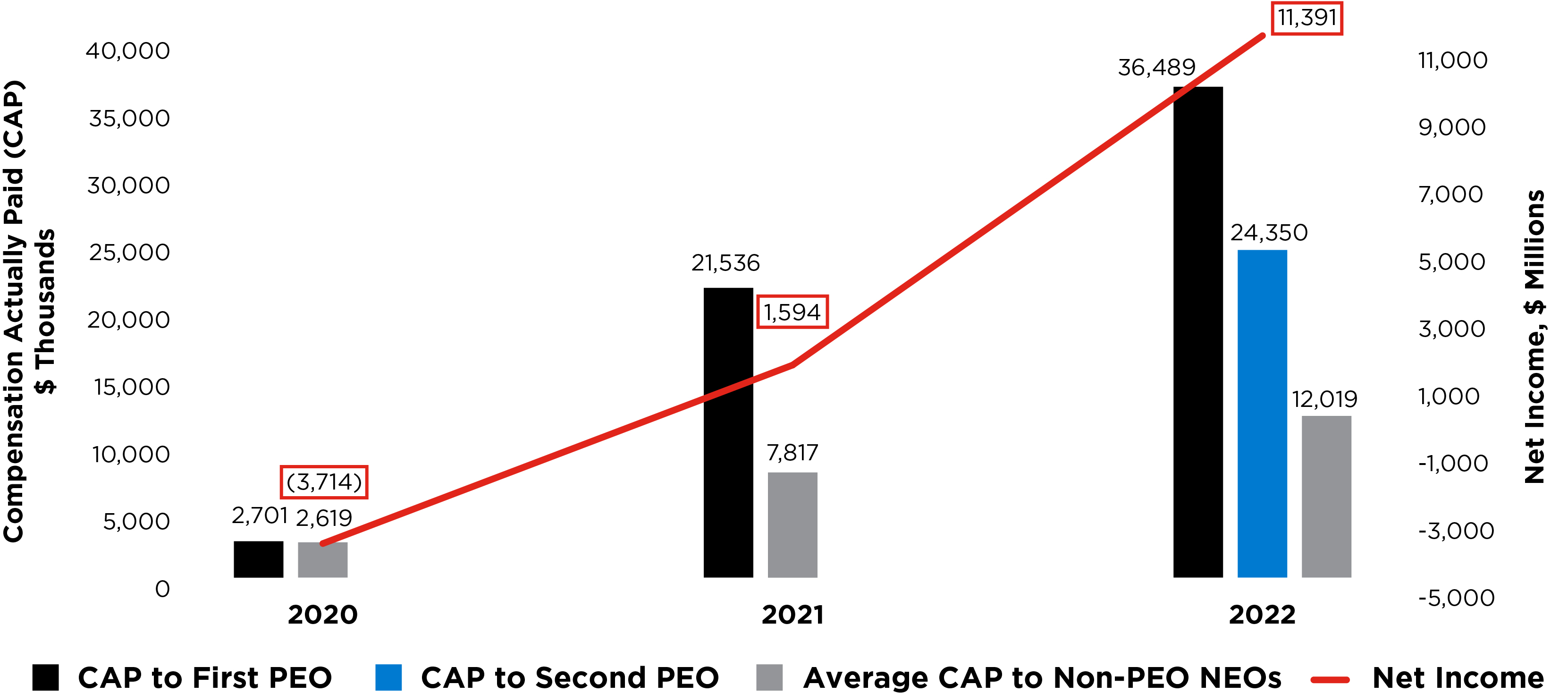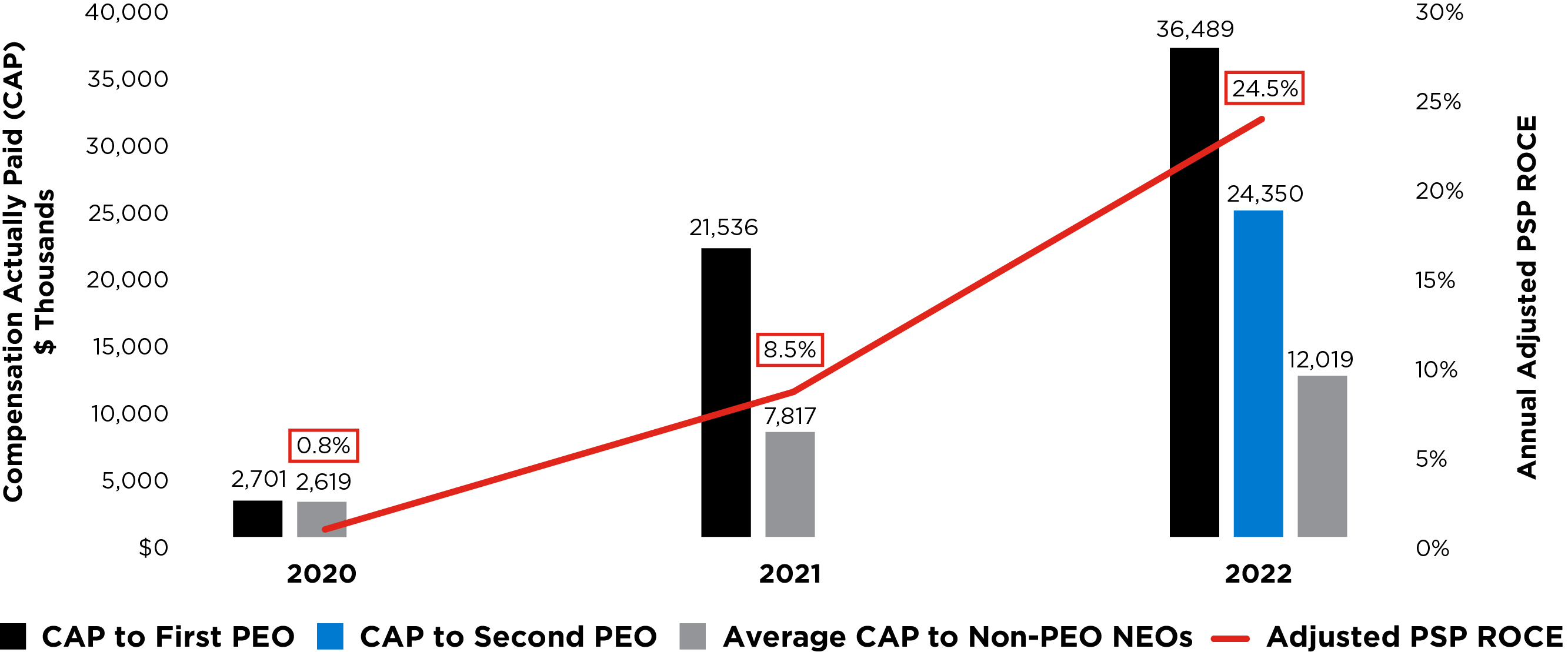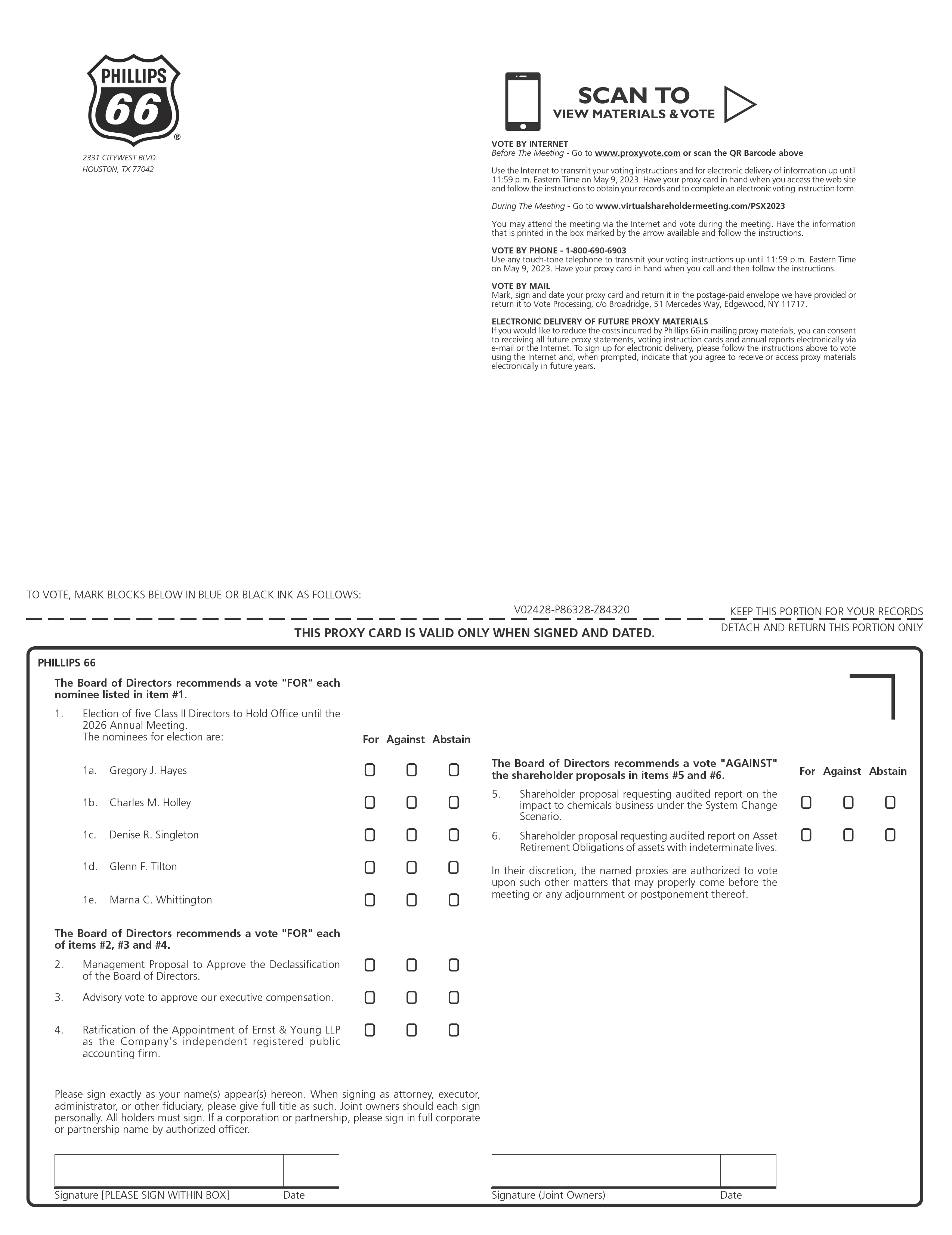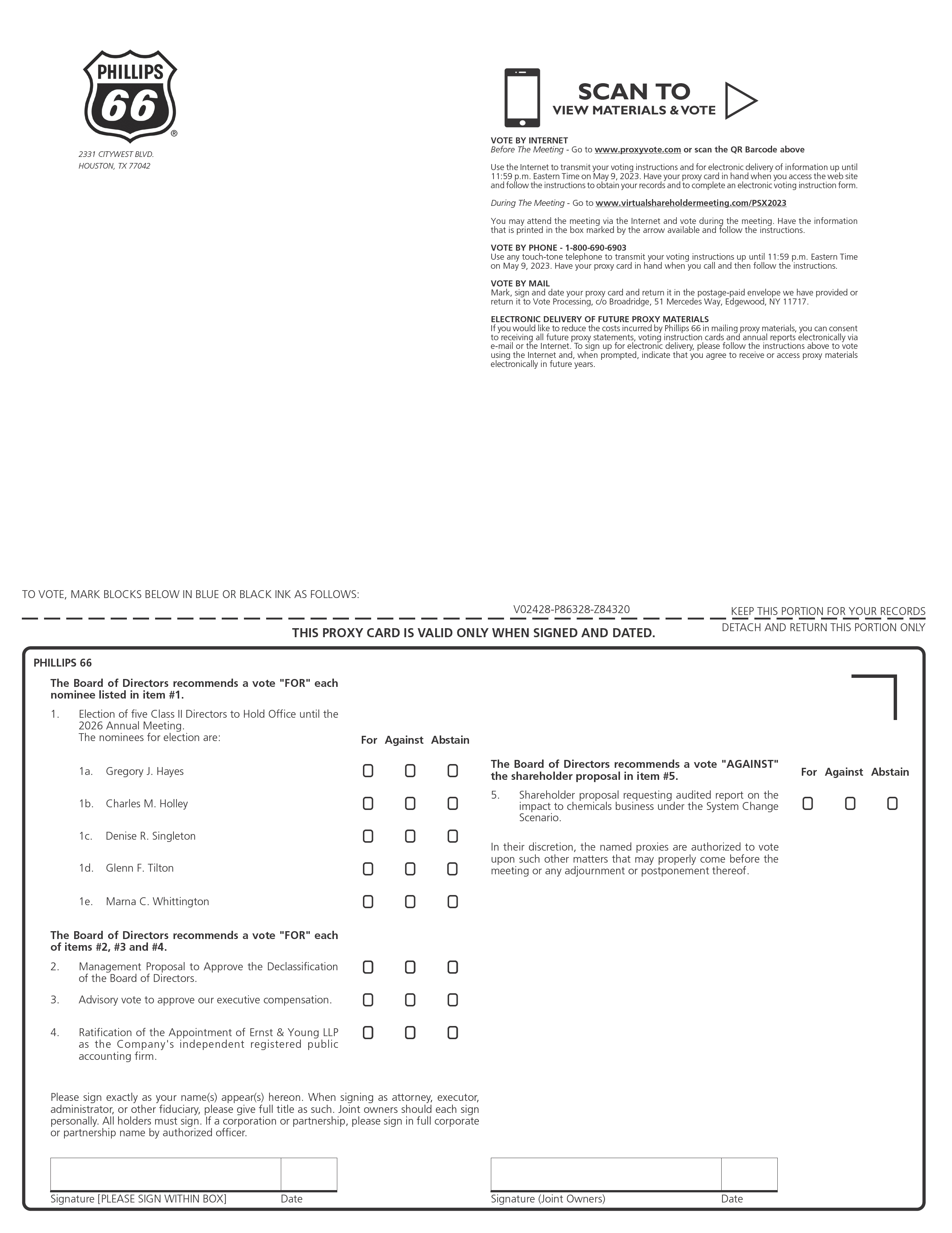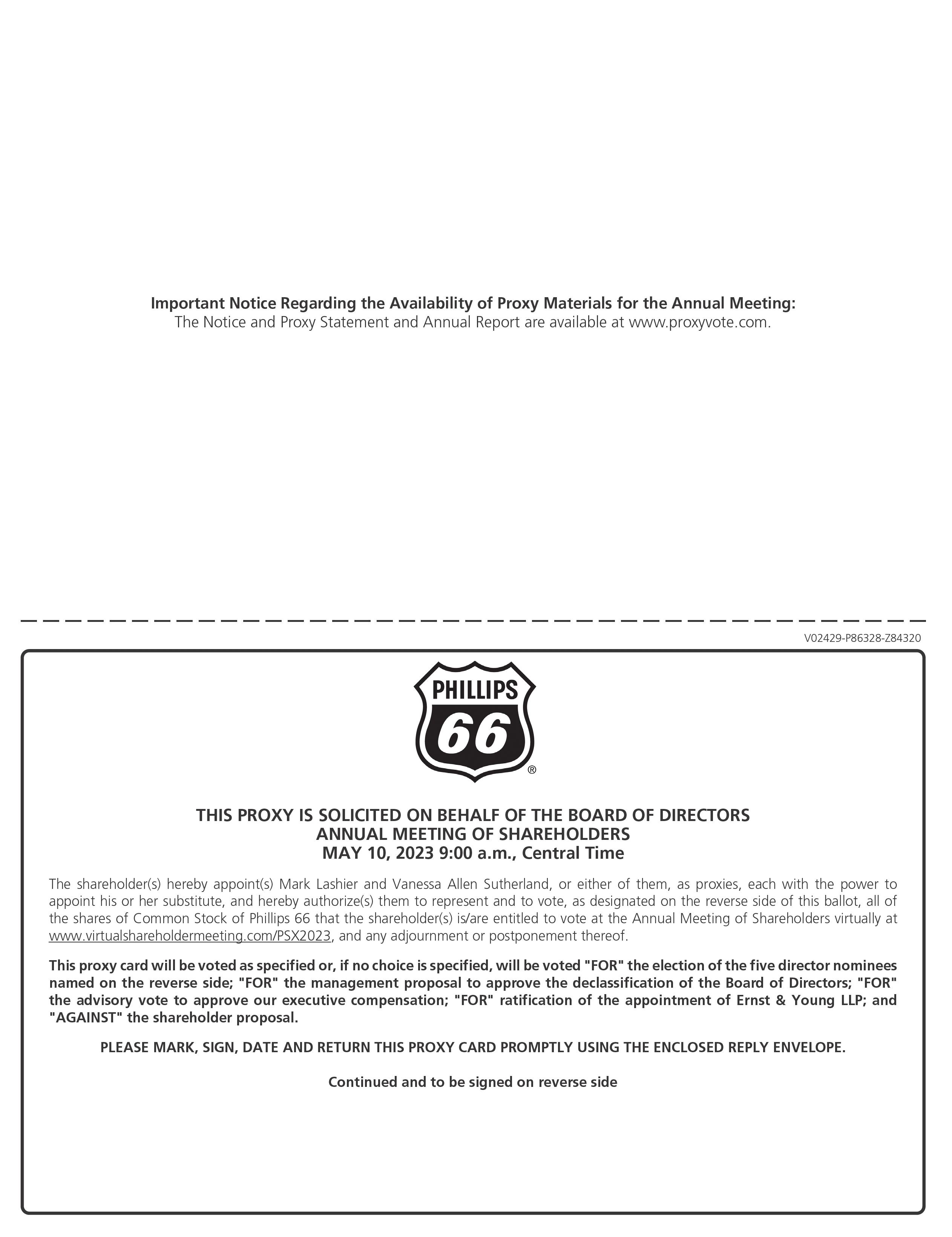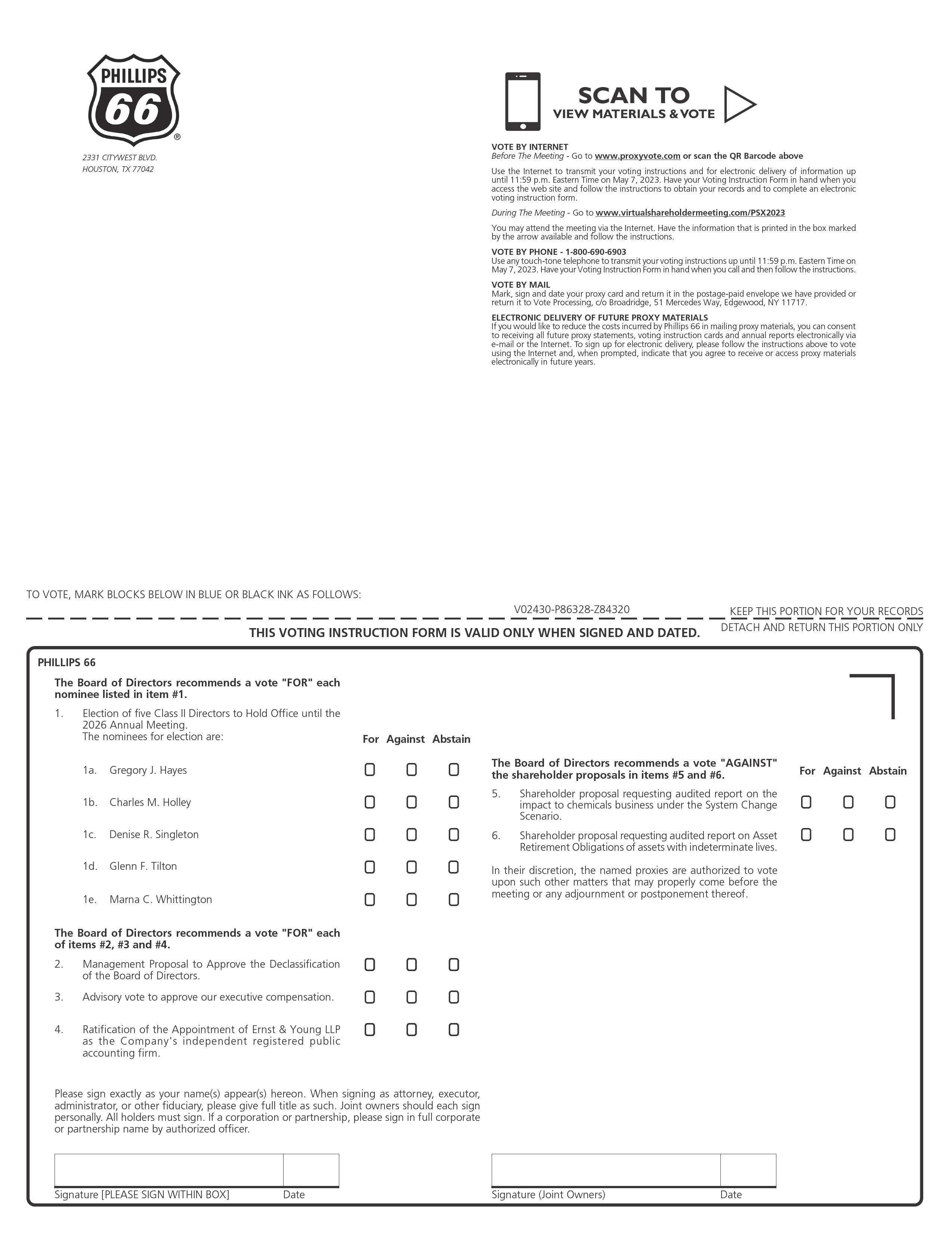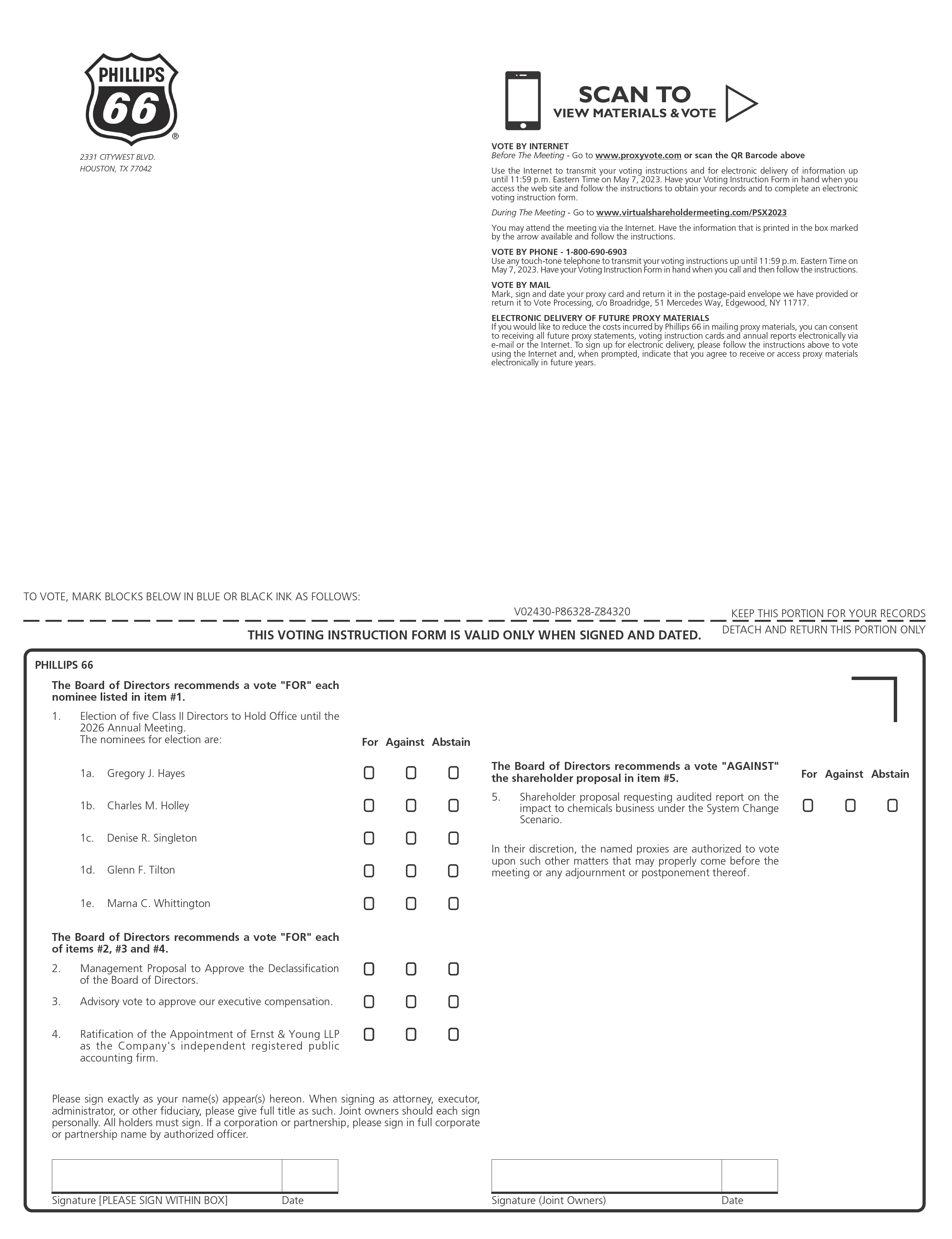UNITED STATES
SECURITIES AND EXCHANGE COMMISSION
Washington, D.C. 20549
SCHEDULE 14A
Proxy Statement Pursuant to Section 14(a) of the
Securities Exchange Act of 1934 (Amendment No. )
| | | | | | | | | | | |
| ☑ | Filed by the Registrant | ☐ | Filed by a party other than the Registrant |
| | | | | |
| CHECK THE APPROPRIATE BOX: |
☑☐ | Preliminary Proxy Statement |
| ☐ | Confidential, for Use of the Commission Only (as permitted by Rule 14a-6(e)(2)) |
☐☑ | Definitive Proxy Statement |
| ☐ | Definitive Additional Materials |
| ☐ | Soliciting Material under §240.14a-12 |
Phillips 66
(Name of Registrant as Specified In Its Charter)
(Name of Person(s) Filing Proxy Statement, if other than the Registrant)
| | | | | |
| PAYMENT OF FILING FEE (CHECK ALL BOXES THAT APPLY): |
| ☑ | No fee required |
| ☐ | Fee paid previously with preliminary materials |
| ☐ | Fee computed on table in exhibit required by Item 25(b) per Exchange Act Rules 14a-6(i)(1) and 0-11 |
At Phillips 66, our people are bonded by our vision of providing energy and improving lives and our core values of safety, honor, and commitment.
Our Energy In Action is how we bring our vision and values to life.
| | | | | | | | | | | | | | | | | | | | | | | | | | | | | | | | | | | |
| | | | | | | | | | | |
| | | | | | | | | | | |
| Work for the greater good. | | Create an environment of trust. | | Seek different perspectives. | | Achieve excellence. |
| | | | | | | | |
| We embrace our values as a common bond. | | We depend on each other to do our jobs. | | We create space for possibilities. | | We challenge ourselves and never settle. |
| | | | | | | | |
| Be a good neighbor and use resources wisely. Prioritize the big picture interests of the company. Work across teams, business units and functions. Hold ourselves accountable for our words, work and actions. | | Build relationships by understanding the experience of others. Provide and welcome real-time feedback. Treat everyone as a contributing team member. Resolve differences quickly and move forward. | | Examine the risks and challenge the status quo. Be open to new ways of thinking. Speak up and share our unique expertise. Listen and make sure everyone is heard. | | Acknowledge and rebound from our mistakes. Embrace change and adapt quickly. Be curious and pursue lifelong learning. Leave things better for the next person. |
| | | | | | | | |
| Don't let self-interest come first. | | Don't say one thing and do another. | | Don't simply accept the "way we have always done things." | | Don't avoid difficult decisions. |
| | | | | | | | |
| Living our values earns us the confidence of our business partners, communities and co-workers. | | Trusting each other makes us more productive and agile. | | Championing inclusion enables us to innovate and thrive. | | Continuing to improve ensures we deliver extraordinary performance. |
| | | | | | | | | | | |
| | | | | | | | | | | |
| | | | | | | | | | | |
| | | | | |
| |
|
| Notice of 2023 Annual Meeting of Shareholders |
| | | | | | | | | | | | | | | | | | | | |
| | VOTING ITEMS |
Date and time Wednesday, May 10, 2023 9:00 a.m. Central Time Place virtualshareholdermeeting.com/PSX2023 Who can vote Shareholders of record at the close of business on March 15, 2023, may vote at the meeting or any postponements or adjournments of the meeting. How to cast your vote: Online before the meeting www.proxyvote.com By phone (800) 690-6903 Proxy card or voting instruction form Complete, sign and return your proxy card. If you are a beneficial owner and received a voting instruction form, please follow the instructions provided by your bank or broker to vote your shares. Online at the meeting You may also vote online during the annual meeting by following the instructions provided on the meeting website during the annual meeting. To vote at the meeting, visit virtualshareholdermeeting.com/PSX2023 | | |
| Proposals | Board Vote Recommendation | For Further Details |
| 1 | Election of five Class II Directors
to hold office until the 2026
Annual Meeting | “FOR” each
director nominee | Page 13 |
| 2 | Management proposal to approve the declassification of our Board of Directors | “FOR” | Page 37 |
| 3 | Approval, on an advisory
basis, of compensation paid to
our named executive officers | “FOR” | Page 38 |
| 4 | Ratification of the appointment
of our independent registered
public accounting firm | “FOR” | Page 85 |
| 5-65 | TwoA shareholder proposals,proposal, if
properly presented | “AGAINST” eachthe proposal | Page 88 |
| |
| Shareholders will also vote on any other business that is properly brought before the meeting. The 2023 Annual Meeting will be held exclusively online at www.virtualshareholdermeeting.com/PSX2023. To join as a shareholder, you must enter the 16-digit control number printed on your proxy card, voting instruction form, Notice of Internet Availability, or legal proxy provided to you by the broker that holds your shares. During the meeting shareholders may ask questions and vote their shares (other than shares held through employee benefit plans, which must be voted prior to the meeting). Other interested parties may join the meeting as a guest, in which case no control number is required. For more information, please see the section entitled ADDITIONAL INFORMATION in this Proxy Statement. We are making the Proxy Statement and the form of proxy first available beginning on March ,30, 2023. For the Board of Directors, |
| | Vanessa Allen Sutherland Executive Vice President, Government Affairs, General Counsel and Corporate Secretary March ,30, 2023 |
| | | | | |
IMPORTANT NOTICE REGARDING THE AVAILABILITY OF PROXY MATERIALS FOR THE SHAREHOLDER MEETING TO BE HELD ON MAY 10, 2023: The Notice of 2023 Annual Meeting of Shareholders, Proxy Statement and Annual Report on Form 10-K for the year ended December 31, 2022 are available at www.proxyvote.com.
TABLE OF CONTENTS
| | | | | | | | |
| |
| |
| |
| |
| |
| |
| Proposal 1: Election of Five Class II Directors to Hold Office until the 2026 Annual Meeting | |
| | |
| |
| |
| |
| Board Composition and Assessment | |
| |
| |
| |
| |
| |
| |
| |
| |
| |
| |
| |
| |
| |
| | |
| | |
| |
| | |
| | |
| |
| | |
| | | | | | | | |
| |
| | |
| |
| | |
| |
| | |
| |
| |
| | |
| | |
| |
| |
| | |
| | |
| | |
| | |
| |
| |
| |
| |
| |
| |
| |
| |
| |
| |
| |
| |
Appendix A: Certificate of Amendment to the Amended and Restated Certificate of Incorporation | |
| | |
| |
CAUTIONARY NOTE & INFORMATION REGARDING FORWARD-LOOKING STATEMENTS
References in this Proxy Statement to materials available on our website are for informational purposes only, and the information available on our website is not a part of, nor incorporated by reference into, this Proxy Statement.
This Proxy Statement includes forward-looking statements within the meaning of the Private Securities Litigation Reform Act of 1995. All statements other than statements of historical or current facts made in this report are forward-looking, including statements regarding our sustainability plans and goals and statements about our future financial performance and business. Forward-looking statements may be identified by the use of words like “plans,” “expects,” “will,” “anticipates,” “believes,” “intends,” “projects,” “targets,” “estimates” or other words of similar meaning. Forward-looking statements are based on certain assumptions and expectations of future events which may not prove accurate or be realized, and involve risks and uncertainties, many of which are beyond Phillips 66’s control. Risks and uncertainties that could cause our actual results to differ significantly from management’s expectations are described in our 2022 Annual Report on Form 10-K. In addition, our sustainability goals are aspirational and may change. Statements regarding our goals are not guarantees or promises of future performance. We undertake no duty to update any forward-looking statement that we may make, whether as a result of new information, future events or otherwise, except as may be required by applicable law.
NON-GAAP FINANCIAL MEASURES
This Proxy Statement contain references to “Adjusted VCIP EBITDA," “Adjusted PSP ROCE,” “net debt-to-capital ratio,” and “Adjusted Controllable Costs.” These are not measures of financial performance under generally accepted accounting principles (GAAP) and may not be defined and calculated by other companies using the same or similar terminology. Please see Appendix B, Non-GAAP Financial Measures, for the reconciliation of these non-GAAP financial measures to their most directly comparable GAAP financial measure.
| | | | | |
2 | Phillips 66 2023 Proxy Statement |
From our Executive Chairman and President and Chief Executive Officer
Dear Fellow Shareholders,
This past year, as the world saw major disruptions in energy supplies, our employees stepped up to provide the products fundamental to human progress, executing on our vision of providing energy and improving lives. In rising to this challenge, Phillips 66 delivered strong operating and financial results. During the year, we returned $3.3 billion to shareholders through dividends and share repurchases, paid down $2.4 billion of debt and increased our year-end cash balance by $3.0 billion. At our Investor Day in November, we outlined the strategic priorities that we believe will best position us to reward you — our shareholders — now and into the future.
•Deliver shareholder returns. In 2022, we announced a target to return between $10 billion to $12 billion to our shareholders through dividends and share repurchases in the period from July 2022 through year-end 2024. To help us achieve our target, the Board increased our share repurchase authorization by $5 billion in November and, in the first quarter of 2023, raised the quarterly dividend for the twelfth time, continuing our trend of delivering a secure, competitive and growing dividend.
•Improve refining performance. We achieved 90% crude capacity utilization in 2022. Looking ahead, we aim to increase market capture and crude capacity availability and meaningfully reduce our operating costs. We will seek these improvements while maintaining our unwavering commitment to safety.
•Capture value from wellhead to market. Through the acquisition of Phillips 66 Partners, LP and our increasing stake in DCP Midstream, LP, we built out our NGL wellhead-to-market strategy, and are well positioned to grow earnings attributable to our shareholders and capture commercial and operating synergies.
•Execute our Business Transformation. In 2022, we launched a Business Transformation to sustainably lower our cost structure, and we captured run-rate savings in excess of $500 million by year-end. Our Business Transformation will better position us to compete and win as energy markets evolve. With a target to deliver $1 billion in run-rate savings by year-end 2023, our organization is challenging the status quo and leveraging technology to improve the ways we work.
•Maintain financial strength and flexibility. We believe that disciplined capital allocation and maintaining a strong balance sheet are fundamental to our success. We are targeting a 25-30% net debt-to-capital ratio and will continue to prioritize our investment grade credit ratings, which enhance our ability to compete long-term.
•Drive disciplined growth and returns. We will selectively pursue growth opportunities that offer high returns. As we evaluate lower-carbon opportunities, we will seek to leverage our core competencies and existing assets. Our Rodeo Renewed refinery conversion is a great example, which achieved final investment decision last year. Upon completion, Rodeo Renewed will be one of the world's largest renewable fuels production facilities.
Last year, we committed to working with our joint venture, Chevron Phillips Chemical Company LLC (CPChem), to enhance its sustainability report to include a discussion of how CPChem tests its plastics portfolio and assesses its strategy under potential future plastics demand scenarios. In August 2022, CPChem released its eleventh sustainability report, Accelerating Change for a Sustainable Future, which includes an analysis of its business model and production profile under three plastic demand outlooks. The report is available on CPChem's website, and described more fully in this Proxy Statement.
Our mission is clear, and we are energized and optimistic about the future as we focus on rewarding you, our shareholders. Thank you for your continued support and investment in Phillips 66.
In safety, honor and commitment,
| | | | | | | | | | | |
| Greg C. Garland Executive Chairman March ,30, 2023 | | Mark E. Lashier President and Chief Executive Officer March ,30, 2023 |
From Our Lead Independent Director
Dear Fellow Shareholders,
The independent directors and I join Greg and Mark in inviting you to attend our 2023 annual meeting of shareholders virtually. As the Board’s Lead Independent Director, I had the opportunity to sit down with many of our shareholders during the year. At these meetings, I learned more about the priorities of our shareholders and I was able to share the Board's perspectives on these topics. I discussed the input that I received in these meetings with the entire Board, which considered these viewpoints in our discussions and decisions.
This past year, many of these conversations touched upon the energy transition and matters of energy security, the Company's sustainability initiatives, greenhouse gas emissions reduction target-setting, and our approach to human capital management matters. You also expressed an interest in learning more about our ongoing director refreshment efforts and governance in the boardroom, including our oversight of the recent CEO transition. This Proxy Statement includes discussion of these matters that I hope you will find informative.
Another recurring topic of interest was the classification of our Board. In response to your feedback, we are asking shareholders again this year to support our proposal to declassify the Board so that our directors will be elected annually beginning in 2026. Your vote is important, so we are offering an incentive this year to encourage you to vote. Phillips 66 will make a $1 charitable donation for every shareholder account that votes. Contributions will be made to Project Lead The Way, a non-profit organization that empowers students to thrive in an evolving world by providing teachers with the training, resources and support they need in classrooms across the United States. Please make your voice heard, and join us in supporting Project Lead The Way.
I encourage you to read this Proxy Statement and our 2022 Annual Report on Form 10-K before you make your voting decisions. I also encourage you to read the Company's latest Sustainability Report, Lobbying Activities Report and Human Capital Management Report that are available to you on the Company's website.
Our Board remains committed to building long-term value in the Company and returning capital to our shareholders. We are also committed to guiding our Company to help address climate change through setting impactful, attainable and measurable emissions reduction targets, and investing in technologies and projects that deliver lower-carbon solutions and high returns.
On behalf of the Board, I join Greg, Mark and the entire executive leadership team in thanking you for choosing to invest in Phillips 66. It is a great pleasure to serve as your Lead Independent Director, and I look forward to hearing from many of you in the coming year.
| | | | | |
| Sincerely, |
Glenn Tilton Lead Independent Director March ,30, 2023 |
| | | | | |
4 | Phillips 66 2023 Proxy Statement |
This summary highlights information contained elsewhere in this Proxy Statement, but does not contain all of the information that you should consider. You should read the entire Proxy Statement before you vote. | | | | | |
| AGENDA ITEMS AND VOTING RECOMMENDATIONS |
|
| | | | | | | | |
| PROPOSAL 1 | Election of 5 Class II Directors to Hold Office until the 2026 Annual Meeting The Board recommends that you vote “FOR” the five Class II director nominees named in this Proxy Statement.  See page 13 See page 13 |
| | | | | | | | |
| PROPOSAL 2 | Management Proposal to Approve the Declassification of the Board of Directors The Board recommends that you vote “FOR” the declassification of the Board of Directors.  See page 37 See page 37 |
| | | | | | | | |
| PROPOSAL 3 | Advisory Approval of Executive Compensation The Board recommends that you vote “FOR” the advisory approval of the compensation of the Company’s named executive officers.  See page 38 See page 38 |
| | | | | | | | |
| PROPOSAL 4 | Ratification of the Appointment of Ernst & Young The Board recommends that you vote “FOR” the proposal to ratify the appointment of Ernst & Young LLP.  See page 85 See page 85 |
| | | | | | | | |
| PROPOSAL 5-65 | TwoA Shareholder Proposals,Proposal, if properly presented
The Board recommends that you vote “AGAINST” each of the shareholder proposals. proposal.  See page 88 See page 88 |
| | |
YOUR VOTE IS IMPORTANT — This year, Phillips 66 will make a $1 charitable donation for every shareholder account that votes. Contributions will be made to Project Lead The Way, a non-profit organization that empowers students to thrive in an evolving world by providing teachers with the training, resources and support they need in classrooms across the United States. |
| | | | | |
| BUSINESS OVERVIEW AND PERFORMANCE HIGHLIGHTS |
|
Phillips 66 manufactures, transports and markets products that drive the global economy. The diversified energy company’s portfolio includes Midstream, Chemicals, Refining, and Marketing and Specialties businesses. At Phillips 66, we provide energy that improves lives and contributes to meeting the world’s growing energy needs. Through our Emerging Energy organization, we also invest in, and research for, solutions supporting a lower-carbon future.
2022 FINANCIAL AND OPERATING RESULTS
In 2022, we delivered strong results while maintaining our focus on achieving operating excellence. At our 2022 Investor Day, our executive leadership team reiterated Phillips 66’s returns-focused strategy and disciplined approach to capital allocation. The 2022 performance highlights shown below underpin our executive compensation. For information regarding how these achievements impacted our executive compensation outcomes, please see Compensation Discussion and Analysis beginning on page 39.
| | | | | |
| |
Achieve Operating Excellence Prioritizing safety, environmental stewardship, sustainability, reliability and cost efficiency while protecting shareholder value •Tied best-ever Tier 1 and 2 process safety event rate •Expanded Greenhouse Gas emissions reduction targets to include a 2050 emissions intensity reduction target for Scope 1 and Scope 2 emissions •Recognized by American Fuel and Petrochemical Manufacturers for exemplary safety performance •Awarded American Petroleum Institute’s large operator Distinguished Pipeline Safety Award for the second consecutive year |
| |
| |
Drive Disciplined Growth Enhancing our portfolio by growing our integrated Midstream and Chemicals businesses, as well as executing our returns-focused lower-carbon strategy •Completed the acquisition of Phillips 66 Partners, LP •Increased ownership and further integrated DCP Midstream to enhance our wellhead-to-market strategy •Reached a final investment decision to convert our San Francisco Refinery into one of the world’s largest renewable fuels production facilities •Reached a final investment decision at CPChem, our 50-50 joint venture, in early 2023 for the construction of two world-scale petrochemical facilities that are expected to be self-funded |
| |
| |
Deliver Shareholder Returns Rewarding shareholders through continued dividend growth and share repurchases •Increased the dividend by 5% in May 2022 and returned $1.8 billion in dividends in 2022 •Resumed share repurchases in the second quarter and repurchased $1.5 billion of shares in 2022 •Announced a $5 billion increase to the share repurchase authorization in November 2022 •Announced a target to return $10 billion to $12 billion to shareholders through dividends and share repurchases between July 2022 and year-end 2024 |
| |
| |
Maintain Financial Strength & Flexibility Maintaining financial strength and disciplined capital allocation strategy to enhance resiliency •Generated $10.8 billion of operating cash flow •Ended the year with a cash balance of $6.1 billion •Paid down $2.4 billion of debt and ended the year with a net-debt-to-capital ratio of 24% •Implemented Business Transformation initiatives to sustainably lower our cost structure, and captured a run-rate savings in excess of $500 million by year-end |
| |
| |
Cultivate a High-Performing Organization Building capability, pursuing excellence, and doing the right thing •Responded to employee feedback by enhancing workplace benefits •Contributed $27 million to support the communities where we operate and donated over $7 million through matching gifts and volunteer grant programs •Logged 88,000 employee volunteer hours •Received six external top employer recognition awards as a great place to work |
| | | | | |
| 6 | Phillips 66 2023 Proxy Statement |
| | | | | |
| SPOTLIGHT ON EMERGING ENERGY |
|
Our Emerging Energy organization is focused on developing a lower-carbon sustainable business platform by leveraging our existing assets and capabilities and advancing investments in new energy technologies. The team collaborates across business units and with experts in Energy Research & Innovation, concentrating on renewable fuels and other complementary energy technologies. Renewable fuels like renewable diesel, sustainable aviation fuel and renewable naphtha are an extension of our current business and will allow us to use existing infrastructure in new ways to meet energy needs. We are pursuing opportunities in batteries, carbon capture, hydrogen and EV charging, which are strategic complements to our core businesses.
| | | | | |
| SPOTLIGHT ON OUR BUSINESS TRANSFORMATION |
|
As part of our commitment to deliver long-term competitiveness and value creation for our shareholders, we began a Business Transformation in 2022 to identify and implement sustainable cost reductions across the enterprise, which we expect to realize by year-end 2023. We are enhancing our digital capabilities, innovating our processes and advancing the ways we work in order to decrease complexities and create efficiencies. The organization design changes that we are implementing are intended to provide us with more resiliency during turbulent times and the ability to maximize value capture in any market conditions.
| | | | | |
$800MM
Cost Reduction Target | Sustainably Transform Our Operating Cost Structure •Working to reduce operating, SG&A and freight costs •Restructuring the organization to optimize our ways of working •Establishing culture of transformation and cost discipline |
| |
| |
$200MM
Lower Sustaining Capital Target | Capital Discipline Supports a Sustainable, Competitive Future •Centralizing project execution to drive greater capital efficiency •Empowering innovation and agility mindset •Realizing portfolio risk optimization |
| |
| | | | | |
| SHAREHOLDER OUTREACH AND ENGAGEMENT |
|
2022 Shareholder Engagement by the Numbers
| | | | | | | | |
| | |
57% of shares outstanding
contacted | 47% of shares outstanding
engaged | 26% of shares outstanding engaged with Lead Independent Director |
| | |
Responding to Annual Meeting Results and Shareholder Feedback
Our shareholder engagement program is year round. At shareholder engagements following the Company's 2022 Annual Meeting, we discussed the Company's responsiveness to a shareholder proposal that requested a report from our 50-50 joint venture, Chevron Phillips Chemical Company ("CPChem"), a manufacturer and marketer of petrochemicals and plastics worldwide. The proposal requested a report describing how CPChem could shift its plastic resin business model from virgin to recycled polymer production as a means of reducing plastic pollution. In August 2022, CPChem released its eleventh annual sustainability report, Accelerating Change for a Sustainable Future, featuring the details of a scenario analysis undertaken by CPChem to test the resilience of its portfolio. During engagement meetings, our shareholders commented favorably on CPChem’s scenario planning efforts and these enhanced disclosures.
For more information on our shareholder engagement program and responsiveness to shareholder concerns, please see Shareholder Outreach and Responsiveness on page 29.
| | | | | |
| CORPORATE GOVERNANCE AND BOARD HIGHLIGHTS |
|
| | | | | | | | |
| Majority voting and resignation policy for directors |
| Shareholder right to proxy access (3% for
3 years, up to 20% of the Board) |
| | |
| | |
| Committed to thoughtful Board refreshment |
| Annual evaluation of CEO by independent directors |
| | |
| | |
Independent director participation in our
shareholder engagement program |
| Clawback policies for incentive compensation |
| | |
| | |
Meaningful director and executive stock
ownership guidelines |
| Commitment to consider director candidates from a
diverse candidate pool |
| | |
| | |
| Annual evaluation of the Board and its committees |
| Policy prohibiting pledging and hedging of
Company stock |
| | |
| | |
Board level oversight of ESG efforts, including
sustainability initiatives, corporate culture and
human capital management |
| Robust Lead Independent Director duties and
regularly scheduled executive sessions of
independent directors |
Demonstrated Commitment to Board Refreshment
Since 2019, the Board has appointed seven new directors to the Board, six of whom are independent, and increased the gender and racial/ethnic diversity of the Board. The Board’s recent refreshment activities have resulted in the Board possessing an average tenure of approximately 5 years. These actions demonstrate the Board’s desire to achieve a diverse and broadly inclusive membership with individuals that collectively possess the skills and experiences that the company will need to succeed now and into the future. To more completely convey our Board's composition, we have included a skills matrix under Board Skills and Experience on page 21.
Active Board Oversight of Strategy and Recent Management Transitions
During the spring and fall, the Board heard directly from our shareholders through the Lead Independent Director's participation in meetings with many of our largest investors. In October, the Board continued its practice of conducting an annual in-depth review of our strategy. Throughout the year, directors interacted with members of management and high potential employees in formal and informal settings and received periodic briefings on topics such as our sustainability program and approach to human capital management. The Board also received updates from internal and third-party experts on matters such as cybersecurity and long-term scenario planning.
The Board also oversaw transitions within management, including the promotion of Mark Lashier to the role of CEO. Of the Company's 12-member executive leadership team, seven members took on new or restructured roles in 2022 and the team added two new external hires. These changes increased the gender and racial diversity of the team and broadened the team's range of experiences, skills and backgrounds to better position the Company for long-term success.
| | | | | |
| 8 | Phillips 66 2023 Proxy Statement |
| | | | | | | | | | | | | | | | | | | | | | | | | | | | | | | | | | | |
| BOARD OVERVIEW | | | | | | | | | | |
| | Director
Since | | | Committee Memberships | | Other
Public
Boards |
| Name and Primary Occupation | Independent | | AFC | HRCC | NGC | PPSC | EC | |
| Class II Directors, Current Nominees |
| Gregory J. Hayes, 62 Chairman and Chief Executive Officer
of Raytheon Technologies | 2022 | | | | | | | | | 1 |
| Charles M. Holley, 66
Former Executive Vice President and
Chief Financial Officer of Walmart Inc. | 2019 | | | | | | | | | 2 |
| Denise R. Singleton, 60
Executive Vice President,
General Counsel and
Secretary of WestRock Company | 2021 | | | | | | | | | 1 |
| Glenn F. Tilton, 74
Former Chairman and Chief Executive
Officer of UAL Corporation | 2012 | | | | | | | | | 2 |
| Marna C. Whittington, 75
Former Chief Executive Officer of
Allianz Global Investors Capital | 2012 | | | | | | | | | 2 |
| Class III Directors, Whose Terms Expire in 2024 |
| Julie L. Bushman, 62
Former Executive Vice President of
International Operations of 3M | 2020 | | | | | | | | | 2 |
| Mark E. Lashier, 61 President and CEO of Phillips 66 | 2022 | | | | | | | | | 0 |
| Lisa A. Davis, 59
Former member of Managing Board
of Siemens AG and CEO for Siemens
Gas and Power | 2020 | | | | | | | | | 3 |
| Douglas T. Terreson, 61
Former Head of Energy Research
at Evercore ISI | 2021 | | | | | | | | | 0 |
| Class I Directors, Whose Terms Expire in 2025 |
| Greg C. Garland, 65
Executive Chairman and Former CEO
of Phillips 66 | 2012 | | | | | | | | | 1 |
| Gary K. Adams, 72
Former Chief Advisor -
Chemicals for IHS Markit | 2016 | | | | | | | | | 0 |
| John E. Lowe, 64
Former Senior Executive Advisor to
Tudor, Pickering, Holt & Co. | 2012 | | | | | | | | | 1 |
| Denise L. Ramos, 66
Former Chief Executive Officer,
President and Director of ITT Inc. | 2016 | | | | | | | | | 2 |
| | | | | | | | | | | |
AFC Audit and Finance | PPSC Public Policy and Sustainability | | Chair |
HRCC Human Resources and Compensation | EC Executive | | Member |
NGC Nominating and Governance | | | |
EXECUTIVE COMPENSATION PROGRAM OVERVIEW
Our executive compensation program is designed to pay for performance. We link compensation to Company performance and use metrics we believe will drive long-term shareholder value and that are aligned with our strategy. The majority of executive compensation is provided in the form of long-term incentives with multi-year performance periods. We align the interests of our executives with our shareholders through equity compensation, and we align all employees' interests with the execution of short-term priorities through our annual cash bonus, the Variable Cash Incentive Program (“VCIP”).
Following extensive outreach with shareholders after our 2021 Annual Meeting, the Human Resources and Compensation Committee (the "Compensation Committee") implemented a series of executive compensation program changes for 2022 that are described in detail in the Compensation and Discussion Analysis section of this Proxy Statement. The Compensation Committee was pleased to see the solid shareholder support for the say-on-pay vote at our 2022 Annual Meeting, which received support from 88% of votes cast.
Elements of the Executive Compensation Program
The key elements of pay under our executive compensation program are described in the table below, which also shows the percentage each pay element comprises of target total direct compensation for 2022 for our current Chief Executive Officer ("CEO") and other named executive officers (“NEOs”).
| | | | | | | | | | | |
| Key Elements of Pay | Delivered via | Performance Drivers(1) and Weightings |
| CEO | Other
NEOs |
| | |
| Base Salary | Cash | •Annual fixed cash compensation to attract and retain NEOs |
| |
| | | |
| | |
| Annual Incentive | Variable Cash Incentive Program (VCIP) | Operational Sustainability 50% |
| | •Safety & Operating Excellence (25%) •Environment (15%) •High-Performing Organization (10%) |
| Financial Sustainability 50% |
•Adjusted VCIP EBITDA (40%) •Adjusted Controllable Costs (10%) |
| | | |
| | | |
| Long-Term Incentives | Performance Share Program (PSP) | •Adjusted PSP ROCE (50%) |
| | •Relative total shareholder return (50%) |
| Stock Option Program | •Long-term stock price appreciation |
| Restricted Stock Unit (RSU) | •Long-term stock price appreciation |
| | | |
(1)Adjusted VCIP EBITDA, Adjusted Controllable Costs and Adjusted PSP ROCE are non-GAAP financial measures. See Appendix B for reconciliations to the nearest GAAP financial measures.
Consistent with our philosophy that executive compensation be linked to Company performance, our NEO's compensation mix ensures that a significant portion of compensation is at risk. More information can be found in the Compensation Discussion and Analysis section of this Proxy Statement.
| | | | | |
| 10 | Phillips 66 2023 Proxy Statement |
SUSTAINABILITY AND CORPORATE RESPONSIBILITY OVERVIEW
Sustainability is integral to our corporate strategy and enhances the resiliency of our portfolio. At Phillips 66, our sustainability programs are focused on financial performance, operating excellence, environmental stewardship, social responsibility and governance. For information regarding how our Board oversees sustainability matters, see pages 31-32 of this Proxy Statement.
The VCIP opportunity for our executive officers includes an environmental performance component (currently weighted at 15% of target), and a review of our high-performing organization (currently weighted at 10% of target), which is how we incorporate our sustainability and corporate responsibility performance into our executive compensation program. For more information on our VCIP, see pages 53-57 of this Proxy Statement.
Highlights of our commitments in action during 2022 included:
| | | | | |
| |
Sustainability and
Transition to Lower-
Carbon Future | •Reached a final investment decision on Rodeo Renewed, which will convert our San Francisco refinery into one of the world's largest renewable fuels production facilities. •Continued to conduct research on energies of the future, including renewable fuels and current and next generation batteries at our Bartlesville Innovation Center. •Announced a 2050 GHG emissions intensity reduction target to further reduce Scope 1 and Scope 2 emissions intensity by 50%, as compared to 2019 levels. •Leveraged existing infrastructure, digital investments, supply networks and capabilities to participate in lower-carbon opportunities. |
| |
Community Involvement
and Engagement | •Helped students prepare for the workforce by contributing $9.6 million to education and literacy programs supporting 16 local schools and school districts, 29 colleges and universities and 196 scholarship recipients. •Supported community safety and preparedness by donating $3.9 million, including $1.3 million in disaster relief, supporting 40 local emergency responder departments and 9 food banks. •Contributed $3.1 million supporting environmental and sustainability programs at 27 community parks and 26 conservation projects. •Donated $3 million toward civic enrichment through 9 United Way campaigns and 11 inclusion and diversity programs. |
| |
Political and
Lobbying Activities | •Received “Trendsetter” ranking by the 2022 CPA-Zicklin Index of Corporate Political Disclosure and Accountability. This is the second consecutive year we have received this recognition for the transparency and accountability of our corporate political spending. •Continued participating in the political process to educate policymakers and stakeholders in support of laws and regulations that meet societal and business needs while promoting federal, state and local economies. |
STAKEHOLDER ENGAGEMENT
Ongoing engagement with all of our stakeholders is important to us. Our stakeholders include employees, shareholders, customers, the communities where we operate, indigenous people, legislators, financial institutions, and energy consumers. We approach our stakeholder engagement from a position of mutual respect, respecting human rights, demonstrating our values through our actions and being a good neighbor. We conduct our operations in accordance with our Company values and policies, and consistent with the spirit of the United Nations’ Universal Declaration of Human Rights.
COMMUNITY INVOLVEMENT AND ENGAGEMENT
We are committed to creating value for our communities through economic development, philanthropy, volunteerism and advocacy, and by operating our business in a socially and environmentally responsible way. The communities in which our assets are located and where our employees live are critical stakeholders. We consistently and regularly engage with our local communities and seek their feedback. Our refining operations have community advisory councils or panels that include both Company representatives and community members. Many panels include adjacent operations from our midstream and lubricants businesses. These panels meet at least quarterly with refinery management to provide feedback, discuss topics of local concern and share insights on plans and activities. Our pipeline business units have year-round community awareness, education and listening panels to stay connected with those involved with and living near our extensive pipeline network.
| | | | | |
| SPOTLIGHT ON OUR GHG EMISSIONS REDUCTION TARGETS |
|
Phillips 66 supports the ambitions of the Paris Agreement and is active in the energy transition while continuing to provide affordable, reliable, and abundant energy that drives human progress. In 2021, we set impactful and measurable targets to reduce the GHG emissions intensity of its operations and energy products. By 2030, we plan to reduce the Scope 1 and Scope 2 emissions intensity of our operations by 30% and the Scope 3 emissions intensity of our energy products by 15%, as measured against 2019 levels. In 2022, we announced a 2050 GHG emissions intensity target to further reduce Scope 1 and Scope 2 emissions intensity by 50%, as measured against 2019 levels.
We expect that we can achieve our 2030 targets with projects currently underway and projects that are planned or under development consistent with our disciplined approach to capital allocation and focus on returns. Meeting our 2050 target will require changes beyond our sphere of influence and control, such as advancements enabling broader commercialization of lower-carbon technologies, global policies to fund and incentivize the lower-carbon energy system, changes in consumer behavior and available materials throughout the supply chain. Further details regarding our GHG emissions reduction targets and the projects planned and in development to achieve these targets can be found in our Sustainability Report available on our website.
| | | | | | | | | | | | | | |
30% ↓ | | 15% ↓ | | 50% ↓ |
| | | | |
| | | | |
Manufacturing-related emissions intensity
Scope 1 and 2 from operated assets by 2030 | | Products manufactured and sold emissions intensity
Scope 3 from operated assets by 2030 | | Manufacturing-related emissions intensity
Scope 1 and 2 from operated assets by 2050 |
| | | | | |
| 12 | Phillips 66 2023 Proxy Statement |
| | | | | |
PROPOSAL 1 | Election of 5 Class II Directors to hold office until the 2026 Annual Meeting The Board recommends that you vote “FOR” the election of the five Class II director nominees. |
Our Board is currently composed of 13 members. In accordance with our Certificate of Incorporation, as currently in effect, our Board is divided into three classes of directors. At the 2023 Annual Meeting, we are seeking shareholder approval to declassify our Board of directors, as described in “Proposal 2: Management Proposal to Approve the Declassification of the Board of Directors.” If that proposal receives sufficient shareholder support, starting in 2024, directors will stand for one-year terms and the full Board will stand for annual election starting in 2026.
The Board has nominated Gregory J. Hayes, Charles M. Holley, Denise R. Singleton, Glenn F. Tilton and Marna C. Whittington to stand for election as Class II directors for a three-year term that expires at the annual meeting of shareholders held in 2026 or until such director’s successor has been duly elected or appointed and qualified, or until their earlier resignation or removal. Each nominee requires the affirmative vote of a majority of the votes cast in person or by proxy at the meeting. Each director nominee has consented to serving as a director if elected and the Board expects that the five nominees will be available to serve as directors. However, if a nominee is unavailable for election, proxy holders may vote for another nominee proposed by the Board or the Board may reduce the number of directors to be elected at the Annual Meeting. No family relationship exists among any of our directors, director nominees or executive officers. There is no arrangement between any director or director nominee and any other person pursuant to which he or she was, or is to be, selected as a director or director nominee.
The business experience, core skills and qualifications of each director nominee and continuing director are set forth below. Further skills and qualifications considered in evaluating director nominees and Board composition as a whole are described in Board Skills and Experience beginning on page 21.
| | | | | | | | | | | | | | | | | |
| | | | | |
| C-Suite Experience | | Financial | | Global Business |
| C-suite experience provides valuable insights and practical understanding of companies, and the methods to drive change and growth within an organization | Finance and financial reporting experience provide knowledge necessary to evaluate our performance by reference to financial targets and to oversee financial reporting | Global business or international experience provides valuable perspectives on our operations and enables the oversight of our strategic initiatives |
| | |
| | |
| Risk Management | | Environmental | | Industry Experience |
| Experience in managing risk ensures capabilities necessary for risk oversight responsibilities, bringing background and experience that increase directors’ effectiveness | Experience in environmental regulation helps in effective evaluation and oversight of our strategy to provide energy and improve lives while ensuring a healthy and safe environment | Energy experience brings pertinent background and knowledge to provide perspective on issues specific to the Company’s industry, business, operations and strategy |
| | |
CLASS II DIRECTOR NOMINEES STANDING FOR ELECTION
| | | | | | | | | | | | | | | | | | | | |
Age: 62 Director since: 2022 Committees: Compensation; Nominating and Governance; Public Policy and Sustainability | Career Highlights: •Chairman and Chief Executive Officer, Raytheon Technologies Corporation (since June 2021) •Former President, Chief Executive Officer and Director, Raytheon Technologies Corporation (April 2020 to June 2021) •Former Chairman and Chief Executive Officer, United Technologies Corporation (2016 to April 2020) •Former director of Nucor Corporation (2014 to 2018) Experience and Key Skills: Mr. Hayes is the chairman and chief executive officer of Raytheon Technologies Corporation, responsible for leading an aerospace and defense company of 174,000 employees and $64 billion in annual sales. During his career, Mr. Hayes has held senior leadership roles across finance, corporate strategy and business development. Mr. Hayes brings substantial experience in executive leadership, finance, strategic planning, mergers and acquisitions, business development, and global operations and management to the Board. |
| | | | | |
C-Suite Experience | Financial | Global
Business | Risk
Management |
| |
| | | | | |
Other Current Public Company Directorships: •Raytheon Technologies Corporation |
| | | | | | |
| | | | | | | | | | | | | | | | | | | | |
Age: 66 Director since: 2019 Committees: Audit; Public Policy and Sustainability | Career Highlights: •Former Executive Vice President and Chief Financial Officer of Walmart Inc. (2010 to 2015) Experience and Key Skills: Mr. Holley served as Executive Vice President and Chief Financial Officer at one of the largest U.S. corporations, providing him with expertise in finance, senior management, risk and asset management, strategic planning and capital markets. From 2016 to 2019, Mr. Holley served as an independent senior advisor, U.S. CFO Program, Deloitte LLP. He also has extensive experience in international operations and technology platforms. |
| | | | | |
C-Suite Experience | Financial | Global
Business | Risk
Management |
| |
| | | | | |
Other Current Public Company Directorships: •Amgen •Carrier Global |
| | | | | | |
| | | | | |
| 14 | Phillips 66 2023 Proxy Statement |
| | | | | | | | | | | | | | | | | | | | |
Age: 60 Director since: 2021 Committees: Audit; Public Policy and Sustainability | Career Highlights: •Executive Vice President, General Counsel and Secretary of WestRock Company (since March 2022) •Former Senior Vice President, General Counsel and Corporate Secretary of IDEX Corporation (2015 to March 2022) Experience and Key Skills: Ms. Singleton was named Executive Vice President, General Counsel and Secretary of WestRock Company in March 2022. Ms. Singleton has extensive legal and corporate governance experience. Previously, she was Senior Vice President, General Counsel and Corporate Secretary of IDEX Corporation, a position she held from 2015 to 2022. Prior to joining IDEX, Ms. Singleton served as Senior Vice President, General Counsel, Corporate Secretary and Chief Compliance Officer at SunCoke Energy, Inc. and its controlled company SunCoke Energy Partners, L.P., where she was on the board of directors, from 2011 to 2015. Prior to joining SunCoke Energy, Ms. Singleton held several positions at PPG Industries, Inc., and was a partner at Shaw Pittman LLP, a law firm. |
| | | | | |
C-Suite
Experience | Financial | Global
Business | Risk
Management | Environmental | |
| | | | | |
Other Current Public Company Directorships: •Teledyne Technologies Incorporated |
| | | | | | |
| | | | | | | | | | | | | | | | | | | | |
Age: 74 Director since: 2012 Committees:
Compensation; Nominating and Governance (Chair); Public Policy and Sustainability; Executive | Career Highlights: •Former Chairman of the Midwest, JPMorgan Chase (2011 to 2014) •Former Non-Executive Chairman, United Continental Holdings (2010 to 2012) •Former Chairman and Chief Executive Officer of UAL Corporation (2002 to 2010) Experience and Key Skills: Mr. Tilton previously served as chairman and chief executive officer of UAL Corporation, the parent company of United Air Lines, as well as chairman of the Midwest of JPMorgan Chase & Co. Mr. Tilton’s career has provided him with strong management experience overseeing complex multinational businesses operating in highly regulated industries as well as expertise in finance and capital markets matters. He also has extensive experience in the energy industry through his more than 30 years in increasingly senior roles with Texaco Inc., including chairman and chief executive officer. |
| | | | | |
C-Suite
Experience | Financial | Global
Business | Risk
Management | Environmental | Industry
Experience |
| | | | | |
Other Current Public Company Directorships: •Abbott Laboratories •AbbVie Inc. |
| |
| | | | | |
| Proposal 1: Election of Directors | 15 |
| | | | | | | | | | | | | | | | | | | | |
Age: 75 Director since: 2012 Committees:
Compensation (Chair);
Nominating and Governance;
Public Policy and
Sustainability;
Executive | Career Highlights: •Former Chief Executive Officer of Allianz Global Investors Capital (2002 to 2012) •Former director of Macy's Inc. (1993 to 2022) Experience and Key Skills: Dr. Whittington has many years of leadership experience and expertise as a former senior executive in the investment management industry, including as chief executive officer of Allianz Global Investors Capital. She has extensive knowledge of and substantial experience in management, and in financial, investment and banking matters and provides valuable insight from her previous experience serving as a public company board member. |
| | | | | |
C-Suite
Experience | Financial | Global
Business | Risk
Management | Industry
Experience | |
| | | | | |
Other Current Public Company Directorships: •Oaktree Capital Group LLC •Ocugen Inc. |
| |
CONTINUING DIRECTORS
| | | | | | | | | | | | | | | | | | | | |
Age: 72 Director since: 2016 Committees: Compensation; Public Policy and Sustainability | Career Highlights: •Former Chief Advisor — Chemicals for IHS Markit (2011 to 2017) •Former director of Westlake Chemical Partners LP (2014 to 2016) •Former director of Phillips 66 Partners LP (2013 to 2016) •Former director of Trecora Resources (2012 to 2022) Experience and Key Skills: Mr. Adams has over 40 years of experience in the petrochemicals and plastics industries, including 15 years at Union Carbide, where he began his career. Through various management positions, including as president, chief executive officer and chairman of Chemical Markets Associates Inc. (“CMAI”) before its acquisition by IHS, Mr. Adams also has leadership experience with operating responsibilities, and financial and risk oversight for a global business. |
| | | | | |
C-Suite
Experience | Financial | Global
Business | Risk
Management | Industry
Experience | |
| | | | | |
| |
| | | | | |
| 16 | Phillips 66 2023 Proxy Statement |
| | | | | | | | | | | | | | | | | | | | |
Age: 62 Director since: 2020 Committees: Audit; Public Policy and Sustainability | Career Highlights: •Former Executive Vice President of International Operations of 3M (2017 to 2020) and Senior Vice President of Business Transformation and Information Technology of 3M (2013 to 2017) •Former director of Johnson Controls (2012 to 2016) Experience and Key Skills: As a former executive of 3M, Ms. Bushman brings executive management experience, as well as experience in international business, risk management and financial oversight to the Board. Ms. Bushman also brings environmental experience through her roles leading occupational health and environmental safety divisions at 3M. |
| | | | | |
C-Suite
Experience | Financial | Global
Business | Risk
Management | Environmental | |
| | | | | |
Other Current Public Company Directorships: •Adient plc •Bio-Techne Corporation |
| | | | | | |
| | | | | | | | | | | | | | | | | | | | |
Age: 59 Director since: 2020 Committees: Compensation; Public Policy and Sustainability | Career Highlights: •Former member of Managing Board of Siemens AG and CEO for Siemens Gas and Power (2014 to 2020) •Former director of Kosmos Energy (2019 to 2022) Experience and Key Skills: Ms. Davis brings significant industry experience to the Board through her roles at Siemens, as well as over 25 years in engineering and management roles at large integrated oil companies including ExxonMobil, Texaco and Shell, including executive vice president strategy and portfolio at Shell. |
| | | | | |
C-Suite
Experience | Financial | Global
Business | Risk
Management | Industry
Experience | |
| | | | | |
Other Current Public Company Directorships: •Air Products and Chemicals •Penske Automotive Group •C3.ai |
| | | | | | |
| | | | | |
| Proposal 1: Election of Directors | 17 |
| | | | | | | | | | | | | | | | | | | | |
Age: 65 Director since: 2012 Committees:
Executive (Chair) | Career Highlights: •Executive Chairman of Phillips 66 (July 2022 to present) •Former President, Chief Executive Officer and Chairman of Phillips 66 (2012 to July 2022) Experience and Key Skills: Mr. Garland brings extensive knowledge of all aspects of our business and industry to the Board, having served as our president and chief executive officer from 2012 to July 2022, in executive positions at ConocoPhillips, as president and chief executive officer of Chevron Phillips Chemical Company, and as the chairman and chief executive officer of Phillips 66 Partners. Through his more than 35 years of service and experience in the energy industry, Mr. Garland brings to the Board each of the key skills we seek in a director. |
| | | | | |
C-Suite
Experience | Financial | Global
Business | Risk
Management | Environmental
| Industry
Experience |
| | | | | |
Other Current Public Company Directorships: •Amgen |
| |
| | | | | | |
| | | | | | | | | | | | | | | | | | | | |
Age: 61 Director since: 2022 Committees: Executive | Career Highlights: •President and Chief Executive Officer of Phillips 66 (since July 2022) •President and Chief Operating Officer of Phillips 66 (2021 to 2022) •President and Chief Executive Officer of ChervonChevron Phillips Chemical Company LLC (2017 to 2021) Experience and Key Skills: Mr. Lashier brings extensive knowledge of our business and industry to the Board, as he serves as our President and Chief Executive Officer and has previously served as president and chief executive officer of Chevron Phillips Chemical Company (CPChem). Prior to that, he held several leadership positions at CPChem, including Executive Vice President of Olefins and Polyolefins; Senior Vice President of Specialties, Aromatics and Styrenics; Vice President of Corporate Planning and Development; Project Director for Saudi Arabia; and Regional Manager in Asia. Mr. Lashier began his career at Phillips Petroleum in 1989 as an Associate Research Engineer. |
| | | | | |
C-Suite
Experience | Financial | Global
Business | Risk
Management | Industry
Experience | |
| | | | | |
| | | | | |
| 18 | Phillips 66 2023 Proxy Statement |
| | | | | | | | | | | | | | | | | | | | |
Age: 64 Director since: 2012 Committees: Audit (Chair); Nominating and Governance; Public Policy and Sustainability; Executive | Career Highlights: •Former Senior Executive Advisor to Tudor, Pickering, Holt & Co.
(2012 to 2022) •Former director of APA Corporation (2013 to 2022) and non-executive Chairman (2015 to 2022) •Former director of Agrium Inc. (2010 to 2015) Experience and Key Skills: Mr. Lowe had a 30-year career with ConocoPhillips and Phillips Petroleum Company, including several executive positions with ConocoPhillips, providing him extensive industry experience. Mr. Lowe also has financial and risk oversight, international and environmental experience through the series of executive positions he has held and his service on the boards of publicly traded oil and gas and energy companies. |
| | | | | |
C-Suite
Experience | Financial | Global
Business | Risk
Management | Environmental
| Industry
Experience |
| | | | | |
Other Current Public Company Directorships: •TC Energy |
| | | | | | |
| | | | | | | | | | | | | | | | | | | | |
Age: 66 Director since: 2016 Committees: Audit; Nominating and Governance; Public Policy and Sustainability (Chair); Executive | Career Highlights: •Former Chief Executive Officer, President and director of ITT Inc. (2011 to 2018) •Former director of Praxair, Inc. (2014 to 2016) Experience and Key Skills: Ms. Ramos has experience in the oil and gas industry, including more than 20 years in various finance positions at Atlantic Richfield Company. Having also served as CEO of ITT and chief financial officer at ITT as well as Furniture Brands International and Yum! Brands, Ms. Ramos brings extensive senior leadership, risk management and global business expertise to the Board. |
| | | | | |
C-Suite
Experience | Financial | Global
Business | Risk
Management | Environmental
| Industry
Experience |
| | | | | |
Other Current Public Company Directorships: •Bank of America •Raytheon Technologies |
| | | | | | |
| | | | | |
| Proposal 1: Election of Directors | 19 |
| | | | | | | | | | | | | | | | | | | | |
Age: 61 Director since: 2021 Committees: Compensation; Public Policy and Sustainability | Career Highlights: •Former Head of Energy Research at Evercore ISI (2016 to 2021) Experience and Key Skills: Mr. Terreson is a former Senior Advisor at Evercore, a position he held from April 2021 through July 2021. He previously served as the Head of Global Energy at Evercore ISI, from 2016 until April 2021. Mr. Terreson joined International Strategy & Investment Group (ISI), which was acquired by Evercore in 2014, in 2009, after 15 years at Morgan Stanley, where he managed the Global Energy Group. Prior to that, he managed Putnam Investments’ energy mutual fund. Mr. Terreson began his career as an engineer with Schlumberger Limited. |
| | | | | |
Financial | Global
Business | Risk
Management | Industry
Experience | | |
| | | | | |
| | | | | |
| 20 | Phillips 66 2023 Proxy Statement |
BOARD SKILLS AND EXPERIENCE
Throughout the year, the Board continued its proactive assessment of board succession planning and refreshment. The Nominating and Governance Committee and full Board work to ensure we maintain a Board that embodies a broad and diverse set of experiences, qualifications, attributes and skills to provide effective oversight of management and the Company. When seeking new candidates, the Board considers a diverse pool of qualified candidates who could potentially serve as Board members. We view diversity in terms of skills, as well as gender, age, race, ethnicity, background, professional experience and perspectives.
As the needs of the Company change, the Board revisits the skills and experiences it seeks. Included in the matrix below are the core skills the Board seeks in director candidates, as well as additional competencies and experiences the Board currently prioritizes in evaluating director nominees.
| | | | | | | | | | | | | | | | | | | | | | | | | | | | | | | | | | | | | | | | | |
| | | | | | | | | | | | | |
| | | | | | | | | | | | | |
Age(1) | 72 | 62 | 59 | 65 | 62 | 66 | 61 | 64 | 66 | 60 | 61 | 74 | 75 |
| Tenure | 7 | 3 | 3 | 11 | 1 | 4 | 1 | 11 | 7 | 2 | 2 | 11 | 11 |
| Gender | M | F | F | M | M | M | M | M | F | F | M | M | F |
| Independence | | | | | | | | | | | | | |
| Other Public Company Boards | 0 | 2 | 3 | 1 | 1 | 2 | 0 | 1 | 2 | 1 | 0 | 2 | 2 |
| C-Suite Experience | | | | | | | | | | | | | |
| Financial Experience | | | | | | | | | | | | | |
| International/Global Business | | | | | | | | | | | | | |
| Risk Management | | | | | | | | | | | | | |
| Environmental | | | | | | | | | | | | | |
| Industry | | | | | | | | | | | | | |
| Energy | | | | | | | | | | | | | |
| Pipeline/Transportation/Logistics | | | | | | | | | | | | | |
| Refining | | | | | | | | | | | | | |
| Chemicals | | | | | | | | | | | | | |
| Midstream | | | | | | | | | | | | | |
| Information Technology | | | | | | | | | | | | | |
| Business Transformation | | | | | | | | | | | | | |
| Investment Banking/Finance | | | | | | | | | | | | | |
| Public Affairs | | | | | | | | | | | | | |
| Government Affairs | | | | | | | | | | | | | |
(1) As of March 15, 2023.
| | | | | |
| Proposal 1: Election of Directors | 21 |
BOARD COMPOSITION AND ASSESSMENT
Composition of the Board
The Board strives to maintain an appropriate balance of tenure, turnover, diversity, skills and experience. Our average director tenure is approximately 5 years, representing an appropriate balance of tenures. The average age of our directors is approximately 65.
After careful deliberation, the Board recently removed the retirement age guideline from the Company's Corporate Governance Guidelines. The Board's current Corporate Governance Guidelines do not impose director term limits or mandate a retirement age. The Board believes that directors may continue to provide meaningful, independent oversight and advice past an arbitrary age limit. A mandatory retirement age comes with the disadvantage of losing the contribution of directors who have developed significant knowledge of the Company’s business, strategy, risk profile, operations and financial position and who remain active and contributing members of the Board. The Board also determined that a mandatory retirement age may inhibit the Board’s ability to maintain a balanced mix of shorter- and longer-tenured directors, which is necessary for the Board to maintain a mix of fresh perspectives and a deep understanding of the Company.
Annual Board Assessment
The Board ensures its continued effectiveness through its self-assessment and nomination processes. These processes have resulted in the board's recent refreshment efforts.
•The Nominating and Governance Committee annually reviews the qualifications it prioritizes for director recruitment and director nomination to ensure that these qualifications reflect the evolving needs of the Company. During 2022, the Nominating and Governance Committee retained a third-party search firm to assist it in the process of identifying and evaluating potential director candidates.
•The Nominating and Governance Committee annually reviews each director nominee’s continuation on the Board, taking into account their contributions, qualifications and outside time commitments, and the composition of the Board as a whole, and makes recommendations to the full Board.
In addition, the Corporate Governance Guidelines provide that any director whose principal outside responsibilities have changed since election to the Board should volunteer to resign to give the Board the opportunity to review the appropriateness of continued Board membership under the circumstances.
| | | | | |
| 2022 Board Self Assessment |
| |
| Oversight of annual evaluation process | Each committee of the Board performed an annual self-assessment, and the Nominating and Governance Committee and Lead Independent Director oversaw an annual self-assessment of the full Board. |
| |
| |
| Survey and one-on-one discussions | The self-assessment included an evaluation survey, which provided an opportunity for candid feedback on the Board's performance, followed by one-on-one conversations between the Lead Independent Director and each other director. During these conversations, the Lead Independent Director sought input on the effectiveness of the Board, its committees, and the individual directors, among other topics. |
| |
| |
| Presentation and discussion of results | A summary of the results of each committee’s self-assessment was presented to the Committee and discussed in executive session. The Lead Independent Director presented a summary of the results of the Board evaluation to the Nominating and Governance Committee and to the Board in executive session. |
| |
| |
| Incorporation of feedback | Any matters requiring further action that may enhance the Board's performance are identified and action plans developed to address the matter. |
| |
| | | | | |
| 22 | Phillips 66 2023 Proxy Statement |
Recent Board Refreshment
In 2022, the Board appointed Mark Lashier and Gregory Hayes to the Board. Mr. Lashier’s board appointment was in connection with his promotion to the position of chief executive officer, and he brings significant knowledge of the Company’s operations to the Board. Mr. Hayes brings significant c-suite, financial, global business, information technology, regulatory, risk management and environmental experience to the Board.
These appointments were informed by the Board’s continued focus on its composition, as well as insights provided through the Board’s annual self-evaluation process. Our current board composition provides a diversity of thought and a broad range of skills and perspectives aligned with our strategy.
| | | | | |
| |
| Board changes since 2019: | |
| |
•Seven new highly-skilled directors have joined the Board, six of whom are independent •Increased gender and racial/ethnic diversity of the Board •Enhanced the skill set of the Board by adding directors with skills critical to supporting our strategy, including skills in industry, information technology, environmental, finance, and government affairs |
| |
Identification and Consideration of New Nominees
The Board is responsible for nominating directors and filling vacancies that may occur between annual meetings, based upon the recommendation of the Nominating and Governance Committee. The Nominating and Governance Committee process for identifying and recommending candidates includes:
| | | | | |
| |
| 1 Review | The Nominating and Governance Committee considers the Company’s current and long-term needs and strategic plans to determine the skills, experience and characteristics that may enhance the Board's composition and effectiveness. |
| |
| |
| 2 Identify | The Nominating and Governance Committee identifies a pool of diverse candidates through a variety of methods, including the use of third-party search firms and the business and organizational contacts of directors and management. |
| |
| |
| 3 Evaluate | In evaluating potential candidates for nomination to the Board, the Nominating and Governance Committee and the Board consider several factors: •all directors are expected to possess the highest personal and professional ethics, integrity and values and be committed to representing the long-term interests of the Company’s shareholders; •candidates should possess skills and experience complementary to those of existing directors; and •additionally, directors are expected to devote sufficient time and effort to their duties as a director. |
| |
| |
| 4 Recommend | The Nominating and Governance Committee recommends director candidates to the Board of Directors with the goal of creating a balance of knowledge, experience and diversity. |
| |
| | | | | |
| Proposal 1: Election of Directors | 23 |
| | |
|
Commitment to Board Diversity The Nominating and Governance Committee believes that the Board should reflect a range of talents, ages, skills, experiences, diversity, and expertise sufficient to provide sound and prudent guidance with respect to the Company’s strategic and operational objectives. The Board has committed to seeking women and underrepresented groups, as well as candidates with diverse backgrounds, skills and experiences, as part of the search process for new directors, and assesses the effectiveness of its commitment in this regard as part of the annual board and director evaluation process. We have incorporated this commitment into our Corporate Governance Guidelines. |
|
Shareholder Recommendation of Candidates
The Nominating and Governance Committee will consider director candidates recommended by shareholders. A shareholder wishing to recommend a candidate for nomination by the Nominating and Governance Committee should follow the procedures described under Submission of Future Shareholder Proposals and Director Nominations beginning on page 105.102. In addition, the shareholder should provide such other information it deems relevant to support the Nominating and Governance Committee’s evaluation of the candidate. Candidates recommended by the Company’s shareholders are evaluated on the same basis as candidates recommended by the Company’s directors, management, third-party search firms or other sources.
Proxy Access for Shareholder-Nominated Candidates
Our By-Laws also permit a group of up to 20 shareholders owning 3% or more of our outstanding common stock continuously for at least three years to nominate and have included in our proxy materials, director nominees constituting up to two individuals or 20% of the Board, whichever is greater, provided that the shareholder(s) and the nominee(s) satisfy the requirements specified in our By-Laws. Additional information is described under Submission of Future Shareholder Proposals and Director Nominations beginning on page 105.102.
| | | | | |
| 24 | Phillips 66 2023 Proxy Statement |
BOARD LEADERSHIP STRUCTURE
Recent Separation of the Chairman and CEO Roles
The Board of Directors believes that it is in the best interests of the Company and its shareholders to retain flexibility in determining whether to combine the roles of Chairman and CEO. Our Corporate Governance Guidelines provide that the Board will periodically consider whether the roles should be separated and, if so, whether the Chairman should be an independent director or an employee.
Upon Mr. Garland's retirement as CEO in July 2022, the Board asked Mr. Garland to continue to serve as Executive Chairman of the Board. The Board believes that separating the roles of Chairman and CEO are appropriate at this time to promote an effective CEO transition, allowing Mr. Lashier to focus on executing the Company's strategy while Mr. Garland focuses on Board governance. Going forward, the Board will continue to periodically evaluate the appropriateness of its leadership structure. The Board welcomes and takes under consideration any input received from our shareholders regarding the Board’s leadership structure, and informs shareholders of any change in the Board’s leadership structure by updates to our corporate website and in disclosures in our annual proxy statements.
Duties and Responsibilities of the Executive Chairman
As Executive Chairman of the Board, Mr. Garland is responsible for chairing meetings of the Board, presiding at meetings of our shareholders, overseeing agenda preparation in consultation with the Lead Independent Director, and fostering a collegial and collaborative environment in the boardroom. As our former CEO, Mr. Garland is a valuable resource to the executive leadership team on operational and strategic matters.
Duties and Responsibilities of the Lead Independent Director
Our Corporate Governance Guidelines state that when the Chairman of the Board is an employee of the Company, the non-employee directors will name a Lead Independent Director. Since 2016, the non-employee directors have elected Glenn Tilton to serve as Lead Independent Director. The Board believes Mr. Tilton is qualified to serve as lead independent director in light of his experience as the lead independent director for AbbVie and his recent service as chairman of the Midwest for JPMorgan Chase & Co. and non-executive chairman of the board of United Continental Holdings, Inc. Through these roles and other executive positions he has held, Mr. Tilton has demonstrated strong leadership skills that well-position him to lead our independent directors. Mr. Tilton also has vast management experience in overseeing complex multinational businesses operating in highly regulated industries, as well as expertise in finance and capital markets matters.
As Lead Independent Director, Mr. Tilton chairs executive sessions, coordinates the activities of the non-employee directors and performs other duties and responsibilities as determined by the Board, including:
•advising the Executive Chairman on Board meeting schedules, seeking to ensure that the non-employee directors can perform their duties responsibly without interfering with operations;
•providing the Executive Chairman with input on agenda preparation for Board and committee meetings;
•advising the Executive Chairman on the quality, quantity and timeliness of the flow of information from management to allow directors to perform their duties effectively and responsibly, including specifically requesting certain materials be provided to the Board;
•recommending to the Executive Chairman the retention of consultants who report directly to the Board;
•interviewing Board candidates and making nomination recommendations to the Nominating and Governance Committee;
•assisting in assuring compliance with and implementation of the Corporate Governance Guidelines;
•ensuring that he, or another appropriate director, is available for engagement with shareholders when warranted;
•calling meetings of the non-employee directors as needed, developing the agenda for and chairing any such meetings and executive sessions;
•acting as principal liaison between the non-employee directors and the Executive Chairman on sensitive issues;
•participating with the Human Resources and Compensation Committee in the periodic discussion of CEO performance;
•leading the Board’s annual self-assessment; and
•working with the Nominating and Governance Committee to recommend Board committee membership and committee chair rotation.
The Board of Directors believes that its current structure and processes encourage its non-employee directors to be actively involved in guiding its work. The chairs of the Board’s committees review their respective agendas and committee materials with management in advance of each meeting, and communicate directly with other directors and members of management as each deems appropriate. Moreover, each director may suggest agenda items and raise matters that are not on the agenda at all Board and committee meetings.
BOARD INDEPENDENCE
Our Corporate Governance Guidelines contain director independence standards, which are consistent with the listing standards of the New York Stock Exchange ("NYSE"). These standards assist the Board in determining the independence of the Company’s directors. The Board of Directors has affirmatively determined that each director, other than Messrs. Garland and Lashier, meets our independence standards. Messrs. Garland and Lashier are not considered independent because they are employed by the Company.
In making independence determinations, the Board specifically considered the fact that many of our directors are directors of companies with which we may conduct business. Additionally, some of our directors may purchase products from the Company, such as gasoline from our retail sites. In all cases, it was determined that there are no relationships or transactions that are material to the Company or the director and accordingly, there are no relationships that would affect the independence of any director other than Messrs. Garland and Lashier.
BOARD COMMITTEES
The Board has five standing committees. The charter for each committee may be found in the “Investors” section on the Phillips 66 website (www.phillips66.com) under the "Corporate Governance" caption. Shareholders may also request printed copies of these charters by following the instructions in Additional Information beginning on page 99.96.
| | | | | |
| 26 | Phillips 66 2023 Proxy Statement |
OVERVIEW OF BOARD COMMITTEES & RESPONSIBILITIES
Other than our Executive Committee, all committees of the Board are composed entirely of independent directors. To ensure continued Board effectiveness, the Nominating and Governance Committee periodically considers committee membership and chair rotations. The composition and primary responsibilities of the committees are described below.
| | |
| Audit and Finance Committee |
|
(the “Audit Committee”)
| | | | | |
Members: John E. Lowe (Chair)
Julie L. Bushman
Charles M. Holley
Denise L. Ramos
Denise R. Singleton Number of meetings
in 2022: 9 | Primary Responsibilities: •Oversee the integrity of accounting policies, internal controls, financial statements, and financial reporting practices, and certain financial matters covering the Company’s capital structure, complex financial transactions, financial risk management, retirement plans and tax planning. •Review significant risk exposures and management’s monitoring, control and reporting of such exposures. •Monitor compliance with legal and regulatory requirements, including our Code of Business Ethics and Conduct; the qualifications and independence of independent auditors; and the performance of the internal audit function and independent auditors. Financial Expertise and Financial Literacy of Audit Committee Members The Board has determined that each of Mr. Lowe, Mr. Holley and Ms. Ramos satisfies the SEC’s criteria for “audit committee financial experts.” Additionally, the Board has determined that each member is financially literate within the meaning of the NYSE listing standards. |
| | |
| Human Resources and Compensation Committee |
|
(the “Compensation Committee”)
| | | | | |
Members: Marna C. Whittington (Chair)
Gary K. Adams
Lisa A. Davis
Gregory J. Hayes
Douglas T. Terreson
Glenn F. Tilton Number of meetings
in 2022: 6 | Primary Responsibilities: •Oversee executive compensation programs, policies and strategies and approve metrics, goals and objectives under incentive compensation programs, including those relevant to senior officers. •Approve goals and objectives relevant to CEO compensation, evaluate CEO performance in light of those goals and objectives, and determine the CEO’s overall compensation. •Oversee initiatives of our human capital strategies, including in the areas of inclusion and diversity, management succession planning and talent management. Additional information about the Compensation Committee can be found in Compensation Discussion and Analysis beginning on page 39. |
| | |
| Nominating and Governance Committee |
|
| | | | | |
Members: Glenn F. Tilton (Chair)
Gregory J. Hayes
John E. Lowe
Denise L. Ramos
Marna C. Whittington Number of meetings
in 2022: 5 | Primary Responsibilities: •Identify and recommend nominees for election to the Board. •Recommend committee assignments and periodic rotation of committee assignments and committee chairs. •Review and recommend compensation and benefits policies for non-employee directors. •Review and recommend appropriate corporate governance guidelines and procedures. •Oversee the Board’s annual self-evaluation of performance and monitor Board composition. •Evaluate potential CEO successors jointly with Compensation Committee. |
| | |
| Public Policy and Sustainability Committee |
|
| | | | | |
Members: Denise L. Ramos (Chair)
Gary K. Adams
Julie L. Bushman
Lisa A. Davis
Charles M. Holley
John E. Lowe
Denise R. Singleton
Douglas T. Terreson
Glenn F. Tilton
Marna C. Whittington Number of meetings
in 2022: 5 | Primary Responsibilities: •Review policies, programs and practices regarding health, safety and environmental protection; health and safety performance; social impact and corporate responsibility matters. •Review the sustainability program and oversee progress of sustainability initiatives. •Review and approve budget for charitable contributions and for political contributions and independent expenditures, and oversee such expenditures. •Review the administration of any political action committees. •Review and approve the Company’s budgets for political candidate contributions and independent expenditures, and receive reports from management on such candidate contributions, independent expenditures and other political expenditures. |
| | | | | |
Members: Greg C. Garland (Chair)
Mark Lashier
John E. Lowe
Denise L. Ramos
Glenn F. Tilton
Marna C. Whittington Number of meetings in 2022: None | Primary Responsibilities: •Exercise the authority of the full Board, if needed, in intervals between regularly scheduled Board meetings, other than (1) those matters expressly delegated to another committee of the Board, (2) the adoption, amendment or repeal of any By-Laws, and (3) those matters that cannot be delegated to a committee under statute, the Certificate of Incorporation, or By-Laws. |
| | | | | |
| 28 | Phillips 66 2023 Proxy Statement |
SHAREHOLDER OUTREACH AND RESPONSIVENESS
Phillips 66 maintains a year-round shareholder engagement program to listen to investor perspectives on our business strategy, executive compensation program and sustainability and environmental, social and governance (“ESG”) matters that are important to our investors. Our engagement program is focused on identifying and understanding shareholder concerns and demonstrating responsiveness to these concerns.
In the lead-up to the 2022 Annual Meeting, we undertook a significant effort to speak with our shareholders and gather their feedback on our executive compensation program, which had recently evolved in response to shareholder input. We continued to engage with shareholders after the 2022 Annual Meeting to discuss our strategic priorities and a variety of ESG-related topics, including enhancements in CPChem's latest sustainability report in response to shareholder interest in the resiliency of our plastics business under potential future virgin plastic demand scenarios.
Many of these conversations were led by Mr. Tilton, our Lead Independent Director. These conversations provided management and the Board with insight into our investors’ varying perspectives on the energy transition and energy security issues, climate-related metrics and targets, human capital management matters, executive compensation and Board governance topics.
This year, shareholders expressed support for our executive compensation program and disclosures, particularly as a result of the enhancements that the Compensation Committee implemented in 2022 after an extensive engagement effort. Shareholders also indicated support for our GHG emissions reduction targets and remarked favorably on our human capital management report. Shareholders were interested in learning more about the work of our Emerging Energy organization and the strategic priorities that management announced during our 2022 Investor Day. With respect to governance matters, shareholders were supportive of our Board refreshment and our recent attempts to declassify the Board.
In addition, shareholders expressed satisfaction with our responsiveness to a shareholder proposal presented at the 2022 Annual Meeting that requested a report describing how our joint venture CPChem could shift its plastic resin business model from virgin to recycled polymer production as a means of reducing plastic pollution. In August 2022, CPChem's eleventh annual sustainability report, Accelerating Change for a Sustainable Future, detailed a scenario analysis undertaken by CPChem to test the resilience of its portfolio under three polyethylene demand outlooks that incorporated factors such as presumed GDP growth, customer demand for circular polymers, and regulatory and technological advancements, including CPChem's own target to produce 1 billion pounds of circular polyethylene by 2030. CPChem’s assets showed long-term resilience under these scenarios and increased revenue growth. During engagement meetings, our shareholders commented favorably on CPChem’s scenario planning efforts and these enhanced disclosures.
Highlights of some of the actions we have taken in response to our engagements over the last several years are shown below:
(1)TCFD is the Task Force on Climate-Related Financial Disclosures.
Communications with the Board
Shareholders and interested parties may communicate with the Board of Directors in care of our Corporate Secretary. Communications to the non-employee directors should be addressed to “Board of Directors (independent members).” Communications are distributed to the Board or to any individual director, as appropriate, depending on the facts and circumstances outlined in the communication. In that regard, the Board has requested that items unrelated to its duties and responsibilities not be distributed.
Mailing Address:
Attn: Corporate Secretary
Phillips 66
2331 City WestCityWest Blvd.
Houston, TX 77042
| | | | | |
| 30 | Phillips 66 2023 Proxy Statement |
BOARD OVERSIGHT OF OUR COMPANY
Strategic Oversight
Setting the strategic course of the Company and providing oversight of strategic risks involves a high level of constructive engagement between management and the Board. The Board regularly discusses the strategic priorities of the Company and the risks to the Company’s successful execution of its strategy, including global economic and other significant trends, as well as changes in the energy industry and regulatory initiatives. Each year, the Board holds a multi-day strategy session with the Company's senior leaders to review the Company's short-term and long-term strategic plans and priorities, as well as challenges and opportunities that may develop under various future scenarios.
Risk Oversight
The Company’s management is responsible for the day-to-day conduct of our business and operations, including risk management. To help it fulfill this responsibility, our management has established an enterprise risk management (“ERM”) program. The ERM program is designed to identify and facilitate the management of significant and emerging risks facing the Company. The Board is responsible for satisfying itself, in its oversight role, that the risk management processes designed and implemented by the Company’s management are functioning as intended, and that necessary steps are taken to foster a culture of risk-adjusted decision making throughout the organization. The Board has delegated authority to its standing committees to manage various aspects of risk management, discussed below. The Board has empowered the Audit and Finance Committee to facilitate appropriate coordination among the Board's committees with respect to oversight of the Company's risk management. The Audit and Finance Committee meets on a periodic basis with management (and no less than annually) to discuss the Company's major risk exposures and policies and the steps management has taken to ensure appropriate processes are in place to identify, manage and control business risks.
RISK OVERSIGHT AT THE BOARD LEVEL
| | |
|
•Exercises its oversight responsibility for risk assessment and risk management directly and through its committees. •Receives regular updates from its committees on individual areas of risk that fall within each committee’s area of oversight and expertise. |
|
KEY ASPECTS OF RISK OVERSIGHT AT THE COMMITTEE LEVEL
| | | | | | | | | | | |
Audit and Finance
Committee | Human Resources and Compensation
Committee | Nominating and
Governance Committee | Public Policy and
Sustainability
Committee |
Financial and accounting risks Overall ERM program and the guidelines and policies that govern the process by which ERM is handled Information technology security (including cybersecurity) and technology risk management programs | Risks associated with compensation policies and practices for executive compensation and company-wide compensation practices generally Corporate culture and human capital risks, including management succession planning | Risks associated with corporate governance policies and practices and compliance with guidelines Board composition and Board succession matters CEO succession planning | Social and political risks and trends, including lobbying activities and political spending Operational health, safety and environmental risks Corporate social responsibility and sustainability programs |
Corporate Responsibility and Sustainability Oversight
Our Board regularly reviews trends in corporate governance and sustainability best practices, changing regulatory requirements and feedback from our shareholders to evolve our corporate responsibility and sustainability programs and practices in ways that the Board believes are in the best interest of Phillips 66 and its shareholders. Recognizing the growing importance of sustainable business practices, the Board expanded the remit of the public policy committee in 2020 and named it the Public Policy and Sustainability Committee ("PPSC"). The Board expanded the committee's oversight responsibilities to include the Company's sustainability programs and initiatives that support a lower-carbon future. In furtherance of our commitment to help the world address climate change, the Board and the PPSC jointly oversee climate-related risks and opportunities to our business, and the PPSC regularly receives updates on management's progress against our sustainability goals.
Human Capital Management Oversight
Our Board recognizes the importance of our human capital practices in creating value and supporting our vision. The ability of Phillips 66 to attract, retain and develop high-performing employees, and create a workplace where they can innovate and thrive, is an integral part of our competitive strategy to drive long-term value and mitigate risk. Through its committees, the Board routinely engages with senior leadership on matters such as succession planning, retention and turnover, workplace culture, and inclusion and diversity.
The Board’s engagement across the breadth of human capital management topics, including its oversight of our Human Capital Management Report, demonstrates the value Phillips 66 places on our people. Results of employee surveys and metrics on talent and diversity initiatives are reviewed by the Board on a regular basis. Board members also periodically visit our sites and meet with employees to stay connected to our corporate culture.
Each Board committee collaborates with senior leadership to stay informed, measure progress against goals, identify potential risks and develop meaningful solutions for the components of human capital management that are within their purview. For example, certain human capital metrics have been and continue to be measured, reviewed and managed as part of our compensation program and are discussed by the Compensation Committee in its regular meetings.
Succession Oversight
Management succession planning is critical to ensuring business continuity and performance. Our Compensation Committee has responsibility to oversee our management succession planning and the Nominating and Governance Committee oversees CEO succession planning. Our succession planning activities include sessions with executives to monitor and guide leadership development for our executive leadership team. The Compensation Committee provides the oversight necessary to ensure we develop corporate leaders who are prepared for their roles in both the ordinary course of business and in unexpected circumstances.
| | | | | |
| 32 | Phillips 66 2023 Proxy Statement |
MEETINGS AND ATTENDANCE
Board Meetings
| | | | | |
| The Board of Directors met seven times in 2022. All of our directors attended more than 75% of the meetings of the Board and committees on which they served. Recognizing that director attendance at the Company’s annual meeting can provide the Company’s shareholders with an opportunity to communicate with the directors about issues affecting the Company, the Company actively encourages directors to attend the annual meetings of shareholders. All of our directors then serving attended our 2022 Annual Meeting. |
Executive Sessions
The independent directors hold regularly scheduled executive sessions of the Board and its committees without Company management present. These executive sessions are chaired by the Lead Director at Board meetings or by the committee chairs at committee meetings.
BOARD EDUCATION
Our Board recognizes the need to stay informed about current developments that affect the Company and the role of the Board and individual directors. Accordingly, the Board and each committee regularly receive educational updates from internal and third-party subject matter experts on a variety of topics, including legal and regulatory changes, governance practices, sustainability practices, cybersecurity and political activity. Our director onboarding program includes an intensive two-day immersion into the Company’s business at the Company’s headquarters, including a detailed review of each business segment, sustainability programs and human capital management practices, as well as the Board’s expectations of each director. At meetings throughout the year, board members also have opportunities to meet informally with members of management and high performers to learn more about our business.
RELATED PERSON TRANSACTIONS
Our Code of Business Ethics and Conduct requires all directors and executive officers to promptly report any transactions or relationships that reasonably could be expected to constitute a related person transaction under Item 404 of Regulation S-K. The transaction or relationship is reviewed by the Company’s management and the appropriate committee of the Board to ensure that it does not constitute a conflict of interest and is appropriately disclosed.
Additionally, the Nominating and Governance Committee conducts an annual review of any related person transactions between each director, their family members and controlled entities and the Company and its subsidiaries in making recommendations to the Board regarding the continued independence of each director. Since January 1, 2022, there have been no related person transactions (as defined under Item 404 of Regulation S-K) in which the Company or a subsidiary was a participant and in which any director, director nominee, executive officer, a greater than 5% beneficial owner of the Company at the time of the applicable transaction, or any of their immediate family members had a direct or indirect material interest.
The Nominating and Governance Committee also considered relationships that, while not constituting related person transactions where a director had a direct or indirect material interest, nonetheless involved transactions between the Company and an organization with which a director is affiliated, either directly or as a partner, shareholder or officer. The Nominating and Governance Committee determined that there were no transactions impairing the independence of any member of the Board, excluding Messrs. Garland and Lashier.
OBJECTIVES AND PRINCIPLES
| | |
|
| Compensation for non-employee directors is reviewed annually by the Nominating and Governance Committee and set by action of the Board. The Nominating and Governance Committee may from time to time receive the assistance of a third-party consultant in reviewing director compensation, as it deems advisable. |
|
The director compensation program provides a competitive package that enables the Board to attract and retain highly skilled individuals that possess the talent and skills required to oversee a complex, multinational corporation. The Board seeks to provide sufficient flexibility in the form of payment to meet individual needs while ensuring that a substantial portion of director compensation is linked to the long-term success of the Company. In furtherance of our commitment to be a socially responsible member of the communities in which we operate, the Board also extends the Phillips 66 matching gift program to charitable contributions made by our directors.
The primary elements of our non-employee director compensation program are equity compensation and cash compensation.
| | | | | | | | |
| NON-EMPLOYEE DIRECTOR COMPENSATION | | ADDITIONAL ANNUAL CASH COMPENSATION |
| | |
| | |
Equity Compensation
In 2022, each non-employee director received a grant of RSUs with an aggregate value of $200,000 on the date of grant. Restrictions on the units issued to a non-employee director will lapse in the event of retirement, disability, death, or a change of control, unless the director has elected to receive the underlying shares after an earlier stated period of time. Directors forfeit the units if, prior to the lapse of restrictions, the Board finds sufficient cause for forfeiture (although no such finding can be made after a change in control). Before the restrictions lapse, directors cannot sell or otherwise transfer the units, but the units are credited with dividend equivalents in the form of additional RSUs. When restrictions lapse, directors will receive unrestricted shares of Company stock as settlement of the RSUs.
Cash Compensation
In 2022, each non-employee director received $125,000 in cash compensation for service as a director. Non-employee directors serving in specified committee or leadership positions also received additional cash compensation as indicated in the chart above.
| | | | | |
| 34 | Phillips 66 2023 Proxy Statement |
The total annual cash compensation is payable in monthly cash installments. Directors may elect, on an annual basis, to receive all or part of their cash compensation in unrestricted stock or in RSUs (such unrestricted stock or RSUs are issued on the first business day of the month and valued using the average of the high and low prices of Phillips 66 common stock as reported on the NYSE on such date), or to have the amount credited to the director’s deferred compensation account as described below. The RSUs issued in lieu of cash compensation are subject to the same restrictions as the annual RSUs described above.
Deferral of Compensation
Non-employee directors can elect to defer their cash compensation under the Phillips 66 Deferred Compensation Program for Non-Employee Directors (the “Director Deferral Plan”). Deferred amounts are deemed to be invested in various mutual funds and similar investment choices (including Phillips 66 common stock) selected by the director from a list of available investment choices. Amounts deferred under the Director Deferral Plan may be funded through a grantor trust designed for this purpose.
Directors’ Matching Gift Program
All active and retired non-employee directors are eligible to participate in the Directors’ Annual Matching Gift Program. This program provides a dollar-for-dollar match of gifts of cash or securities, up to an annual maximum of $15,000 per donor for active directors and $7,500 per donor for retired directors, to charities and educational institutions (excluding certain religious, political, fraternal, or collegiate athletic organizations) that are tax-exempt under Section 501(c)(3) of the Internal Revenue Code ("IRC") or meet similar requirements under the applicable law of other countries. These matching contributions are reflected in the “All Other Compensation” column of the Director Compensation Table.
Other Compensation
The Board believes that it is important for significant others of directors and executives to attend certain meetings to enhance the collegiality of the Board. The cost of such attendance is treated by the Internal Revenue Service as income and is taxable to the recipient. The Company reimburses directors for the cost of resulting income taxes. These reimbursements are reflected in the “All Other Compensation” column of the Director Compensation Table.
Stock Ownership
Each director is expected to own an amount of Company stock with a value equal to at least the aggregate value of the annual equity grants during their first five years on the Board. Directors are expected to reach this level of target ownership within five years of joining the Board. Shares of stock owned outright, Restricted Stock and RSUs, including deferred stock units, may be counted in satisfying the stock ownership guidelines.
| | |
|
| All directors are in compliance, or are on track to comply, with the stock ownership guidelines. |
|
DIRECTOR COMPENSATION TABLE
The Nominating and Governance Committee benchmarks non-employee director compensation design and pay levels against Phillips 66's compensation peer companies. The Nominating and Governance Committee targets the median of this peer group for all elements of non-employee director compensation.
The following table summarizes the compensation for our non-employee directors in 2022 (for compensation paid to our employee directors, Messrs. Garland and Lashier, please see Executive Compensation Tables).
| | | | | | | | | | | | | | |
| Name | Fees Earned or Paid in Cash(1) ($) | Stock Awards(2) ($) | All Other Compensation(3) ($) | Total ($) |
| Gary K. Adams | 135,000 | | 200,010 | 49,954 | | 384,964 | |
| Julie L. Bushman | 135,000 | | 200,010 | — | | 335,010 | |
| Lisa A. Davis | 135,000 | | 200,010 | 16,172 | | 351,182 | |
| Gregory J. Hayes | 63,508 | | 94,091 | — | | 157,599 | |
| Charles M. Holley | 135,000 | | 200,010 | — | | 335,010 | |
| John E. Lowe | 150,000 | | 200,010 | 78 | | 350,088 | |
| Denise L. Ramos | 155,000 | | 200,010 | — | | 355,010 | |
| Denise R. Singleton | 135,000 | | 200,010 | 39,089 | | 374,099 | |
| Douglas T. Terreson | 135,000 | | 200,010 | 16,999 | | 352,009 | |
| Glenn F. Tilton | 205,000 | | 200,010 | 15,250 | | 420,260 | |
| Marna C. Whittington | 150,000 | | 200,010 | 24,220 | | 374,230 | |
(1)Reflects base cash compensation of $125,000 payable to each non-employee director and additional cash compensation payable to directors serving in specified committee positions as described on page 34. Amounts shown include any amounts that were voluntarily deferred to the Director Deferral Plan or received in Phillips 66 common stock or RSUs in lieu of cash. Mr. Hayes was elected to the Board on July 12, 2022 and his compensation was prorated for the year.
(2)Amounts represent the grant date fair market value of RSUs. Pursuant to our non-employee director compensation program, non-employee directors received a 2022 grant of RSUs with an aggregate value of $200,000 on the date of grant, based on the average of the high and low prices for Phillips 66 common stock as reported on the NYSE on the grant date. These grants are made in whole shares with fractional share amounts rounded up, resulting in shares with a value of $200,010 being granted on January 14, 2022 for our non-employee directors other than Mr. Hayes. Mr. Hayes joined the Board on July 12, 2012 and received a prorated award of RSUs with a grant date fair market value of $94,091, based on the average of the high and low prices for Phillips 66 common stock as reported on the NYSE on the grant date.
(3)All Other Compensation is made up primarily of certain gifts by directors to charities and educational institutions under our Matching Gifts Program (Mr. Adams $15,000; Ms. Davis $15,000; Ms. Singleton $15,000; Mr. Terreson $15,000; Mr. Tilton $15,000; and Dr. Whittington $15,000). For active directors, the program matches up to $15,000 with regard to each program year. The amounts shown reflect the actual payments made by us in 2022. All Other Compensation also includes the aggregate incremental cost to the Company for flights from Board meetings when a director requests to be dropped off at a different location for personal reasons, and tax assistance when we request family members or other guests to accompany a director to a Company function (and, as a result, the director incurs imputed income).
| | | | | |
| 36 | Phillips 66 2023 Proxy Statement |
| | | | | |
PROPOSAL 2 | Management Proposal to Approve the Declassification of the Board The Board recommends that you vote “FOR” the proposal to declassify the Board of Directors. |
Currently, the Amended and Restated Certificate of Incorporation (the “Certificate of Incorporation”) of the Company provides for a staggered Board, divided into three classes of directors, with each class elected for a three-year term.
After considering the advantages and disadvantages of declassification, including input from our shareholders, the Board continues to believe that it is in the best interests of the Company and its shareholders to amend the Certificate of Incorporation and the By-Laws of the Company to declassify the Board over the next three years. This will result in a fully declassified Board by the 2026 Annual Meeting of Shareholders.
The Board recommends that you vote FOR the proposal to amend the certificate of incorporation to declassify the Board of Directors.
The affirmative vote of the holders of 80% of the outstanding shares of stock entitled to vote is required to approve this proposal. We submitted this proposal in 2015, 2016, 2018 and 2021, and, while it received significant support, it did not receive the 80% vote required for adoption. Because brokers may not cast a vote on this proposal without your instruction, it is very important that you vote your shares.
The proposed amendment to the Certificate of Incorporation would eliminate the classification of the Board over a three-year period and provide for the annual election of all directors beginning at the 2026 Annual Meeting of Shareholders. The proposed amendment to the Certificate of Incorporation would become effective upon the filing of a Certificate of Amendment with the Secretary of State of the State of Delaware, which the Company would file promptly following the Annual Meeting if our shareholders approve the amendment. Board declassification would be phased-in over a three-year period, beginning at the 2024 Annual Meeting of Shareholders, as follows:
•Nominees at this Annual Meeting will be elected to serve a three-year term ending at the 2026 Annual Meeting.
•Directors whose terms end at the 2024 Annual Meeting will continue to serve until that meeting. At the 2024 Annual Meeting, they will be elected for one-year terms ending at the 2025 Annual Meeting.
•Directors whose terms end at the 2025 Annual Meeting will be elected for one-year terms ending at the 2026 Annual Meeting.
•At the 2026 Annual Meeting, all nominees presented for election to the Board at the 2026 Annual Meeting will be elected to one-year terms.
Beginning with the 2026 annual meeting of shareholders, all directors will stand for election at each annual meeting of shareholders for a one-year term expiring at the subsequent annual meeting of shareholders. The proposed amendment does not change the present number of directors or the Board's authority to change that number and to fill any vacancies or newly created directorships. While the declassification of our Board is being phased in, any director selected to fill a vacancy on the Board will serve for the same term as the remainder of the class to which the director is elected
Delaware law provides, unless otherwise addressed in the certificate of incorporation, that members of a board that is classified may be removed only for cause. The proposed amendment provides that, once the Board is fully declassified as of the 2026 Annual Meeting of Shareholders, directors may be removed with or without cause. Before that time, directors serving in a class elected at any annual meeting held from 2021 through 2023 may be removed only for cause. Directors elected for a one-year term at each annual meeting between 2024 through 2025 may be removed with or without cause.
The proposed Certificate of Amendment to the Certificate of Incorporation is included in this Proxy Statement as Appendix A. If our shareholders approve the proposed amendment to the Certificate of Incorporation, the Board will make certain conforming changes to the Company’s By-Laws.
| | | | | |
PROPOSAL 3 | Advisory Approval of Executive Compensation The Board recommends that you vote “FOR” the advisory approval of the compensation of the Company’s named executive officers. |
In accordance with Section 14A of the Securities Exchange Act of 1934, as amended, shareholders are being asked to vote on the following advisory (non-binding) resolution:
RESOLVED, that the shareholders approve the compensation of Phillips 66’s Named Executive Officers (NEOs) as described in this Proxy Statement in the Compensation Discussion and Analysis section and in the Executive Compensation Tables (together with the accompanying narrative disclosures).
Approval of this proposal requires the affirmative vote of a majority of the shares present in person or represented by proxy at the meeting and entitled to vote on the proposal.
As required by SEC rules, Phillips 66 is providing shareholders with the opportunity to vote on an advisory, non-binding resolution, commonly known as “Say-on-Pay,” considering approval of the compensation of its NEOs. We currently provide our shareholders the opportunity to vote on this proposal annually. Our next vote to determine the frequency with which we will provide Say-on-Pay votes is expected to take place in 2025.
The Compensation Committee, which is responsible for the compensation of our Chairman, CEO and executive officers, oversees the development of compensation programs designed to attract, retain and motivate executives who enable us to achieve our strategic and financial goals. The Compensation Discussion and Analysis and the Executive Compensation Tables, together with the accompanying narrative disclosures, allow you to view the trends in compensation and application of our compensation philosophies and practices for the years presented.
The Board believes that the Phillips 66 executive compensation programs align the interests of our executives with those of our shareholders. Our compensation programs are guided by the philosophy that the Company’s ability to provide value is driven by superior individual performance. The Board believes that a company must offer competitive compensation to attract and retain experienced, talented and motivated employees. In addition, the Board believes employees in leadership roles within the organization are motivated to perform at their highest levels when performance-based pay represents a significant portion of their compensation. The Board believes that our philosophy and practices have resulted in executive compensation decisions that are aligned with Company and individual performance, are appropriate in value, and have benefited the Company and its shareholders.
Because your vote is advisory, it will not be binding upon the Board. Nevertheless, the Compensation Committee and the Board will consider the outcome of the vote when evaluating future executive compensation arrangements. However, votes for or against our compensation programs will not necessarily inform the Compensation Committee and the Board about which elements of those programs shareholders approve or disapprove. For this reason, the Board encourages shareholders to engage with us to allow the Compensation Committee to understand shareholders’ views and consider that feedback when making decisions.
| | | | | |
| 38 | Phillips 66 20232023 Proxy Statement |
| | | | | |
| |
|
Compensation Discussion and Analysis |
| | | | | | | | | | | | | | | | | | | | | | | |
| | | Our Named Executive Officers (“NEOs”) for 2022 were: |
| Table of Contents | | |
| | | | Mark Lashier President and
Chief Executive Officer | | | Greg Garland Executive Chairman and
former Chief Executive Officer |
| 39 | | |
| | | |
| 43 | | |
| | | | | | | |
| 47 | | | Kevin Mitchell Executive Vice President and Chief Financial Officer | | | Vanessa Allen Sutherland Executive Vice President, Government Affairs, General Counsel & Corporate Secretary |
| |
| | | |
Participants in
Compensation Setting | 58 | | |
| |
| |
| |
| |
| | | | | |
| | Brian Mandell Executive Vice President, Marketing & Commercial | | | Tim Roberts Executive Vice President, Midstream & Chemicals |
| | | |
Additional
Compensation Practices | 61 | | |
| | | | | | | |
| | | | | | | |
| | |
| Our Approach to Executive Compensation |
|
Since our inception in 2012, we have maintained the same clear objectives which are reflected throughout our approach to compensation. Our people are committed to achieving the highest standards of performance and safety while executing a corporate strategy focused on generating returns and growing distributions in a competitive and sustainable way. As a result of our foundational operating excellence, we have built a company that demonstrates resilience during turbulent times and maximizes value capture in favorable market conditions.
Consistent with our philosophy that executive compensation should be linked to Company performance and directly aligned with shareholder value creation, a significant portion of NEO compensation is at risk and based on performance metrics aligned with the execution of our corporate strategy.
| | | | | |
| |
| “Our executive compensation programs, which are linked to our strategy, align pay and performance, and help us attract and retain executives. The thoughtful approach we bring to our compensation program was crucial as we implemented our succession planning and leadership transition efforts, in an effort to ensure we have the right leaders in place and that they are properly incentivized to pursue our strategic goals.” – Marna Whittington, Chair, Human Resources and Compensation Committee |
| |
| | |
| Recent Leadership Transitions |
|
The Company's executive leadership team evolved in 2022, with seven members of the 12-member leadership team taking on new or restructured roles and the hiring of two new members from outside of the organization. These changes included the planned succession of Greg Garland, who stepped down as Chief Executive Officer on July 1, 2022 after 10 years of leading the Company. At that time, Mr. Garland was appointed to serve as the Executive Chairman of the Board until his planned retirement in 2024. Mark Lashier, who previously served as our President and Chief Operating Officer since April 2021, assumed the President and Chief Executive Officer role on July 1, 2022. Mr. Lashier has a long history with the Company, having started his career at Phillips Petroleum Company more than 30 years ago and having previously served as President and Chief Executive Officer of CPChem from 2017 to 2021. The Board believes that Mr. Lashier is the right leader at a critical time in the Company’s history. The Board selected him for this role based on his exceptional leadership experience, his significant expertise in the industry, and his ability to motivate others to achieve the Company’s goals. The roles of Chief Executive Officer, Executive Chairman, and Lead Independent Director are discussed in greater detail under Board Leadership Structure on page 25.
| | | | | | | | | | | | | | |
| | | | |
| Greg Garland Chairman & CEO,
March 2012 – June 2022 Executive Chairman, July 2022 | | Mark Lashier President & COO,
April 2021 – June 2022 President & CEO, July 2022 |
| Qualifications include: industry leadership in safety, reliability and environmental stewardship and pioneering disciplined capital allocation in the energy business | Qualifications include: more than 30 years of experience in the energy and petrochemicals industry, track record of managerial success and demonstrated ability to lead |
| | | |
COMPENSATION COMMITTEE'S COMPENSATION DECISIONS FOR MR. LASHIER AS CEO
•Increase in base salary to $1,500,000
•Target opportunity under the Variable Cash Incentive Program ("VCIP") increased from 110% to 150% of base salary (prorated for the time he spent in each position in 2022), with actual payouts, if any, to be based on performance relative to the performance goals established under the VCIP
•2022 long-term incentive ("LTI") award target of $8,970,417 in the form of restricted stock units (“RSUs”), stock options, and performance share plan ("PSP")
•Supplemental LTI grants of $2,466,667 comprised of $462,500 in the form of RSUs, $462,500 in the form of stock options, and $1,541,667 in performance shares for the 2022-2024 PSP, which grant was intended to adjust Mr. Lashier's 2022 LTI award commensurate with his promotion, as his initial LTI grant was awarded based on his prior position of President and COO
COMPENSATION COMMITTEE'S COMPENSATION DECISIONS FOR MR. GARLAND AS EXECUTIVE CHAIRMAN
•Base salary of $1,000,000, reduced from $1,675,008
•Target opportunity under the VCIP remained at 160% of base salary, with actual payouts, if any, to be based on performance relative to the performance goals established under the VCIP
•Reduction in LTI target from $12,562,500 to $7,500,000 in the form of 25% RSUs, 25% stock options, and 50% PSP
•Total target direct compensation reduced from $16.9 million to $10.1 million
Mr. Garland's overall level of compensation for 2022 reflected his service as CEO until July and his continued leadership throughout the remainder of the year pursuant to the CEO transition plan, including his responsibilities as Executive Chairman.
| | | | | |
| 40 | Phillips 66 2023 Proxy Statement |
MAKE-WHOLE EQUITY GRANT FOR VANESSA ALLEN SUTHERLAND
Vanessa Allen Sutherland joined the Company in January 2022 as our Executive Vice President, Government Affairs, General Counsel and Corporate Secretary. Ms. Sutherland received a sign-on RSU award valued at approximately $3.0 million in order to replace equity forfeited by Ms. Sutherland when she left her former employer. These RSUs are supplemental to her normal annual compensation package. The RSUs vest on the third anniversary of the grant date and are reflected in the "Stock Awards" column of the Summary Compensation Table.
| | | | | |
| Shareholder Engagement on 2022 Say-on-Pay Vote Outcome |
|
| | | | | |
| |
| “2022 was an important year for the Compensation Committee in terms of demonstrating our responsiveness to shareholder feedback regarding our recent executive compensation program changes. I greatly valued opportunities I had to hear directly from our shareholders, and shareholder insights from our engagement program are brought back to the full Board. We are proud to share that the feedback we received in recent months has been overwhelmingly positive.” – Glenn Tilton, Lead Independent Director & Member, Human Resources and Compensation Committee |
| |
2022 Say-on-Pay Outcome and Engagement Efforts
The Compensation Committee implemented a set of compensation program changes for 2022, following extensive discussions with shareholders in 2021. We were pleased to see the solid shareholder support of our 2022 say-on-pay vote, which received support from 88% of votes cast.
We continued our robust shareholder engagement program following the 2022 Annual Meeting to solicit further feedback from our shareholders on executive compensation and a variety of ESG-related topics, and are pleased to share that the feedback related to executive compensation was overwhelmingly positive in light of our recent compensation program improvements and disclosure enhancements. Shareholders were particularly supportive of our recent changes to our performance-based programs (PSP and VCIP) and disclosure enhancements, which were directly informed by prior shareholder feedback.
| | | | | | | | |
| 2022 Shareholder Engagement by the Numbers |
57% of shares outstanding
contacted | 47% of shares outstanding
engaged | 26% of shares outstanding engaged with
Lead Independent Director |
| | | | | |
| Compensation Discussion and Analysis | 41 |
| | |
| Taking Action in Response to Investor Feedback |
|
In last year’s proxy statement, we disclosed a series of changes to our executive compensation program to directly address feedback we heard from shareholders. The table below details the responsive actions we have taken over the last two years.
| | | | | | | | | | | | | | | | | |
| | | What We Heard | Actions Taken in Response | Year of Implementation |
| | | | | |
| | Individual VCIP Modifier | •Individual VCIP modifier allows for too much discretion | •Removed positive individual performance modifier from VCIP for all executive officers | 2021 |
| Disclosure of Rigorous Performance Goals & Metric Selection | •Explain how performance goals are set each year to ensure goals remain rigorous even if targets decrease on absolute terms •Provide more explanation around the weighting and selection of VCIP metrics and rationale for payouts | •Enhanced disclosures on goal setting, particularly where targets decrease on a year-over-year basis •Enhanced disclosures of the weighting and selection of VCIP metrics and the rationale for payouts | 2021 |
| 2021 |
| | | | | |
| | | | | |
| | Consider Absolute TSR | •Relative TSR drives 50% of the PSP, but there is no cap on payouts in the event of negative absolute TSR performance | •Capped payout at 100% on the TSR portion of PSP if absolute TSR is negative | 2021 |
| Rigor of Relative TSR Goal | •Relative TSR pays at target for median performance | •Required performance above the 50th percentile relative to peer group to achieve target payout | PSP
2022 - 2024 |
| Adjustments to Metrics | •Limited disclosure of rationale for significant ROCE adjustment in FY 2020 | •Enhanced disclosures of rationale for any adjustments to results | 2021 |
| | | | | |
| | | | | |
| | Selection & Rationale | •Provide more explanation for the use of two peer groups and how the peers are determined | •Enhanced disclosure about the peer group utilization and peer selection | 2021 |
| | | | | |
| 42 | Phillips 66 2023 Proxy Statement |
| | | | | |
| EXECUTIVE COMPENSATION PROGRAM SUMMARY |
|
Due to our use of performance- and equity-based awards, the compensation realized by our executives is directly linked to our performance. In order for NEOs to earn and sustain competitive compensation, the Company must meet its strategic objectives, perform well relative to peers, and deliver market-competitive returns to shareholders.
The CEO’s target compensation mix is 89% at risk and 71% performance based. Based on its evaluation of performance, the Compensation Committee has authority to reduce, and even award nothing for, the performance-based payouts. Stock options can expire with zero value if the Company stock price does not appreciate above the grant date price over the 10-year term of the options. RSUs may lose value depending on stock price performance. The average target mix for the other NEOs is 82% at risk and 66% performance based. Further, LTI awards make up 72% of the CEO and 66% of other NEOs target compensation mix. The target mix of the compensation program for the CEO and other NEOs is shown below. The charts outline the relative size, in percentage terms, of each element of the 2022 annualized target compensation.
| | | | | | | | | | | | | | | | | | | | | | | | | | |
| | | | Key Elements of Pay | | | |
| | | | CEO | Other NEOs(1)(2) | | Delivered via | Performance Drivers and Weightings |
| | | | Base Salary | | Cash | •Annual fixed cash compensation to attract and retain NEOs |
| | | | | | | |
| | | | | | | | |
| | | | | | | | |
| | | | Annual Incentive | | Variable Cash Incentive Program (VCIP) | 50% Operational Sustainability |
| | | | | •Safety & Operating Excellence (25%) •Environment (15%) •High-Performing Organization (10%) |
| | | | | | 50% Financial Sustainability |
| | | | | | •Adjusted VCIP EBITDA(1) (40%) •Adjusted Controllable Costs(1) (10%) |
| | | | | | |
| | | | | | |
| | Long-Term Incentives | | Performance Share Program (PSP) 50% of LTI Target 3-year performance period | •Adjusted PSP ROCE(1) (50%) •Relative TSR (50%) |
| | | | |
| | | Stock Option Program(2)(3) 25% of LTI Target 3-year ratable vesting period | •Long-term stock price appreciation |
| | | | Restricted Stock Unit (RSU) Program 25% of LTI Target 3-year cliff vesting | •Long-term stock price appreciation |
(1)Adjusted VCIP EBITDA, Adjusted Controllable Costs and Adjusted PSP ROCE are non-GAAP financial measures. See Appendix B for reconciliations to the nearest GAAP financial measures.
(2)Excludes Mr. Garland as his compensation as Executive Chairman materially differs from the other NEOs. Mr. Garland's 2022 target compensation mix as Executive Chairman was 10% base salary, 15% annual incentive, and 75% long-term incentives.
(3)The Compensation Committee believes that stock options are inherently performance based, as options have no initial value and grantees only realize benefits if the value of our stock increases after the date of grant.
| | | | | |
| Compensation Discussion and Analysis | 43 |
| | |
| 2022 Operating, Financial and Company Highlights that Impacted Pay Outcomes |
|
We improved our performance in 2022 across a range of operating and financial performance measures. These results reflect our management team’s ongoing efforts and strategic decisions to navigate the wide range of macroeconomic and geopolitical challenges of the past few years. We are proud to have maintained our industry-leading personal safety performance in 2022, with injury rates among the best in Company history as we tied our best-ever Tier 1 and Tier 2 combined process safety event rate of 0.13. Additionally, improved market conditions and our maintained focus on operating excellence led to significant improvements in financial performance in 2022.
Our 2022 results are built upon our sustained operating and financial performance over prior years. Our total shareholder return since inception reflects the cyclical nature of our industry and the resilience of our business over the long term. Our diversified, integrated portfolio provides us with the ability to maximize value throughout the commodity cycles.
Operating Performance
| | | | | | | | |
| COMBINED TOTAL RECORDABLE RATE (TRR) | | TIER 1 AND 2 PROCESS SAFETY EVENT RATE |
| | |
Financial Performance
| | | | | | | | | | | | | | |
| NET INCOME (LOSS) | | ADJUSTED VCIP EBITDA(1) | | ADJUSTED PSP ROCE(1) |
| ($MM) | | ($MM) | | (%) |
| | | | |
| | | | | |
TOTAL SHAREHOLDER RETURN(2) | |
|
(1)Adjusted VCIP EBITDA and Adjusted PSP ROCE are non-GAAP financial measures. See Appendix B for reconciliations to GAAP.
(2)Presented on a simple average basis using the 2022 Performance Peer Group. Dividends assumed to be reinvested in stock. Phillips 66 common stock initiated trading on the NYSE in May 2012. Source: Bloomberg.
| | | | | |
| 44 | Phillips 66 2023 Proxy Statement |
Company Highlights
| | | | | |
| |
Achieve Operating Excellence Prioritizing safety, environmental stewardship, sustainability, reliability and cost efficiency while protecting shareholder value •Tied best-ever Tier 1 and 2 process safety event rate •Expanded Greenhouse Gas emissions reduction targets to include a 2050 emissions intensity reduction target for Scope 1 and Scope 2 emissions •Recognized by American Fuel and Petrochemical Manufacturers for exemplary safety performance •Awarded American Petroleum Institute’s large operator Distinguished Pipeline Safety Award for the second consecutive year |
| |
| |
Drive Disciplined Growth Enhancing our portfolio by growing our integrated Midstream and Chemicals businesses, as well as executing our returns-focused lower-carbon strategy •Completed the acquisition of Phillips 66 Partners, LP •Increased ownership and integration of DCP Midstream to enhance our wellhead-to-market strategy •Reached a final investment decision to convert our San Francisco Refinery into one of the world’s largest renewable fuels facilities •Reached a final investment decision at CPChem, our 50-50 joint venture, in early 2023 for the construction of two world-scale petrochemical facilities that are expected to be self-funded |
| |
| |
Deliver Shareholder Returns Rewarding shareholders through continued dividend growth and share repurchases •Increased the dividend by 5% in May 2022 and returned $1.8 billion in dividends to shareholders in 2022 •Resumed share repurchases in the second quarter and repurchased $1.5 billion of shares in 2022 •Authorized a $5 billion increase to the share repurchase authorization in November 2022 •Announced a target to return $10 billion to $12 billion to shareholders through dividends and share repurchases between July 2022 and year-end 2024 |
| |
| |
Maintain Financial Strength & Flexibility Maintaining financial strength and disciplined capital allocation strategy to enhance resiliency •Generated $10.8 billion of operating cash flow •Ended the year with a cash balance of $6.1 billion •Paid down $2.4 billion of debt and ended the year with a net-debt-to-capital ratio of 24% •Implemented Business Transformation initiative to sustainably lower our cost structure, and captured a run-rate savings in excess of $500 million by year-end |
| |
| |
Cultivate a High-Performing Organization Building capability, pursuing excellence, and doing the right thing •Responded to employee feedback by enhancing workplace benefits •Contributed $27 million to support the communities where we operate and donated over $7 million through matching gifts and volunteer grant programs •Logged 88,000 employee volunteer hours •Received six external top employer recognition awards as a great place to work |
| | | | | |
| Compensation Discussion and Analysis | 45 |
| | |
| 2022 Performance-Based Compensation Outcomes |
|
2020-2022 PSP Payout
Our PSP awards directly link our performance on an absolute and relative basis to the experience of our shareholders. The 2020-2022 PSP results reflected the dynamic nature of our business over the performance period, with a challenging economic environment early in the period offset by favorable market conditions and strong results in 2022. Ultimately, performance over the 2020-2022 PSP performance period resulted in a payout of 100% of target, as absolute non-GAAP Adjusted PSP ROCE performance was above maximum, and our relative TSR performance was below threshold.
| | | | | | | | | | | |
| |
| 2020 - 2022 PSP Metrics and Weightings | Performance Result | Weight | Payout |
| | | |
| | | |
Adjusted Return on Capital Employed (50% Weighting)(1) Adjusted PSP ROCE performance above maximum | Above Maximum | 50% | 200% |
| | | |
| | | |
Total Shareholder Return (50% Weighting) Relative TSR performance below threshold | Below Threshold | 50% | 0% |
| |
| Total 2020 - 2022 PSP Payout | 100% |
(1)Adjusted PSP ROCE is a non-GAAP financial measure. See Appendix B for a reconciliation to the nearest GAAP financial measure.
2022 VCIP Payout
In 2022, we remained focused on our financial and operational performance while pursuing a variety of lower-carbon priorities aligned with our long-term strategy. Overall payout of the 2022 VCIP reflected our strong operational and financial performance across our established metrics. The individual performance modifier for all executive officers was removed beginning in 2021 based on shareholder feedback. No additional compensation above the formulaic payout was delivered.
Our financial and operational performance in 2022 resulted in a payout of 166% of target for our 2022 VCIP due to strong results across most metrics, particularly Safety & Operating Excellence and non-GAAP Adjusted VCIP EBITDA. Non-GAAP Adjusted Controllable Costs was the only metric to pay out below target.
| | | | | | | | | | | | | | |
| | Payout |
| 2022 VCIP Metrics and Weightings | | Threshold | Target
100% Payout | Maximum 200% Payout |
| | | | |
| | | | |
Operational Sustainability Metrics (50% Weighting) Safety & Operating Excellence (25%) Environment (15%) High-Performing Organization (10%) | | |
| |
| |
Financial Sustainability Metrics (50% Weighting) Adjusted Controllable Costs (10%)(1) Adjusted VCIP EBITDA (40%)(1) | |
| | |
(1)Adjusted Controllable Costs and Adjusted VCIP EBITDA are non-GAAP financial measures. See Appendix B for a reconciliation to the nearest GAAP financial measures.
For more details regarding the Company's performance relative to the 2022 VCIP performance metrics, see Variable Cash Incentive Program (VCIP) - 2022 Payout beginning on page 57, and for more details regarding the 2020-2022 PSP payout, see Performance Share Program 2020 - 2022 Payout on page 51.
| | | | | |
| 46 | Phillips 66 2023 Proxy Statement |
| | | | | |
| EXECUTIVE COMPENSATION PROGRAM DETAILS |
|
Total Rewards Philosophy and Guiding Principles
Our executive compensation program is built upon the company-wide Total Rewards Philosophy and Guiding Principles, which are aligned with our corporate vision, strategy and values. The Compensation Committee regularly reviews our Philosophy and Guiding Principles. Our programs are designed to attract, retain, develop and reward a high-performing workforce to successfully execute our corporate strategy by:
•Compensating all employees equitably regardless of race, gender, or other personal characteristics
•Paying for performance and driving the actions and behaviors of our employees, consistent with shareholder value creation, prudent risk-taking and a long-term perspective
•Providing competitive total compensation aligned with market practice
•Responding to the priorities of our evolving workforce
| | | | | |
| |
| “Our compensation program is an outgrowth of our Company’s business strategy, values and culture. As we cultivate a high-performing organization, we are working to meet the world’s growing energy needs and ensure that all of our team members can reach their full potential. These are the building blocks for financial results that translate into shareholder returns.” – Sonya Reed, SVP, Chief Human Resources Officer |
| |
2022 Target-Setting Methodology
The Compensation Committee establishes targets and goals that demand strong performance relative to peers, are aligned with corporate strategy, and protect and create shareholder value. In addition, our compensation program is used to educate, reinforce and focus our employees on areas important to key stakeholders — shareholders, customers, directors, management and our local communities.
Our target-setting process reflects changes in our operational and financial environment, so targets may vary year-over-year and relative to prior year performance while still representing a comparable level of challenge for our executive team.
| | |
|
EMPHASIZING THE IMPORTANCE OF RETURNS – EMBEDDING WACC IN OUR TARGET SETTING PROCESS We use Weighted Average Cost of Capital (WACC) as part of our target-setting for the VCIP to set the non-GAAP Adjusted VCIP EBITDA targets and in our PSP to set the non-GAAP Adjusted PSP ROCE targets. WACC represents our blended cost of capital across our businesses. Results above our WACC reflect the ability of our executives to effectively manage capital and capture market opportunities, which results in value creation for our shareholders. Our executives must deliver results that are at least 1.5 percentage points above our WACC to receive a target payout for either the non-GAAP Adjusted VCIP EBITDA metric or the non-GAAP Adjusted PSP ROCE metric. |
|
| | | | | |
| |
| “Our anchoring of metrics used in our compensation program around the company’s WACC reflects the Compensation Committee’s commitment to upholding shareholder value creation principles. This metric provides a point of reference to incentivize our executives throughout changing macroeconomic environments and strategic business needs.” – Lisa Davis, Member, Human Resources and Compensation Committee |
| |
| | | | | |
| Compensation Discussion and Analysis | 47 |
| | |
| Elements of Executive Compensation |
|
Base Salary
% OF TARGET COMPENSATION
| | | | | | | | |
CEO | Other NEOs | Base salary is designed to provide a competitive and fixed rate of pay recognizing employees’ different levels of responsibility and performance. As the majority of our NEO compensation is performance based and tied to long-term programs, base salary represents a less significant component of total compensation. |
Below is a summary of the annualized base salary for each NEO for 2022. In making salary decisions in 2022, the Compensation Committee considered factors including, but not limited to, the responsibility level for the position held by each NEO, market data from the compensation peer group for comparable roles, the individual's experience, expertise, and performance review, internal pay equity, and recent business results.
Because these amounts reflect each NEO’s base salary as of the dates indicated, this information may vary from the information provided in the Summary Compensation Table, which reflects actual base salary earnings in 2022, including the effect of salary changes during the year.
| | | | | | | | |
| Name | Salary as of
1/1/2022
($) | Salary as of
12/31/2022
($) |
| Mark Lashier | 1,100,000 | | 1,500,000 |
| Greg Garland | 1,675,008 | | 1,000,000 |
| Kevin Mitchell | 903,432 | | 961,704 |
| Vanessa Allen Sutherland | — | | 750,000 |
| Brian Mandell | 750,000 | | 820,050 |
| Tim Roberts | 887,424 | | 940,226 |
| | | | | |
| 48 | Phillips 66 2023 Proxy Statement |
| | |
| Long-Term Incentives - 2022 Program Design |
|
% OF TARGET COMPENSATION
| | | | | | | | | | | |
| | | |
| | Restricted Stock Units (RSUs) The number of RSUs granted is determined based on the fair market value of Company stock on the date of grant. RSUs awarded to our NEOs in February 2022 cliff vest after three years. RSUs do not carry voting rights but do earn dividend equivalents during the vesting period. RSUs are typically granted in February each year. The Compensation Committee assesses the individual performance of each NEO and based on that assessment, may adjust an award by up to +/–30% of the target amount at grant. | |
| | | |
| | | |
| | Stock Options These awards are inherently performance based, as the stock price must increase before the executive can realize any value. We believe stock options drive behaviors and actions that enhance long-term shareholder value. Stock options are typically granted in February each year. The number of stock options awarded is calculated based on the Black-Scholes-Merton model. The exercise price of stock options is set at 100% of the fair market value of our common stock on the date of grant. Stock options granted to our NEOs in February 2022 vest ratably over a three-year period and have a ten-year term. Stock options do not have voting rights and are not entitled to receive dividends. | |
| | | |
| | | |
| | Performance Share Program (PSP) Each PSP has a three-year performance period, and therefore three overlapping PSPs are in progress at any given time. Programs in effect during 2022 were PSP 2020-2022, PSP 2021-2023, and PSP 2022-2024. The target number of shares is determined by dividing the target value by the average of the stock’s fair market value for the 20 trading days prior to the start of the performance period, less anticipated dividends during the performance period. The Compensation Committee assesses the individual performance of each NEO and based on that assessment, may adjust an award by up to +/–30% of the target amount at grant. Performance adjustments to the number of target shares are applied at the beginning of the performance period, rather than the end, so that performance-adjusted compensation is subject to Company performance and market volatility throughout the performance period, aligning executive compensation with shareholder interests. •Target shares may be adjusted during the performance period for promotions that occur during the performance period. •Executives hired after the start of the performance period may receive prorated target shares in ongoing PSP cycles, at the discretion of the Compensation Committee, so that their interests are immediately aligned with the Company’s long-term goals and shareholder interests. •Awards under the PSP programs are denominated in shares but are paid in cash using the average stock fair market value for the last 20 trading days of the performance period. | |
| | | |
| | | | | |
| Compensation Discussion and Analysis | 49 |
| | |
| Performance Share Program - Metrics and Targets |
|
% OF TARGET COMPENSATION
| | | | | | | | |
CEO | Other NEOs | The performance metrics used for the 2020-2022 PSP are non-GAAP absolute adjusted return on capital employed (Adjusted PSP ROCE) and relative total shareholder return (TSR) based on a 20-trading day average closing price. |
| | | | | | | | | | | | | | |
| | | | |
| | Relative TSR The Compensation Committee recognizes that relative TSR is the most common performance metric for comparisons to peers. Our performance is assessed as compared to our Performance Peer Group and the S&P 100 Index. Starting with the 2019-2021 PSP program, we added a cap on the portion of the PSP earned based on relative TSR if absolute TSR is negative. Additionally, starting with the 2022-2024 PSP program, the portion of the PSP earned based on relative TSR requires performance above the 50th percentile relative to the peer group to achieve a target payout (this is not reflected in the target listed below, which reflects the 2020-2022 PSP). We made these changes in response to shareholder input and in order to better align pay with corporate performance and shareholder experience. | |
| | | | |
| | Threshold | Above 10th percentile of Performance Peers | |
| | Target | 50th percentile of Performance Peers | |
| | Maximum | Above 90th percentile of Performance Peers | |
| | | |
| | | | |
| | | | |
| | Adjusted PSP ROCE (non-GAAP) The Compensation Committee considers Adjusted PSP ROCE an important measure of Company growth, shareholder value creation and overall performance. | |
| | | |
| Threshold | 3.4% Delivers sustaining capital and dividend payments over 3-year performance period | |
| Target | 8.3% Delivers WACC +1.5% over 3-year performance period | |
| Maximum | 9.8% Delivers WACC +3.0% over 3-year performance period | |
| | | |
| Aligned with other peers’ practices, we have historically adjusted ROCE for “special items” that are not representative of our underlying operating performance. The Compensation Committee carefully evaluates all such adjustments to understand the impacts the adjustment would have on compensation outcomes and how the item factored into the Company’s operating and financial outcomes. | |
| | | | |
| | | | | |
| 50 | Phillips 66 2023 Proxy Statement |
| | |
| Performance Share Program – 2020 - 2022 Payout |
|
The Compensation Committee considered the following results when approving the payout of the 2020-2022 PSP at 100% of target. The Compensation Committee certified the results of the 2020-2022 PSP in February 2023, and payout of the award is described further below and in the footnotes to the Summary Compensation Table.
| | | | | | | | | | | |
| |
| 2020 - 2022 PSP Metrics and Weightings | Performance Result | Weight | Payout |
| | | |
| | | |
Adjusted Return on Capital Employed (50% Weighting)(1) Adjusted PSP ROCE performance above maximum | Above Maximum | 50% | 200% |
| | | |
| | | |
Total Shareholder Return (50% Weighting) Relative TSR performance below threshold | Below Threshold | 50% | 0% |
| |
| Total 2020 - 2022 PSP Payout | 100% |
(1)Adjusted PSP ROCE is a non-GAAP financial measure. See Appendix B for a reconciliation to the nearest GAAP financial measure.
| | | | | | | | | | | | | | | | | |
| Adjusted PSP ROCE Performance | |
| Metric | Threshold (3.4%) | Target (8.3%) | Maximum (9.8%) | |
| | | | | |
| Adjusted PSP ROCE | | |
| | | |
Performance Results
ADJUSTED RETURN ON CAPITAL EMPLOYED
•Non-GAAP Adjusted PSP ROCE paid out at a maximum of 200% of target as the average Adjusted PSP ROCE for the performance period of 11.2% exceeded the maximum performance level of 9.8%.
RELATIVE TOTAL SHAREHOLDER RETURN
•Our TSR performance of 4.5% was below the threshold level relative to our 15 peers, including 13 peer companies, the S&P 100 Index and Phillips 66. This resulted in a payout of 0% of target for relative TSR performance, weighted at 50% of the target 2020-2022 PSP award.
| | | | | |
| Compensation Discussion and Analysis | 51 |
The Compensation Committee considers individual performance when determining the target LTI to be granted to each of the NEOs. After considering individual achievements, the Compensation Committee approved the following LTI target award values for the NEOs for 2022. These values may not match the accounting values presented in the Grants of Plan-Based Awards table.
| | | | | | | | | | | | | | |
| Name | 2022-2024 PSP
($) | Stock
Options
($) | RSUs
($) | Total
Target(1)
($) |
| Mark Lashier | 4,869,167 | | 1,975,000 | | 2,126,250 | | 8,970,417 | |
| Greg Garland | 5,000,000 | | 2,500,000 | | 2,500,000 | | 10,000,000 | |
| Kevin Mitchell | 2,493,472 | | 1,038,947 | | 1,246,736 | | 4,779,155 | |
Vanessa Allen Sutherland(2) | 1,200,000 | | 600,000 | | 600,000 | | 2,400,000 | |
| Brian Mandell | 1,620,000 | | 675,000 | | 810,000 | | 3,105,000 | |
| Tim Roberts | 1,916,836 | | 798,682 | | 958,418 | | 3,673,936 | |
(1)2022 – 2024 PSP and RSU targets include individual performance adjustments for Mr. Lashier (+10%), Mr. Mitchell (+20%), Mr. Mandell (+20%), and Mr. Roberts (+20%). No adjustments were made to stock option targets.
(2)Amounts shown do not include Ms. Sutherland's sign-on equity grant described under Make-Whole Equity Grant for Vanessa Allen Sutherland on page 41.
| | | | | |
| 52 | Phillips 66 2023 Proxy Statement |
| | |
| Variable Cash Incentive Program (VCIP) – Program Design |
|
| | | | | | | | |
| % OF TARGET COMPENSATION |
| | |
CEO | Other NEOs | The VCIP, which is our annual incentive program, is designed to provide payout variability and differentiation based on corporate performance. Through our operational and financial metrics, we designed our VCIP program to align annual awards with shareholder interests and execution of our corporate strategy. The metrics are weighted to balance operational sustainability considerations and financial sustainability considerations, which we believe is appropriate in light of the annual nature of the VCIP and relatively smaller value of the VCIP versus the LTI program. We do not link executive officer VCIP awards to the performance of any individual business unit. We believe this structure serves the best interests of shareholders as it promotes collaboration across the organization. |
Eligible earnings, defined as base salary earned during the year, are multiplied by a VCIP target percentage that is based on each NEO’s salary grade level to derive the NEO’s target VCIP award. At the end of the performance period, the Compensation Committee reviews the Company’s performance against established metrics to determine the payout percentage, which may range from 0% to 200% of target.
2022 Variable Cash Incentive Program – Payout Formula
| | | | | | | | | | | | | | | | | | | | |
| | | | | | |
$ Eligible Earnings | × | % Target Percentage | × | % Payout Percentage | = | $ Total VCIP Payout |
| | | | | | |
2022 Variable Cash Incentive Program – Metrics and Weightings
| | | | | |
| Compensation Discussion and Analysis | 53 |
| | |
| Variable Cash Incentive Program (VCIP) – Metrics and Targets |
|
| | |
|
Operational Sustainability 50%: Half of our VCIP is based on Operational performance because strong safety, reliability and operating excellence are fundamental to our business success. It also enables the Company to maximize market opportunities, generate higher returns and create shareholder value. |
|
| | | | | | | | | | | | | | |
| | | | |
| | High-Performing Organization Maintaining and enhancing a high-performing organization is critical to our success and is part of our human capital management strategy. Our employees promote our culture and are integral to achieving our strategic goals and maximizing long-term shareholder value. We measure our High-Performing Organization performance relative to the following: •Culture: foster behaviors that promote our unique culture •Capability: build depth and breadth in our skills •Performance: deliver exceptional, sustainable results | |
| | | | |
| | | | |
| | Environment For environmental performance, we set targets based on our historical performance for Agency Reportable Environmental Events and Spill Volumes normalized for throughput. Targets are expected to become more challenging each year to drive continuous performance improvement. Starting in 2021, we enhanced the environmental component to include two new metrics: Lower-Carbon Priorities and Greenhouse Gas Priorities. These priorities reflected efforts to advance lower-carbon investments, optimization, and innovation as well as efforts to reduce manufacturing emissions intensity and setting GHG emissions intensity reduction targets. For 2022, these metrics were combined into one metric – Lower-Carbon / GHG Priorities – weighted at 10% of the target VCIP opportunity. | |
| | | | |
| | | | |
| | Safety & Operating Excellence For personal and process safety performance, we measure ourselves against the top performing companies in our industry. Generally, these companies fall within the top two quartiles of all companies reported. We then establish our threshold, target, and maximum goals based on the performance (25th, 50th, and 75th percentiles) of this group of companies. For asset availability, for which comparative data is not available, we establish our threshold, target, and maximum goals based on our operating plan and historical performance with the goal of continuous improvement, incorporating the segments of our business and weighting them by adjusted EBITDA. | |
| | | | |
| | | | | |
| 54 | Phillips 66 2023 Proxy Statement |
| | |
|
Financial Sustainability 50%: The other half of our VCIP is based on Financial performance to ensure our executives effectively manage costs and deliver financial results above our WACC. |
|
| | | | | | | | | | | | | | |
| | | | |
| | Adjusted Controllable Costs (non-GAAP) For Adjusted Controllable Costs, we measure our effectiveness in managing costs and set our threshold, target, and maximum based on our annual budget. | |
| | | |
| Threshold | $5.093 billion | |
| Target | $4.851 billion | |
| Maximum | $4.608 billion | |
| | | |
| The 2022 Adjusted Controllable Costs target excludes turnarounds and utilities expenses, and includes $200 million in cost reductions as part of our Business Transformation. | |
| | | | |
| | | | |
| | Adjusted VCIP EBITDA (non-GAAP) Adjusted VCIP EBITDA measures our ability to create shareholder value. Our threshold is the Adjusted VCIP EBITDA required to cover our budgeted sustaining capital and annualized common stock dividend payment, and target and maximum are set at Adjusted VCIP EBITDA levels that equate to ROCE levels 1.5 and 3.0 percentage points above our WACC. | |
| | | | |
| | Threshold | $4.094 billion | |
| | Target | Adjusted VCIP EBITDA equivalent to ROCE of WACC + 1.5 percentage points ($6.333 billion) | |
| | Maximum | Adjusted VCIP EBITDA equivalent to ROCE of WACC + 3.0 percentage points ($7.044 billion) | |
| | | | |
| | The 2022 Adjusted VCIP EBITDA target increased from $5.4 billion in 2021 to approximately $6.3 billion in 2022 as a result of the Company's WACC increasing to 7.0%. | |
| | | | |
| | |
| Variable Cash Incentive Program (VCIP) – 2022 Payout |
|
The Company's 2022 actual performance resulted in a payout of 166% of target.
| | | | | | | | | | | | | | | | | | | | | | | | | | | | | | | | | | | | | | |
| | | Weight | Threshold | Target | Maximum | 2022 Actual |
Payout |
| | Safety & Operating Excellence | | | | | | | | | | |
| Total Recordable Rate (TRR) | 7.5 | % | | 0.32 | | 0.21 | | 0.16 | | 0.11 | 190 | % |
| Process Safety Event Rate – Tier 1 & 2 | 7.5 | % | | 0.24 | | 0.15 | | 0.14 | | 0.13 | 200 | % |
| Asset Availability | 10 | % | | 93.2 | % | | 94.7 | % | | 96.2 | % | | 97.4 | % | 200 | % |
| Environment | | | | | | | | | | |
| Lower-Carbon / GHG Priorities | 10 | % | | - | | - | | - | | - | 100 | % |
| Environmental Performance | 5 | % | | 0.088 | | 0.077 | | 0.065 | | 0.071 | 150 | % |
| High-Performing Organization | 10 | % | | - | | - | | - | | - | 120 | % |
| | | | | | | | | | | | |
| | Adjusted Controllable Costs ($MM)(1) | 10 | % | | $5,093 | | $4,851 | | $4,608 | | $4,993 | 71 | % |
| Adjusted VCIP EBITDA ($MM)(1) | 40 | % | | $4,094 | | $6,333 | | $7,044 | | $15,090 | 200 | % |
| | | | | | | | | | TOTAL | 166 | % |
(1)Adjusted Controllable Costs and Adjusted VCIP EBITDA are non-GAAP financial measures. See Appendix B for a reconciliations to the nearest GAAP financial measure.
| | | | | |
| Compensation Discussion and Analysis | 55 |
2022 VCIP Performance Results by Metric
SAFETY & OPERATING EXCELLENCE
•Total Recordable Rate: Performance of 0.11 tied our 2020 performance, which was the best in the Company's history. The Compensation Committee applied negative discretion to reduce the award as a result of contractor incidents in 2022.
•Tier 1 and 2 Process Safety Rate: Performance of 0.13 was tied for the best in Company history.
•Asset Availability: Average full-year availability of 97.4% was above our maximum performance level. The availability to run metric is weighted at 60% of Refining, 30% Pipelines and Terminals and 10% Fractionation assets.
| | | | | | | | | | | |
| Payout |
| Metric and Weighting | Threshold | Target | Maximum |
| | | |
| Safety & Operating Excellence (25%) | |
| |
ENVIRONMENT
•Lower-Carbon / GHG Priorities: In 2022, we progressed efforts in support of the energy transition and a lower-carbon future by advancing our projects in renewable fuels, including Rodeo Renewed, continuing our partnership with NOVONIX, establishing our market position in carbon capture, progressing our projects in hydrogen, and securing renewable power supply at key sites.
•Environmental Performance: Our performance was 8% improved over target.
| | | | | | | | | | | |
| Payout |
| Metric and Weighting | Threshold | Target | Maximum |
| | | |
| Environment (15%) | |
| |
HIGH-PERFORMING ORGANIZATION
•Provided $27 million to support the communities where we operate.
•Recorded 88,000 employee volunteer hours and $7.4 million in matching gifts and volunteer grants.
•Maintained an engaged workforce with 93% retention of high performers, saw a significant increase in the hiring of underrepresented minorities and enhanced workplace benefits.
•Received six external top employer recognition awards.
•Implemented Business Transformation initiatives totaling approximately $0.6 billion of run-rate value at year-end.
•Continued to progress Digital Innovation across the enterprise.
| | | | | | | | | | | |
| Payout |
| Metric and Weighting | Threshold | Target | Maximum |
| | | |
| High-Performing Organization (10%) | |
| |
| | | | | |
| 56 | Phillips 66 2023 Proxy Statement |
ADJUSTED CONTROLLABLE COSTS
•In 2022, non-GAAP Adjusted Controllable Costs were slightly above 2021 levels and 3% impaired versus target, mainly due to inflationary pressure.
| | | | | | | | | | | |
| Payout |
| Metric and Weighting | Threshold | Target
100% Payout | Maximum |
| | | |
| Adjusted Controllable Costs (10%) | |
| |
ADJUSTED VCIP EBITDA
•In 2022, non-GAAP Adjusted VCIP EBITDA significantly exceeded our maximum performance level, as well as 2021 Adjusted VCIP EBITDA ($5.921 billion) attributable to favorable market conditions and strong operating performance.
| | | | | | | | | | | |
| Payout |
| Metric and Weighting | Threshold | Target
100% Payout | Maximum |
| | | |
| Adjusted VCIP EBITDA (40%) | |
| |
| | |
|
VCIP Developments for 2021: Removed the individual performance modifier for all NEOs. New VCIP Developments for 2022: Continued to weight the target VCIP toward 50% operational and 50% financial sustainability metrics, but changes to the individual metric weightings were made to reinforce our commitment to best-in-class safety performance and progress of lower-carbon initiatives: •Safety & Operating Excellence: Total Recordable Rate and Process Safety Event Rate were weighted equally at 7.5% and Process Safety Event Rate included both Tier 1 and Tier 2 safety events. •Environmental: GHG Priorities and Lower-Carbon Priorities were combined into a single metric weighted at 10%. Environment Performance continues at a 5% weighting. We redesigned this metric in 2022 to include Agency Reportable Events and Spills normalized for throughput. |
|
The total VCIP payout for each of our NEOs is shown in the table below.
| | | | | | | | | | | | | | |
| Name | 2022 Eligible
Earnings ($) | Target VCIP
Percentage
(%) | VCIP
Payout
Percentage (%) |
Total
Payout ($) |
Mark Lashier(1) | 1,314,667 | 130 | % | 166 | % | 2,837,051 |
| Greg Garland | 1,337,504 | 160 | % | 166 | % | 3,552,411 |
| Kevin Mitchell | 951,992 | 100 | % | 166 | % | 1,580,306 |
| Vanessa Allen Sutherland | 718,750 | 85 | % | 166 | % | 1,014,156 |
| Brian Mandell | 808,375 | 90 | % | 166 | % | 1,207,712 |
| Tim Roberts | 931,426 | 90 | % | 166 | % | 1,391,550 |
(1) Mr. Lashier's target represents a weighted average as a result of his promotion in July 2022.
| | | | | |
| Compensation Discussion and Analysis | 57 |
| | | | | |
| PARTICIPANTS IN COMPENSATION-SETTING |
|
| | |
| Role of the Compensation Committee |
|
The Compensation Committee reviews and determines all elements of compensation for the Company's executive officers with input from its independent compensation consultant, consideration of compensation peer group pay levels and practices, and feedback from our shareholders. In fulfilling its duties, the Compensation Committee is supported by the Company's Chief Human Resources Officer and receives recommendations from the CEO and Executive Chairman regarding the performance and compensation of other executive officers. No member of management has any role in determining his or her own compensation.
| | | | | |
Authority and
Responsibility of the Compensation Committee | •Provides independent, objective oversight of our executive compensation programs and determines the compensation for our senior officers. •Acts as plan administrator of the compensation programs and benefit plans for our senior officers and as an avenue of appeal for current and former executive officers regarding disputes over compensation and benefits. •Oversees the Company’s executive compensation philosophy, policies, plans and programs for our executive officers. •Assists the Board in its oversight of the integrity of the Company’s Compensation Discussion and Analysis. |
| | |
| Compensation Determination Process |
|
| | | | | | | | | | | | | | |
| | | | |
| | | | |
| FEBRUARY •Approve VCIP and PSP payouts at the end of the performance period •Approve VCIP and PSP performance goals for the performance period •Review individual executive officer performance and compensation levels | | JULY •Review of compensation peer group proxies (disclosing previous compensation program) •Review compensation and performance peer groups •Receive a VCIP and PSP Performance Update | |
| | | | |
| | | | |
| Compensation Committee Oversight | |
| | | | |
| | | | |
| DECEMBER •Approve VCIP and LTI program design, award terms and conditions, and metrics and weightings for the following year •Review of VCIP and PSP performance goals for the following year •Approve executive salary structure (including LTI targets) for following year •Receive a VCIP and PSP Performance Update | | OCTOBER •Approve compensation and performance peer groups •Review of VCIP program design/terms & conditions, and metrics and weightings •Review of RSU and Stock Options program design/terms & conditions •Review of PSP program design/terms & conditions, and metrics and weightings •Receive a VCIP and PSP Performance Update | |
| | | | |
| | | | |
| | | | | |
| 58 | Phillips 66 2023 Proxy Statement |
The Compensation Committee is committed to a process of continuous improvement in exercising its responsibilities. To that end, the Compensation Committee:
•Receives updates regarding evolving best practices in executive compensation.
•Regularly reviews its responsibilities and compensation governance practices in light of ongoing legal and regulatory changes.
•Annually reviews its charter and proposes any desired changes to the Board.
•Annually conducts a self-assessment of its performance and effectiveness, and seeks ideas to improve its processes and oversight.
•Regularly reviews and assesses whether the Company’s executive compensation program is having the desired effects without encouraging an inappropriate level of risk.
•Regularly reviews all of its activities, including its self-assessment and a compensation risk assessment, with the full Board.
| | |
| Role of the Independent Compensation Consultant |
|
In 2022, the Compensation Committee retained Mercer as its independent executive compensation consultant.
| | | | | |
Independent
Compensation
Consultant | Advises the Compensation Committee on: •Compensation program design and processes relative to external corporate governance standards. •Appropriateness of our executive compensation program in comparison to those of our peers. •Effectiveness of the compensation program in accomplishing the objectives set by the Compensation Committee. |
The Compensation Committee evaluated whether Mercer’s work raised any conflict of interest and determined that no such conflict existed. During 2022, fees paid to Mercer in its role as the independent compensation consultant for the Compensation Committee totaled $130,990. In reviewing Mercer's independence, the Compensation Committee considered fees paid by the Company to Mercer totaling $1.5 million during 2022 for services performed for the Company. These services can be broken down as 37% related to administration of pension liabilities in international locations that have been sold, 27% related to administration of ongoing international benefit plans, 30% related to human resources consulting engagements, and 6% related to insurance and surety bonds.
| | |
| Role of our Peer Companies |
|
Peer Group Selection & Rationale
Due to the size and complexity of our Company and diversification of assets, the Compensation Committee utilizes both (1) a compensation peer group and (2) a performance peer group. The Compensation Committee thoughtfully selects the peers in each peer group, evaluates their inclusion on an annual basis, and makes adjustments as necessary. The Compensation Committee uses the compensation peer group to evaluate and determine compensation levels for our NEOs, including base salary levels and targets for our annual bonus and LTI programs. The Compensation Committee uses the performance peer group to evaluate our relative TSR performance under our PSP program.
| | | | | |
| Compensation Discussion and Analysis | 59 |
| | | | | | | | | | | |
| | | |
| 2022 COMPENSATION PEER GROUP | | | 2020 - 2022 PERFORMANCE PEER GROUP |
| | | |
| | | |
| Used to evaluate and determine compensation levels for our NEOs, including base salary levels and targets for our annual bonus and LTI programs | | | Used to evaluate our relative TSR performance for our 2020 – 2022 Performance Share Program |
| | | |
| | | |
Companies •Archer-Daniels-Midland Company •Chevron Corporation •ConocoPhillips •Dow Inc. •Ford Motor Company •General Motors Company •Halliburton Company •Honeywell International Inc. •LyondellBasell Industries N.V. •Marathon Petroleum Corporation •Occidental Petroleum Corporation •Schlumberger Limited •The Williams Companies, Inc. •Valero Energy Corporation | | | Companies Refining and Marketing •Delek US Holdings, Inc. •HF Sinclair Corporation(1) •Marathon Petroleum Corporation •PBF Energy Inc. •Valero Energy Corporation Midstream •Magellan Midstream Partners, L.P. •MPLX LP •ONEOK, Inc. •Targa Resources Corp. •The Williams Companies, Inc. Chemicals •Dow Inc. •LyondellBasell Industries N.V. •Westlake Corporation |
| | | |
| | | |
Criteria for Selection Our compensation peer group includes companies that are comparable to Phillips 66 based on three primary criteria — assets, market capitalization, and business operations. Revenue is an additional, secondary criterion. The compensation peer group primarily consists of large companies with which we compete for talent. While some of our compensation peers fall outside our industry, the Compensation Committee believes their size, significant capital investments, and similarly complex international operations make them appropriate peers against which to benchmark our compensation levels and practices. At the time the compensation peer group was determined, Phillips 66 was at the 41st percentile in assets, 43rd percentile in market value, and 66th percentile in revenue. | | | Criteria for Selection To reflect our unique portfolio of assets, we include companies operating in each of our three major segments – Refining and Marketing, Midstream and Chemicals. The performance peer group is used in the PSP program to assess relative TSR performance. We believe that our performance peer group is representative of the companies that investors use for relative performance comparisons. In addition to our performance peer group, we include the S&P 100 Index in the assessment of our relative TSR performance. The Compensation Committee believes the S&P 100 is an appropriate comparison as the index reflects companies with which we compete for capital in the broader market. |
Changes from 2021 to 2022 Compensation Peer Group To better position our peer group to accurately reflect businesses of our size, Exxon Mobil Corporation was removed from the compensation peer group. | | | Changes from 2019-2021 to 2020-2022 Performance Peer Group In order to better reflect our operating segments, Magellan Midstream Partners, L.P., MPLX LP, The Williams Companies, Inc., and Dow Inc. were added to the performance peer group and Celanese Corporation, Eastman Chemical Company, Huntsman Corporation, and Enterprise Products Partners L.P. were removed. |
(1)In March 2022, HF Sinclair Corporation became the parent company of HollyFrontier Corporation.
| | | | | |
| 60 | Phillips 66 2023 Proxy Statement |
| | | | | |
| ADDITIONAL COMPENSATION PRACTICES |
|
| | |
| Other Benefits and Perquisites |
|
Below is a summary of other compensation elements available to our NEOs:
BROAD-BASED EMPLOYEE BENEFIT PROGRAMS
NEOs participate in the same basic benefits package available to our other U.S. salaried employees. This package includes qualified pension; 401(k) plan; medical, dental, vision, life, and accident insurance plans, as well as flexible spending arrangements for health care and dependent care expenses; and our matching gift program.
ADDITIONAL EXECUTIVE PERQUISITES
Consistent with our compensation philosophy to provide compensation and benefits aligned with market practice, we provide our NEOs financial planning and executive health benefits. These benefits were imputed to the executives and included in All Other Compensation in the Summary Compensation Table. We did not provide a tax gross-up for these benefits.
COMPREHENSIVE SECURITY PROGRAM
The Board has adopted a comprehensive security program to address the increased security risks for certain senior executives. Messrs. Garland and Lashier were the only NEOs in 2022 designated by the Board as requiring increased security under this program. The program allows for certain additional security measures in specific situations when the senior executive is traveling by car or airplane. An additional security review of the NEO’s personal residences is also included. Any additional costs to the Company for these activities are reported as All Other Compensation and included in the Summary Compensation Table.
EXECUTIVE RETIREMENT PLANS
We maintain the following supplemental retirement plans for our NEOs:
•Phillips 66 Key Employee Deferred Compensation Plan (KEDCP) — This voluntary deferred compensation plan provides tax-efficient retirement savings by allowing executives to voluntarily defer both the receipt and taxation of a portion of their base salary and annual bonus until a specified date or when they leave the Company. Further information is provided in the Nonqualified Deferred Compensation table and accompanying narrative.
•Phillips 66 Defined Contribution Make-Up Plan (DCMP) — This defined contribution restoration plan restores benefits capped under our qualified defined contribution plan due to Internal Revenue Code (IRC) limits. Further information is provided in the Nonqualified Deferred Compensation table and accompanying narrative.
•Phillips 66 Key Employee Supplemental Retirement Plan (KESRP) — This defined benefit restoration plan restores Company-sponsored benefits capped under the qualified defined benefit pension plan due to IRC limits. Further information is provided in the Pension Benefits as of December 31, 2022 table and accompanying narrative.
EXECUTIVE LIFE INSURANCE
We provide life insurance policies to all U.S.-based employees with a face value approximately equal to their annual base salary. For our NEOs, the face value of this coverage is approximately two times their annual base salary.
EXECUTIVE SEVERANCE AND CHANGE IN CONTROL PLANS
We do not maintain individual severance or change in control agreements with our executives. However, we maintain the Phillips 66 Executive Severance Plan (ESP) and the Phillips 66 Change in Control Severance Plan (CICSP) to accomplish several specific objectives, including:
•Ensuring shareholder interests are protected during business transactions by providing benefits that promote senior management stability;
•Providing and preserving an economic motivation for participating executives to consider a business combination that might result in an executive’s job loss; and
| | | | | |
| Compensation Discussion and Analysis | 61 |
•Competing effectively in attracting and retaining executives in an industry that features frequent acquisitions and divestitures.
Executives may not receive benefits under both plans as a result of the same severance event. Among other benefits, the ESP provides a payment equal to one and one-half or two times the executive’s base salary, depending on the executive's salary grade level, and the executive’s current target annual bonus if he or she is involuntarily terminated without cause. The CICSP provides a payment equal to two or three times the sum of the executive’s base salary and the greater of his or her target bonus or average of the last two bonus payments, depending on salary grade level, and accelerated vesting of equity awards. The executive must be involuntarily terminated without cause in connection with a change in control or terminate employment for good reason within two years after the change in control to be eligible for a CICSP payment. We believe this “double trigger” requirement is in the best interest of shareholders and is considered a best practice.
Details of potential payments under these plans are outlined in the Potential Payments Upon Termination or Change in Control section. These plans do not provide any excise tax gross-up protections.
PERSONAL USE OF COMPANY AIRCRAFT
The primary purpose of our corporate aircraft is to facilitate Company business. In the course of conducting Company business, executives may occasionally invite a family member or other personal guest to travel with them to attend a meeting or function. When such travel is deemed taxable to the executive, we provide further payments to reimburse the costs of the inclusion of this item in his or her taxable income.
| | |
| Executive Compensation Governance |
|
CLAWBACK PROVISIONS
Short- and long-term compensation, deferred compensation and nonqualified retirement benefits received by any executive are subject to clawback provisions if financial or other data is materially misstated due to negligence or misconduct on the part of the executive, as determined by the Compensation Committee and the Audit and Finance Committee. We intend to adopt a clawback policy consistent with the requirements of Exchange Act Rule 10D-1 prior to the effectiveness of final New York Stock Exchange listing standards implementing the rule.
STOCK OWNERSHIP
The Compensation Committee believes requiring executives to retain shares of Phillips 66 common stock helps align executive performance with shareholder value creation and mitigates compensation risk. Our stock ownership guidelines require executives to own Phillips 66 common stock, valued as a multiple of the executive’s base salary, within five years from the date the executive becomes subject to the guidelines. The multiple applicable to each NEO is shown below:
| | | | | |
| Executive | Required Salary Multiple |
| Mark Lashier | 6x |
| Greg Garland | 6x |
| Kevin Mitchell | 4x |
| Vanessa Allen Sutherland | 3x |
| Brian Mandell | 4x |
| Tim Roberts | 4x |
Shares of Phillips 66 common stock owned outright and RSUs are counted when determining whether an executive has met the required ownership levels. Compliance with the stock ownership guidelines is reviewed annually by the Compensation Committee. All NEOs currently comply with these stock ownership guidelines or are on track to comply within the applicable five-year period.
| | | | | |
| 62 | Phillips 66 2023 Proxy Statement |
TRADING POLICY
Our insider trading policy prohibits employees and directors from trading in the Company's securities while in possession of material, non-public information. This policy requires executive officers and directors to follow certain pre-clearance procedures before entering into transactions involving our securities.
HEDGING OR PLEDGING OF COMPANY STOCK
Our insider trading policy also prohibits hedging transactions and pledging of our common stock. These prohibitions apply to all employees and directors of the Company, and cover any transactions in our common stock, whether acquired pursuant to our compensation plans, owned directly, or otherwise. The prohibitions on hedging transactions include purchasing any financial instruments, or otherwise engaging in any transactions, that hedge or offset any decrease in the market value of our stock or limit an employee or director’s ability to profit from an increase in the market value of our stock. The prohibition on pledging includes holding Phillips 66 stock in a margin account or pledging our stock as collateral for a loan.
COMPENSATION RISK ASSESSMENT
The Compensation Committee oversees management’s risk assessment of all elements of our compensation programs, policies and practices for all employees. Management has concluded that our compensation programs, policies and practices are not reasonably likely to have a material adverse effect on the Company. Relevant provisions of our programs include, but are not limited to:
•VCIP and LTI metrics are aligned with our corporate strategy to ensure continued focus on actions that drive shareholder value.
•VCIP and LTI compensation targets increase with each pay grade, further emphasizing long-term value creation and alignment with shareholder interests.
•Maximum payouts under VCIP and PSP programs are appropriately limited to balance risk-taking with long-term strategic goals.
•Maintaining a level of discretion in the performance-based programs, which enables the Compensation Committee to award zero payouts to executives who perform poorly or when warranted by Company performance.
•Clawback provisions that allow for reduction in awards for executives who expose the Company to undue risk.
•LTI design that provides incentives for executive retention and Company and individual performance.
•Stock ownership guidelines, anti-pledging policies, and anti-hedging policies that align executive interests with those of shareholders.
The Compensation Committee considers senior management succession planning a core part of the Company’s risk management program. The Compensation Committee regularly reviews with the CEO succession planning for senior leadership positions (other than the CEO position, for which succession planning is reviewed by the Nominating and Governance Committee), and the timing and development required to ensure continuity of leadership over the short- and long-terms, to manage risk in this area.
| | | | | |
| Compensation Discussion and Analysis | 63 |
Our Compensation Programs are Aligned with Best Practices
| | | | | |
| |
 We Do… We Do… |  We Do Not… We Do Not… |
 Target the majority of NEO compensation to be performance based and at risk Target the majority of NEO compensation to be performance based and at risk Apply multiple performance metrics aligned with our corporate strategy Apply multiple performance metrics aligned with our corporate strategy Cap maximum payouts for VCIP and PSP Cap maximum payouts for VCIP and PSP Cap payout at 100% on the TSR portion of the PSP if absolute TSR is negative Cap payout at 100% on the TSR portion of the PSP if absolute TSR is negative Require TSR performance above the 50th percentile relative to peer group to achieve target payout Require TSR performance above the 50th percentile relative to peer group to achieve target payout Employ a “double trigger” for change in control severance benefits and equity award acceleration Employ a “double trigger” for change in control severance benefits and equity award acceleration Include absolute and relative metrics in our LTI programs Include absolute and relative metrics in our LTI programs Maintain robust stock ownership guidelines for executives — CEO and Executive Chairman 6x base salary; other NEOs 3-4x base salary Maintain robust stock ownership guidelines for executives — CEO and Executive Chairman 6x base salary; other NEOs 3-4x base salary Balance, monitor and manage compensation risk through regular assessments and robust clawback provisions Balance, monitor and manage compensation risk through regular assessments and robust clawback provisions Have extended vesting periods on stock awards, with a minimum one-year vesting period required for stock and stock option awards Have extended vesting periods on stock awards, with a minimum one-year vesting period required for stock and stock option awards Maintain a fully independent compensation committee Maintain a fully independent compensation committee Retain an independent compensation consultant Retain an independent compensation consultant Hold an annual Say-on-Pay vote and consider shareholder feedback in the design of our compensation program Hold an annual Say-on-Pay vote and consider shareholder feedback in the design of our compensation program |  Provide excise tax gross-ups to our NEOs under our CICSP Provide excise tax gross-ups to our NEOs under our CICSP Reprice stock options without shareholder approval Reprice stock options without shareholder approval Price stock option exercise prices below grant date fair market value Price stock option exercise prices below grant date fair market value Allow share recycling for stock options under our equity plan Allow share recycling for stock options under our equity plan Include evergreen provisions in our active equity plans Include evergreen provisions in our active equity plans Allow hedging or pledging of Company stock Allow hedging or pledging of Company stock Pay dividends during the performance period on unearned PSPs Pay dividends during the performance period on unearned PSPs Allow transfer of equity awards (except in the case of death) Allow transfer of equity awards (except in the case of death) Provide separate supplemental executive retirement benefits for individual NEOs Provide separate supplemental executive retirement benefits for individual NEOs Maintain individual change-in-control agreements Maintain individual change-in-control agreements Have an employment agreement with the CEO Have an employment agreement with the CEO Provide excessive perquisites Provide excessive perquisites |
| |
| | | | | |
| 64 | Phillips 66 2023 Proxy Statement |
| | |
| Human Resources and Compensation Committee Report |
|
Review with Management. The Human Resources and Compensation Committee has reviewed and discussed with management the Compensation Discussion and Analysis presented in this Proxy Statement.
Discussions with Independent Executive Compensation Consultant. The Compensation Committee has discussed with Mercer, its independent executive compensation consultant, the executive compensation programs of the Company, as well as specific compensation decisions made by the Compensation Committee for 2022. Mercer was retained directly by the Compensation Committee, independent of the management of the Company.
Recommendation to the Phillips 66 Board of Directors. Based on its review and discussions noted above, the Compensation Committee recommended to the Board that the Compensation Discussion and Analysis be included in the Phillips 66 Proxy Statement on Schedule 14A and the Phillips 66 Annual Report on Form 10-K for the year ended December 31, 2022.
HUMAN RESOURCES AND COMPENSATION COMMITTEE
Dr. Marna C. Whittington, Chair
Gary K. Adams
Lisa A. Davis
Gregory J. Hayes
Douglas T. Terreson
Glenn F. Tilton
| | | | | |
| Compensation Discussion and Analysis | 65 |
| | | | | |
| |
|
| Executive Compensation Tables |
The following tables and accompanying narrative disclosures provide information concerning total compensation earned by our CEO and other NEOs for 2022, for services to Phillips 66 or any of our subsidiaries during 2022, 2021 and 2020.
SUMMARY COMPENSATION TABLE
The following table summarizes the compensation for our NEOs for fiscal years 2022, 2021 and 2020.
| | | | | | | | | | | | | | | | | | | | | | | | | | |
Name,
Position,
Year | Salary(1)
($) | Stock
Awards(2)
($) | Option
Awards(3)
($) | Non-Equity
Incentive Plan
Compensation(4)
($) | Change in
Pension
Value and
Nonqualified
Deferred
Compensation
Earnings(5)
($) | All Other
Compensation(6)
($) | Total
($) | Total
Without
Change
in Pension
Value(7)
($) |
Mark Lashier(8) |
| President and Chief Executive Officer |
| 2022 | 1,314,667 | | 9,260,117 | | 1,976,406 | | 2,837,051 | | 231,983 | | 668,646 | | 16,288,870 | | 16,056,887 | |
| 2021 | 825,000 | | 6,830,884 | | 1,513,217 | | 1,406,625 | | 71,546 | | 230,816 | | 10,878,088 | | 10,806,542 | |
| | | | | | | | |
| Greg Garland |
| Executive Chairman and former Chief Executive Officer |
| 2022 | 1,337,504 | | 9,825,510 | | 2,500,700 | | 3,552,411 | | — | | 1,013,792 | | 18,229,917 | | 18,229,917 | |
| 2021 | 1,675,008 | | 11,318,245 | | 3,140,920 | | 4,154,020 | | — | | 665,013 | | 20,953,206 | | 20,953,206 | |
| 2020 | 1,675,008 | | 9,237,623 | | 3,351,180 | | 3,082,015 | | 6,851,884 | | 791,664 | | 24,989,374 | | 18,137,490 | |
| Kevin Mitchell |
| Executive Vice President and Chief Financial Officer |
| 2022 | 951,992 | | 4,899,887 | | 1,040,400 | | 1,580,306 | | 144,483 | | 328,542 | | 8,945,610 | | 8,801,127 | |
| 2021 | 903,432 | | 4,493,056 | | 1,039,424 | | 1,400,320 | | 164,332 | | 216,301 | | 8,216,865 | | 8,052,533 | |
| 2020 | 897,360 | | 3,024,331 | | 998,560 | | 1,256,304 | | 258,546 | | 245,367 | | 6,680,468 | | 6,421,922 | |
Vanessa Allen Sutherland(8) |
| Executive Vice President, Government Affairs, General Counsel & Corporate Secretary |
| 2022 | 718,750 | | 5,358,106 | | 600,100 | | 1,014,156 | | — | | 109,181 | | 7,800,293 | | 7,800,293 | |
| | | | | | | | |
| | | | | | | | |
Brian Mandell(8) |
| Executive Vice President, Marketing & Commercial |
| 2022 | 808,375 | | 3,183,449 | | 676,600 | | 1,207,712 | | — | | 266,584 | | 6,142,720 | | 6,142,720 | |
| | | | | | | | |
| | | | | | | | |
| Tim Roberts |
| Executive Vice President, Midstream & Chemicals |
| 2022 | 931,426 | | 3,766,815 | | 799,000 | | 1,391,550 | | 191,842 | | 289,679 | | 7,370,312 | | 7,178,470 | |
| 2021 | 887,424 | | 3,453,979 | | 799,832 | | 1,237,956 | | 342,146 | | 182,659 | | 6,903,996 | | 6,561,850 | |
| 2020 | 881,188 | | 2,531,427 | | 766,300 | | 1,110,297 | | 297,744 | | 204,254 | | 5,791,210 | | 5,493,466 | |
(1)Includes any amounts that were voluntarily deferred under our KEDCP.
(2)Amounts shown represent the aggregate grant date fair value of RSU and PSP awards determined in accordance with U.S. GAAP. Assumptions used in calculating these amounts are included in Note 22—Share-Based Compensation
| | | | | |
| 66 | Phillips 66 2023 Proxy Statement |
Plans in the Notes to Consolidated Financial Statements in our Annual Report on Form 10-K for the year ended December 31, 2022 (our “2022 Form 10-K”).
The PSP award included in 2020 has a performance period that ended on December 31, 2022. The PSP award included in 2021 has a performance period that ends on December 31, 2023. The PSP award included in 2022 has a performance period that ends on December 31, 2024. The PSP awards are shown target because target was determined to be the probable outcome for the applicable performance period at the time of grant of each award, consistent with the accounting treatment under GAAP. If the maximum payout were used for the PSP awards, the amounts shown relating to PSP would double, although the value of the actual payout would depend on the share price at the time of the payout. If the minimum payout were used, the amounts for PSP awards would be reduced to zero. Actual payouts with regard to the targets set for the performance period that ended in 2022 were approved by the Compensation Committee at its February 2023 meeting. Those payouts were as follows: Mr. Lashier, $2,087,811; Mr. Garland, $6,748,093; Mr. Mitchell, $2,209,258; Mr. Mandell, $1,495,664; and Mr. Roberts, $1,849,227.
Earned payouts under the 2020-2022 PSP have been, and under the 2021-2023 PSP and 2022-2024 PSP are expected to be, made in cash at the end of the applicable performance period and will be forfeited if the NEO is terminated prior to the end of the performance period (other than for death or following disability or after a change in control). If the NEO retires after age 55 and with five years of service, the NEO is entitled to a prorated award for any ongoing program in which he or she participated for at least 12 months.
(3)Amounts shown represent the aggregate grant date fair value of awards determined in accordance with GAAP. Assumptions used in calculating these amounts are included in Note 20—22—Share-Based Compensation Plans in the Notes to Consolidated Financial Statements in our 2022 Form 10-K.
(4)These are amounts paid under our VCIP, including amounts that were voluntarily deferred under our KEDCP. These amounts were paid in February 2023, following the performance year.
(5)Reflects the actuarial increase in the present value of the benefits under our pension plans determined using interest rate and mortality rate assumptions consistent with those used in our financial statements. There are no deferred compensation earnings reported in this column, as our nonqualified deferred compensation plans do not provide above-market or preferential earnings.
(6)We offer limited perquisites to our NEOs, which, together with Company contributions to our qualified savings and nonqualified defined contribution plans, are reflected in the All Other Compensation column as summarized below:
| | | | | | | | | | | | | | | | | | | | | | | | | | |
| Name | Company
Contributions
to Nonqualified
Defined
Contribution
Plans(a)
($) | Executive
Group Life
Insurance
Premiums(b)
($) |
Executive
Health
Physical(c)
($)
| Financial
Counseling(d)
($) | Matching
Contributions
under the
Tax-Qualified
Savings
Plan(e)
($) | Matching
Gift
Program(f)
($) | Miscellaneous
Perquisites
and Tax
Protection(g)
($) | Personal
Use of
Company
Aircraft(h)
($) |
| M. Lashier | 298,155 | | 10,412 | | 2,183 | | 16,280 | | 24,400 | | — | | 50,866 | | 266,350 | |
| G. Garland | 641,333 | | 20,384 | | 1,860 | | 16,270 | | 24,400 | | 15,000 | | 41,851 | | 252,694 | |
| K. Mitchell | 257,295 | | 4,912 | | 1,860 | | 16,270 | | 24,400 | | 15,000 | | 8,805 | | — | |
| V. A. Sutherland | 54,350 | | 1,898 | | — | | 12,258 | | 24,400 | | 15,000 | | 1,275 | | — | |
| B. Mandell | 197,455 | | 4,171 | | 1,860 | | 16,270 | | 24,400 | | 7,500 | | 14,928 | | — | |
| T. Roberts | 235,398 | | 7,377 | | 1,860 | | — | | 24,400 | | 15,000 | | 5,644 | | — | |
(a)Under the terms of our nonqualified defined contribution plans, we make contributions to the accounts of all eligible employees, including the NEOs. See the Nonqualified Deferred Compensation table and accompanying narrative and notes for more information.
(b)We maintain life insurance policies and/or death benefits for all our U.S.-based salaried employees (at no cost to the employee) with a face value approximately equal to the employee’s annual salary. We maintain group life insurance policies on each of our NEOs equal to approximately two times his or her annual salary. The amounts shown are for premiums paid by us to provide the additional group life insurance above what is provided to the broad-based employees.
(c)Costs associated with executive physicals.
(d)Costs associated with financial counseling and estate planning services with approved provider.
(e)Under the terms of our tax-qualified defined contribution plans, we make contributions to the accounts of all eligible employees, including the NEOs.
(f)We maintain a Matching Gift Program under which certain gifts by employees to qualified educational or charitable institutions are matched by the Company. The program matches up to $15,000 annually. The amounts shown reflect the actual payments made by us in 2022, which due to processing delays can include contributions in 2021 that were matched by the Company in 2022 and are therefore reported in this Proxy Statement.
| | | | | |
| Executive Compensation Tables | 67 |
(g)The amounts shown primarily reflect payments by us relating to certain taxes incurred by the NEOs. We provide tax assistance when we request family members or other guests to accompany an NEO to a Company function and, as a result, the NEO is deemed to make personal use of Company assets such as Company aircraft and thereby incurs imputed income. We believe this type of expense is appropriately characterized as a business expense and, if the NEO incurs imputed income in accordance with applicable tax laws, we will generally reimburse the NEO for any increased tax costs (Mr. Lashier $11,483; Mr. Garland $20.834; Mr. Mitchell $8,805; Ms. Allen Sutherland $1,275; Mr. Mandell $14,928; and Mr. Roberts $5,644).
Also included are gifts and their tax reimbursement (Mr. Lashier $317) and benefits required for employees covered under our Comprehensive Security Program, which currently includes Mr. Lashier ($39,066) and Mr. Garland ($21,017). Under the Comprehensive Security Program, Mr. Lashier and Mr. Garland are provided with the use of a car and driver when security deems it required and home security fees that are in excess of the cost of a system typical for homes in their neighborhoods.
(h)The Phillips 66 Comprehensive Security Program requires in certain circumstances that Mr. Lashier and Mr. Garland fly on Company aircraft. The amount presented above represents the approximate incremental cost to Phillips 66 for personal use of the aircraft. Approximate incremental cost has been determined by calculating the variable costs for each aircraft during the year, dividing that amount by the total number of miles flown by that aircraft, and multiplying the result by the miles flown for personal use during the year. Incremental costs for flights to the hangar or other locations without passengers, commonly referred to as “deadhead” flights, are included in the calculation.
(7)To show how year-over-year changes in pension value impact total compensation, as determined under SEC rules, we included this column to show total compensation without pension value changes. The amounts reported in this column are calculated by subtracting the change in pension value, as described in footnote 6 to this table, from the amounts reported in the Total column. The amounts reported in this column are not a substitute for the amounts reported in the Total column.
(8)Mr. Lashier joined the Company in April 2021 and Ms. Sutherland joined the Company in January 2022. Mr. Mandell was not a NEO for 2020 or 2021.
| | | | | |
| 68 | Phillips 66 2023 Proxy Statement |
GRANTS OF PLAN-BASED AWARDS
The following table provides additional information about plan-based compensation disclosed in the Summary Compensation Table. This table includes both equity and non-equity awards.
| | | | | | | | | | | | | | | | | | | | | | | | | | | | | | | | | | | | | | |
| Estimated Future Payouts under Non-Equity
Incentive Plan Awards(2) | | Estimated Future Payouts
under Equity Incentive Plan
Awards(3) | All other
Stock
Awards:
Number
of Shares
of Stock
or Units(4)
(#) | All other
Option
Awards:
Number of
Securities
Underlying
Options
(#) | Exercise
or Base
Price of
Option
Awards
($/SH) | Grant
Date Fair
Value of
Stock and
Option
Awards(5)
($) |
| Name | Grant
Date(1) | Threshold
($) | Target
($) | Maximum
($) | | Threshold
(#) | Target
($) | Maximum
($) |
| Mark Lashier | | — | | 1,709,067 | | 3,418,134 | | | — | | — | | — | | — | | — | | — | | — | |
| 2/8/2022 | — | | — | | — | | | — | | — | | — | | 18,683 | | — | | — | | 1,663,721 | |
| 7/1/2022 | — | | — | | — | | | — | | — | | — | | 5,594 | | — | | — | | 462,512 | |
| 2/8/2022 | — | | — | | — | | | — | | 80,111 | | 160,222 | | — | | — | | — | | 7,133,884 | |
| 2/8/2022 | — | | — | | — | | | — | | — | | — | | — | | 89,000 | | 89.05 | | 1,513,000 | |
| 7/1/2022 | — | | — | | — | | | — | | — | | — | | — | | 26,300 | | 82.68 | | 463,406 | |
| Greg Garland | | — | | 2,140,006 | | 4,280,012 | | | — | | — | | — | | — | | — | | — | | — | |
| 2/8/2022 | — | | — | | — | | | — | | — | | — | | 28,074 | | — | | — | | 2,499,990 | |
| 2/8/2022 | — | | — | | — | | | — | | 82,263 | | 164,526 | | — | | — | | — | | 7,325,520 | |
| 2/8/2022 | — | | — | | — | | | — | | — | | — | | — | | 147,100 | | 89.05 | | 2,500,700 | |
Kevin
Mitchell | | — | | 951,992 | | 1,903,984 | | | — | | — | | — | | — | | — | | — | | — | |
| 2/8/2022 | — | | — | | — | | | — | | — | | — | | 14,000 | | — | | — | | 1,246,700 | |
| 2/8/2022 | — | | — | | — | | | — | | 41,024 | | 82,048 | | — | | — | | — | | 3,653,187 | |
| 2/8/2022 | — | | — | | — | | | — | | — | | — | | — | | 61,200 | | 89.05 | | 1,040,400 | |
| Vanessa Allen Sutherland | | — | | 610,938 | | 1,221,876 | | | — | | — | | — | | — | | — | | — | | — | |
| 1/17/2022 | — | | — | | — | | | — | | — | | — | | 34,258 | | — | | — | | 2,999,973 | |
| 2/8/2022 | — | | — | | — | | | — | | — | | — | | 6,738 | | — | | — | | 600,019 | |
| 2/8/2022 | — | | — | | — | | | — | | 19,743 | | 39,486 | | — | | — | | — | | 1,758,114 | |
| 2/8/2022 | — | | — | | — | | | — | | — | | — | | — | | 35,300 | | 89.05 | | 600,100 | |
| Brian Mandell | | — | | 727,538 | | 1,455,076 | | | — | | — | | — | | — | | — | | — | | — | |
| 2/8/2022 | — | | — | | — | | | — | | — | | — | | 9,096 | | — | | — | | 809,999 | |
| 2/8/2022 | — | | — | | — | | | — | | 26,653 | | 53,306 | | — | | — | | — | | 2,373,450 | |
| 2/8/2022 | — | | — | | — | | | — | | — | | — | | — | | 39,800 | | 89.05 | | 676,600 | |
Tim
Roberts | | — | | 838,283 | | 1,676,566 | | | — | | — | | — | | — | | — | | — | | — | |
| 2/8/2022 | — | | — | | — | | | — | | — | | — | | 10,763 | | — | | — | | 958,445 | |
| 2/8/2022 | — | | — | | — | | | — | | 31,537 | | 63,074 | | — | | — | | — | | 2,808,370 | |
| 2/8/2022 | — | | — | | — | | | — | | — | | — | | — | | 47,000 | | 89.05 | | 799,000 | |
(1)The grant date shown is the date on which the Compensation Committee approved the target awards.
(2)Threshold and maximum awards are based on the provisions in the VCIP. Actual awards earned can range from 0% to 200% of the target award. Actual payouts under the annual bonus program for 2022 are calculated using base salary earned in 2022 and reflected in the “Non-Equity Incentive Plan Compensation” column of the Summary Compensation Table.
(3)Threshold and maximum awards are based on the provisions of the PSP. Actual awards earned range from 0% to 200% of the target. Performance periods under the PSP cover a three-year period, and because a new three-year period commences each year, there could be three overlapping performance periods ongoing. In 2022, targets were set with respect to an award for the performance period beginning in 2022 and ending in 2024. The Compensation Committee retains authority to make awards under the PSP using its judgment, including making awards greater than the maximum payout shown in the table above, provided the award does not exceed amounts permitted under the 2022 Omnibus Stock and Performance Incentive Plan of Phillips 66.
(4)RSUs were granted in 2022 and will vest in 2025. For Mr. Lashier, includes an RSU grant on July 1, 2022 upon his promotion to CEO and for Ms. Sutherland, includes an RSU grant on January 17, 2022 upon her commencement of employment with the Company.
(5)For equity incentive plan awards, these amounts represent the grant date fair value at target level under the PSP as determined in accordance with GAAP. For Stock Option awards, these amounts represent the grant date fair value of the option awards using a Black-Scholes-Merton-based methodology. Actual value realized upon option exercise depends on market prices at the time of exercise. For other stock awards, these amounts represent the grant date fair value of the RSU awards determined in accordance with GAAP. See Note 20—22—Share-Based Compensation Plans in the Notes to Consolidated Financial Statements in our 2022 Form 10-K, for a discussion of the relevant assumptions used in this determination.
| | | | | |
| Executive Compensation Tables | 69 |
OUTSTANDING EQUITY AWARDS AT FISCAL YEAR END
The following table lists outstanding Phillips 66 equity grants for each NEO as of December 31, 2022.
| | | | | | | | | | | | | | | | | | | | | | | | | | | | | | | | |
| | Option Awards(1) | | Stock Awards |
| Name | Grant
Date | Number of
Securities
Underlying
Unexercised
Options
Exercisable(2)
(#) | Number of
Securities
Underlying
Unexercised
Options
Unexercisable
(#) | Option
Exercise
Price
($) | Option
Expiration
Date | | Number of Shares or Units of Stock that Have not Vested(3) (#) | Market Value of Shares or Units of Stock that Have not Vested ($) | Equity Incentive Plan Awards: Number of Unearned Shares, Units or Other Rights that Have not Vested(4) (#) | Equity
Incentive
Plan
Awards:
Market or
Payout
Value of
Unearned
Shares,
Units or
Other
Rights that
Have not
Vested ($) |
| Mark Lashier | 4/1/2021 | 36,366 | | 72,734 | | 81.910 | | 4/1/2031 | | — | | — | | — | | — | |
| 2/8/2022 | — | | 89,000 | | 89.050 | | 2/8/2032 | | — | | — | | — | | — | |
| 7/1/2022 | — | | 26,300 | | 82.680 | | 7/1/2032 | | — | | — | | — | | — | |
| — | | — | | — | | — | | | 47,592 | | 4,953,375 | | 297,908 | | 31,006,265 | |
| Greg Garland | 2/2/2016 | 169,400 | | — | | 78.62 | | 2/2/2026 | | — | | — | | — | | — | |
| 2/7/2017 | 174,000 | | — | | 78.475 | | 2/7/2027 | | — | | — | | — | | — | |
| 2/6/2018 | 147,000 | | — | | 94.850 | | 2/6/2028 | | — | | — | | — | | — | |
| 2/5/2019 | 178,700 | | — | | 94.968 | | 2/5/2029 | | — | | — | | — | | — | |
| 2/4/2020 | 141,400 | | 70,700 | | 89.570 | | 2/4/2030 | | — | | — | | — | | — | |
| 2/9/2021 | 87,833 | | 175,667 | | 74.700 | | 2/9/2031 | | — | | — | | — | | — | |
| 2/8/2022 | — | | 147,100 | | 89.050 | | 2/8/2032 | | — | | — | | — | | — | |
| — | | — | | — | | — | | | 103,505 | | 10,772,801 | | 383,472 | | 39,911,767 | |
| Kevin Mitchell | 2/3/2015 | 9,900 | | — | | 74.135 | | 2/3/2025 | | — | | — | | — | | — | |
| 2/2/2016 | 30,800 | | — | | 78.620 | | 2/2/2026 | | — | | — | | — | | — | |
| 2/7/2017 | 31,700 | | — | | 78.475 | | 2/7/2027 | | — | | — | | — | | — | |
| 2/6/2018 | 43,600 | | — | | 94.850 | | 2/6/2028 | | — | | — | | — | | — | |
| 2/5/2019 | 53,300 | | — | | 94.968 | | 2/5/2029 | | — | | — | | — | | — | |
| 2/4/2020 | 42,133 | | 21,067 | | 89.570 | | 2/4/2030 | | — | | — | | — | | — | |
| 2/9/2021 | 29,066 | | 58,134 | | 74.700 | | 2/9/2031 | | — | | — | | — | | — | |
| 2/8/2022 | — | | 61,200 | | 89.050 | | 2/8/2032 | | — | | — | | — | | — | |
| — | | — | | — | | — | | | 41,665 | | 4,336,493 | | 168,964 | | 17,585,773 | |
| Vanessa Allen Sutherland | 2/8/2022 | — | | 35,300 | | 89.050 | | 2/8/2032 | | — | | — | | — | | — | |
| — | | — | | — | | — | | | 40,996 | | 4,266,864 | | 66,210 | | 6,891,137 | |
| Brian Mandell | 2/3/2015 | 3,000 | | — | | 74.135 | | 2/3/2025 | | — | | — | | — | | — | |
| 2/2/2016 | 9,800 | | — | | 78.620 | | 2/2/2026 | | — | | — | | — | | — | |
| 2/7/2017 | 14,100 | | — | | 78.475 | | 2/7/2027 | | — | | — | | — | | — | |
| 2/6/2018 | 12,100 | | — | | 94.850 | | 2/6/2028 | | — | | — | | — | | — | |
| 2/5/2019 | 25,500 | | — | | 94.968 | | 2/5/2029 | | — | | — | | — | | — | |
| 2/4/2020 | 28,533 | | 14,267 | | 89.570 | | 2/4/2030 | | — | | — | | — | | — | |
| 2/9/2021 | 18,900 | | 37,800 | | 74.700 | | 2/9/2031 | | — | | — | | — | | — | |
| 2/8/2022 | — | | 39,800 | | 89.050 | | 2/8/2032 | | — | | — | | — | | — | |
| — | | — | | — | | — | | | 26,305 | | 2,737,824 | | 105,068 | | 10,935,478 | |
| Tim Roberts | 2/6/2018 | 25,900 | | — | | 94.850 | | 2/6/2028 | | — | | — | | — | | — | |
| 2/5/2019 | 31,500 | | — | | 94.968 | | 2/5/2029 | | — | | — | | — | | — | |
| 2/4/2020 | 32,333 | | 16,167 | | 89.570 | | 2/4/2030 | | — | | — | | — | | — | |
| 2/9/2021 | 22,366 | | 44,734 | | 74.700 | | 2/9/2031 | | | | | |
| 2/8/2022 | — | | 47,000 | | 89.050 | | 2/8/2032 | | — | | — | | — | | — | |
| | — | | — | | — | | — | | | 32,578 | | 3,390,718 | | 129,890 | | 13,518,951 | |
| | | | | |
| 70 | Phillips 66 2023 Proxy Statement |
(1)All options shown in the table have a maximum term for exercise of ten years from the grant date. Under certain circumstances, the terms for exercise may be shorter, and in certain circumstances, the options may be forfeited and cancelled. All awards shown in the table have associated restrictions upon transferability.
(2)The options shown in this column vested and became exercisable in 2022 or prior years (although under certain termination circumstances, the options may still be forfeited). Options become exercisable in one-third increments on the first, second and third anniversaries of the grant date.
(3)Awards are subject to forfeiture if, prior to the lapsing of restrictions, the NEO separates from service for a reason other than death, disability, layoff, retirement after reaching age 55 with five years of service, or after a change of control, although the Compensation Committee has the authority to waive forfeiture. The awards have no voting rights, but do entitle the holder to receive dividend equivalents in cash. The value of the awards reflects the closing price of our common stock, as reported on the NYSE, on December 30, 2022 ($104.08).
(4)Reflects potential awards from ongoing performance periods under the PSP for performance periods ending December 31, 2023 and December 31, 2024. These awards are shown at maximum; however, there is no assurance that awards will be granted at, below or above target after the end of the relevant performance periods, as the determination to make a grant and the amount of any grant is within the judgment of the Compensation Committee. Until an actual grant is made, these unearned awards pay no dividend equivalents. The value of these unearned awards reflects the closing price of our common stock, as reported on the NYSE, on December 30, 2022 ($104.08).
| | | | | |
| Executive Compensation Tables | 71 |
OPTION EXERCISES AND STOCK VESTED FOR 2022
The following table summarizes the value received from stock option exercises and stock grants vested during 2022:
| | | | | | | | | | | | | | | | | |
| Option Awards | | Stock Awards(1) |
| |
| Name | Number of Shares
Acquired on Exercise
(#) | Value Realized
Upon Exercise
($) | | Number of Shares
Acquired on Vesting
(#) | Value Realized
Upon Vesting
($) |
| Mark Lashier | — | | — | | | 27,139 | | 2,671,478 | |
| Greg Garland | 273,000 | | 7,265,523 | | | 98,617 | | 9,660,109 | |
| Kevin Mitchell | — | | — | | | 32,480 | | 3,178,973 | |
| Vanessa Allen Sutherland | — | | — | | | — | | — | |
| Brian Mandell | — | | — | | | 20,358 | | 2,007,564 | |
| Tim Roberts | 59,100 | | 1,662,629 | | | 24,827 | | 2,451,756 | |
(1)Stock awards include RSUs that vested during the year, as well as the 2020-2022 PSP award that vested on December 31, 2022 and was paid out in cash in early 2023. The 2020-2022 PSP awards were earned as follows: Mr. Lashier, 20,337 units valued at $2,087,811; Mr. Garland, 65,732 units valued at $6,748,093; Mr. Mitchell, 21,520 units valued at $2,209,258; Mr. Mandell, 14,569 units valued at $1,495,664; and Mr. Roberts, 18,013 units valued at $1,849,227.
| | | | | |
| 72 | Phillips 66 2023 Proxy Statement |
PENSION BENEFITS AS OF DECEMBER 31, 2022
Our defined benefit pension plan, the Phillips 66 Retirement Plan (the "Retirement Plan"), consists of multiple titles with different terms. NEOs are only eligible to participate in one title at any time but may have frozen benefits under one or more other titles.
| | | | | | | | | | | |
| Title I | Title II(1) | Title IV |
| Current Eligibility | Mr. Garland | Mr. Lashier, Mr. Mitchell, Ms. Sutherland, Mr. Roberts | Mr. Mandell |
| Normal Retirement | Age 65 | Age 65 | Age 65 |
Early Retirement(2) | Age 55 with five years of service or if laid off during or after the year in which the participant reaches age 50 | Executives may receive their vested benefit upon termination of employment at any age | Age 50 with ten years of service |
Benefit Calculation(2) | Calculated as the product of 1.6% times years of credited service multiplied by the final average eligible earnings | Based on monthly pay and interest credits to a nominal cash balance account created on the first day of the month after an executive’s hire date. Pay credits are equal to a percentage of total salary and annual bonus. | Calculated as the product of 1.6% times years of credited service multiplied by the final average eligible earnings |
Final Average
Earnings
Calculation | Calculated using the three highest compensation years in the last ten calendar years before retirement plus the year of retirement | N/A | Calculated using the higher of the highest three years of compensation or the highest 36 months of compensation |
Eligible Pension
Compensation(3) | Includes salary and annual bonus | Includes salary and annual bonus | Includes salary and annual bonus |
| Benefit Vesting | All participants are vested in this title | Employees vest after three years of service | All participants are vested in this title |
| Payment Types | Allows payments in the form of several annuity types or a single lump sum |
| IRS limitations | Benefits under all Titles are limited by the IRC. In 2022, the compensation limit was $305,000. The IRC also limits the annual benefit available under these Titles expressed as an annuity. In 2022, that limit was $245,000 (reduced actuarially for ages below 62). |
(1)NEOs whose combined years of age and service total less than 44 receive a 6% pay credit, those with a total of 44 through 65 receive a 7% pay credit and those with a total of 66 or more receive a 9% pay credit. Interest credits are applied to the cash balance account each month. This credit is calculated by multiplying the value of the account by the interest credit rate, based on 30-year U.S. Treasury security rates adjusted quarterly.
(2)An early benefit reduction is calculated on Title I by reducing the benefit 5% for each year before age 60 that benefits are paid. Title IV early benefit reduction is calculated by reducing the benefit by 5% per year for each year before age 57 that benefits are paid and 4% per year for benefits that are paid between ages 57 and 60. The benefit calculation for Titles I and IV is reduced by the product of 1.5% of the annual primary social security benefit multiplied by years of credited service, although a reduction limit of 50% of the primary Social Security benefit may apply.
(3)Under Title I, if an executive receives layoff benefits, then the eligible compensation calculation also includes the annualized salary for the year of layoff (rather than the actual salary for that year) and years of service are increased by any period for which layoff benefits are calculated.
| | | | | |
| Executive Compensation Tables | 73 |
The following table lists the pension program participation and actuarial present value of each NEO’s defined benefit pension as of December 31, 2022.
| | | | | | | | | | | | | | |
| Name | Plan Name | Number of Years Credited Service(1) (#) | Present Value of
Accumulated Benefit
($) | Payments During
Last Fiscal Year
($) |
| Mark Lashier | Retirement Plan - Title II | 33 | | 51,371 | | — | |
| KESRP(2) | | 252,157 | | — | |
| Greg Garland | Retirement Plan - Title I | 33 | | 1,716,484 | | — | |
| KESRP(2) | | 40,272,369 | | — | |
| Kevin Mitchell | Retirement Plan - Title II | 9 | | 204,082 | | — | |
| KESRP(2) | | 1,047,610 | | — | |
| Vanessa Allen Sutherland | Retirement Plan - Title II | — | | — | | — | |
KESRP(2) | | — | | — | |
| Brian Mandell | Retirement Plan - Title IV | 32 | | 1,714,995 | | — | |
| KESRP(2) | | 9,226,348 | | — | |
| Tim Roberts | Retirement Plan - Title II | 30 | | 182,876 | | — | |
KESRP(2) | | 900,730 | | — | |
(1)Years of credited service include service recognized under the predecessor ConocoPhillips plans from which these plans were spun off effective May 1, 2012. Credited Service displays the number of years the NEO was in each applicable formula. Mr. Lashier’s and Mr. Roberts’ tenure with Phillips 66 is 2 years and 7 years, respectively. Their credited years of service calculations include 33 years and 30 years of prior service recognition, respectively.
(2)The Phillips 66 Key Employee Supplemental Retirement Plan ("KESRP") restores Company-sponsored benefits capped under the qualified defined benefit pension plan due to IRC limits. All employees, including our NEOs, are eligible to participate in the plan.
| | | | | |
| Understanding the Annual Change in Pension Value |
| |
| No modifications to pension | •There were no modifications to our existing pension program in 2022 |
| Change in value | •The value of traditional pension plans is particularly sensitive to interest rate movement, which is outside of the Company's control •While our short-term and long-term incentive programs are based entirely on performance, pension value is not performance based and does not reflect or reward Company performance |
| Pension plan going forward | •The Compensation Committee will continue to assess our pension program to ensure viability as an attraction and retention tool |
| | | | | |
| 74 | Phillips 66 2023 Proxy Statement |
NONQUALIFIED DEFERRED COMPENSATION
Our NEOs are eligible to participate in two nonqualified deferred compensation plans, the KEDCP and the DCMP.
The KEDCP allows NEOs to defer up to 50% of their salary and up to 100% of their VCIP. The default distribution option is a lump sum payment paid at least six months after separation from service. NEOs may elect to defer payments from one to five years, and to receive annual, semiannual or quarterly payments for a period of up to fifteen years. NEOs may also elect to defer their VCIP to a specified date in the future.
The DCMP is a nonqualified restoration plan for employer contributions that cannot be made to our 401(k) plan either due to an NEO’s salary deferral under the KEDCP or due to the IRC annual limit on compensation that may be taken into account under a qualified plan. Distributions are made as a lump sum six months after separation from service, unless the NEO elects to receive one to fifteen annual payments beginning at least one year after separation from service.
Each NEO directs investments of his or her individual accounts under the KEDCP and DCMP. Both plans provide a broad range of market-based investments that may be changed daily. No investment provides above-market returns. The aggregate performance of these investments is reflected in the Nonqualified Deferred Compensation table below.
Benefits due under these plans are paid from our general assets, although we also maintain rabbi trusts that may be used to pay benefits. The trusts and the funds held in them are Company assets. In the event of our bankruptcy, NEOs would be unsecured general creditors.
The following table provides information on the NEO's nonqualified deferred compensation as of December 31, 2022:
| | | | | | | | | | | | | | | | | | | | | | | |
| Name | Applicable Plan(1) | Beginning
Balance
($) | Executive
Contributions
in Last
Fiscal Year
($) | Company
Contributions
in the Last
Fiscal Year(2)
($) | Aggregate
Earnings (Loss) in
Last Fiscal
Year(3)
($) | Aggregate
Withdrawals/
Distributions
($) | Aggregate
Balance at
Last Fiscal
Year End(4)
($) |
| Mark Lashier | DCMP | 43,606 | | — | | 298,155 | | (13,998) | | — | | 327,763 | |
| | | | | | | |
| KEDCP | — | | — | | — | | — | | — | | — | |
| Greg Garland | DCMP | 3,610,490 | | — | | 641,333 | | (188,039) | | — | | 4,063,784 | |
| | | | | | | |
| KEDCP | 1,360,786 | | — | | — | | 560,857 | | — | | 1,921,643 | |
| Kevin Mitchell | DCMP | 1,036,805 | | — | | 257,295 | | (153,219) | | — | | 1,140,881 | |
| | | | | | | |
| KEDCP | — | | — | | — | | — | | — | | — | |
| Vanessa Allen Sutherland | DCMP | — | | — | | 54,350 | | 1,355 | | — | | 55,705 | |
| | | | | | |
| KEDCP | — | | — | | — | | — | | — | | — | |
| Brian Mandell | DCMP | 863,962 | | — | | 197,455 | | (166,545) | | — | | 894,871 | |
| | | | | | | |
| KEDCP | 4,689,190 | | — | | | (1,101,515) | | — | | 3,587,675 | |
| Tim Roberts | DCMP | 739,012 | | — | | 235,398 | | (149,420) | | — | | 824,990 | |
| | | | | | | |
| KEDCP | 1,377,453 | | 1,188,085 | | — | | (416,517) | | — | | 2,149,020 | |
(1)As of December 31, 2022, participants in these plans had 34 investment options – 26 of the options were the same as those available in our 401(k) plan and the remaining options were other mutual funds approved by the plan administrator.
(2)These amounts represent Company contributions under the DCMP. These amounts are also included in the “All Other Compensation” column of the Summary Compensation Table.
(3)These amounts represent earnings or losses on plan balances, as applicable, from January 1 to December 31, 2022. These amounts are not included in the Summary Compensation Table.
| | | | | |
| Executive Compensation Tables | 75 |
(4)The total reflects contributions by our NEOs, contributions by us, and earnings on balances prior to 2022; plus contributions by our NEOs, and earnings (or losses) from January 1, 2022, through December 31, 2022 (shown in the appropriate columns of this table, with amounts that are included in the Summary Compensation Table). The total includes all contributions by our NEOs and by us reported in this Proxy Statement and our proxy statements from prior years as follows: $341,255 for Mr. Lashier; $3,110,603 for Mr. Garland; $993,371 for Mr. Mitchell; $54,350 for Ms. Allen Sutherland; $197,455 for Mr. Mandell, and $3,236,602 for Mr. Roberts.
POTENTIAL PAYMENTS UPON TERMINATION OR CHANGE IN CONTROL
Our programs are designed to pay out amounts earned during employment unless the employee voluntarily resigns prior to becoming retirement-eligible or is terminated for cause. Although normal retirement age under our benefit plans is 65, early retirement provisions allow receipt of benefits at earlier ages if vesting requirements are met. For our incentive compensation programs (VCIP, RSU, Stock Options, and PSP), early retirement is generally defined as termination at or after the age of 55 with five years of service.
As of December 31, 2022, Messrs. Lashier, Garland, Mitchell, Mandell and Roberts were each retirement-eligible under our benefit plans and our compensation programs. Therefore, as of December 31, 2022, a voluntary resignation of Messrs. Lashier, Garland, Mitchell, Mandell or Roberts, would have been treated as a retirement, and each would have retained all awards earned under the current and earlier programs. As such, awards under these programs are not included in the amounts reflected in the table below. Please see the Outstanding Equity Awards at Fiscal Year End table for more information.
Our compensation programs provide for the following upon retirement:
Cash Payments. Cash payments include VCIP earned during the fiscal year, amounts contributed and vested under our defined contribution plans, and amounts accrued and vested under our pension plans.
Equity. Equity considerations include grants under the PSP for ongoing performance periods in which the executive participated for at least one year, previously granted restricted stock and RSUs, and previously granted stock option awards exercisable through the original term if the awards were granted at least six months prior.
As of December 31, 2022, Ms. Sutherland was not retirement-eligible under our benefits plans and compensation programs. Therefore, as of December 31, 2022, upon a voluntary resignation of Ms. Sutherland, she would have forfeited all unvested awards.
The table at the end of this section summarizes the potential additional value of the benefits to be received by each NEO as of December 31, 2022, through the Phillips 66 ESP due to an involuntary termination without cause or through the Phillips 66 CICSP due to a change in control event. Benefits that would be available generally to all or substantially all salaried employees on the U.S. payroll are not included in the amounts shown. Executives are not entitled to receive benefits under both the ESP and the CICSP as a result of the same event. These two plans have the following in common:
•Amounts payable under both are offset by any severance payments or benefits payable under any of our other plans;
•Benefits under both may also be reduced in the event of willful and bad faith conduct demonstrably injurious to the Company; and
•Both are Company plans under which awards and payments are subject to clawback provisions and to forfeiture or recoupment, in whole or in part, under applicable law, including the Sarbanes-Oxley Act and the Dodd-Frank Act.
| | | | | |
| 76 | Phillips 66 2023 Proxy Statement |
Executive Severance Plan
The ESP provides that if a NEO separates due to an involuntary termination without cause, the executive will receive the following benefits, which may vary depending on salary grade level, subject to the executive's execution of a release of claims.
Cash Severance Payments. ESP cash severance payments include:
•A lump sum payment equal to one and one-half or two times the sum of the executive’s base salary and current target annual bonus;
•A lump sum payment equal to the present value of the increase in pension benefits that would result from crediting the executive with an additional one and one-half or two years of age and service under the pension plan; and
•A lump sum payment generally equal to the Company contribution for active employees toward the cost of certain welfare benefits for an additional one and one-half or two years.
Accelerated Equity. Layoff treatment under our compensation plans generally allows the executive to retain a prorated portion of grants held for more than six months but less than one year and the full award for grants held for one year or more of restricted stock, RSUs, and stock options, and maintain eligibility for prorated PSP awards for ongoing periods in which he or she participated for at least one year, subject to the executive's execution of a release of claims.
Change in Control Severance Plan
The CICSP provides that if, within two years of a change in control of the Company, an executive’s employment is terminated by the employer other than for cause, or by the executive for good reason, the executive will receive the following benefits, which may vary depending on salary grade level. CICSP benefits include:
Cash Severance Payments. CICSP cash severance payments include:
•A lump sum payment equal to two or three times the sum of the executive’s base salary and the higher of the current target annual bonus or the average of the annual bonuses paid for the previous two years;
•A lump sum payment equal to the present value of the increase in pension benefits that would result from crediting the executive with an additional two or three years of age and service under the pension plan; and
•A lump sum payment generally equal to the Company contribution for active employees toward the cost of certain welfare benefits for an additional two or three years.
Accelerated Equity. CICSP benefits also include the vesting of all equity awards and lapsing of any restrictions.
| | | | | |
| Executive Compensation Tables | 77 |
Estimated Potential Payments
The following table presents, for each of the NEOs, the estimated payments and benefits that would have been payable to each of the NEOs as of December 31, 2022, for each of the circumstances described below.
| | | | | | | | | | | | | | |
| Executive Benefits and Payments Upon Termination |
| Involuntary Not-For-
Cause Termination
(Not CIC)
($) | Involuntary or
Good Reason
Termination (CIC)
($) | Death
($) | Disability
($) |
| Mark Lashier | | | | |
| Severance Payment | 8,404,649 | | 12,606,974 | | — | | — | |
| Accelerated Equity | — | | — | | 5,213,304 | | 5,213,304 | |
| Life Insurance | — | | — | | 3,000,000 | | — | |
| TOTAL | 8,404,649 | | 12,606,974 | | 8,213,304 | | 5,213,304 | |
| Greg Garland | | | | |
| Severance Payment | 7,850,876 | | 17,830,366 | | — | | — | |
| Accelerated Equity | — | | — | | 5,707,955 | | 5,707,955 | |
| Life Insurance | — | | — | | 2,000,000 | | — | |
| TOTAL | 7,850,876 | | 17,830,366 | | 7,707,956 | | 5,707,955 | |
| Kevin Mitchell | | | | |
| Severance Payment | 4,225,966 | | 7,438,774 | | — | | — | |
| Accelerated Equity | — | | — | | 2,372,092 | | 2,372,092 | |
| Life Insurance | — | | — | | 1,923,407 | | — | |
| TOTAL | 4,225,966 | | 7,438,774 | | 4,295,499 | | 2,372,092 | |
| Vanessa Allen Sutherland | | | | |
| Severance Payment | 2,806,248 | | 4,209,371 | | — | | — | |
| Accelerated Equity | 4,302,762 | | 4,797,423 | | 6,762,079 | | 6,762,079 | |
| Life Insurance | — | | — | | 1,500,000 | | — | |
| TOTAL | 7,109,010 | | 9,006,794 | | 8,262,079 | | 6,762,079 | |
| Brian Mandell | | | | |
| Severance Payment | 4,444,343 | | 7,022,671 | | — | | — | |
| Accelerated Equity | — | | — | | 1,541,125 | | 1,541,125 | |
| Life Insurance | — | | — | | 1,640,100 | | — | |
| TOTAL | 4,444,343 | | 7,022,671 | | 3,181,225 | | 1,541,125 | |
| Tim Roberts | | | | |
| Severance Payment | 3,927,165 | | 6,874,518 | | — | | — | |
| Accelerated Equity | — | | — | | 1,823,541 | | 1,823,541 | |
| Life Insurance | — | | — | | 1,880,452 | | — | |
| TOTAL | 3,927,165 | | 6,874,518 | | 3,703,993 | | 1,823,541 | |
| | | | | |
| 78 | Phillips 66 2023 Proxy Statement |
As required by Section 953(b) of the Dodd-Frank Wall Street Reform and Consumer Protection Act, and Item 402(u) of Regulation S-K, we are providing the following information about the ratio of the annual total compensation, calculated in accordance with the requirements of Item 402(c)(2)(x) of Regulation S-K, of our median employee and the annual total compensation of our CEO, Mr. Lashier.
For 2022, the annual total compensation of our CEO was 91 times that of the median of the annual total compensation of all employees, based on annual total compensation of $16,314,212 for the CEO and $179,184 for the median employee.
This ratio is based on an October 1, 2020, employee population of 14,215, which excluded 413 non-U.S. employees in Germany (260), Singapore (75), Austria (42), Canada (32), China (3), and the United Arab Emirates (1). The median employee was identified using annual base pay, overtime pay, annual bonus, and target LTI compensation using data as of September 30, 2020. The annual total compensation for our CEO includes both the amount reported in the “Total” column of the Summary Compensation Table of $16,288,870 and the estimated value of our CEO’s health and welfare benefits of $25,342.
The SEC’s rules for identifying the median compensated employee and calculating the pay ratio based on that employee’s annual total compensation allow companies to adopt a variety of methodologies, to apply certain exclusions, and to make reasonable estimates and assumptions that reflect their employee populations and compensation practices. As a result, the pay ratio reported by other companies may not be comparable to the pay ratio reported above, as other companies have different employee populations and compensation practices and may utilize different methodologies, exclusions, estimates and assumptions in calculating their own pay ratios.
We are required by SEC rules to disclose the following information regarding compensation paid to our NEOs. The amounts set forth below under the headings “Compensation Actually Paid” ("CAP") have been calculated in a manner consistent with Item 402(v) of Regulation S-K. The methodology for calculating the CAP, including details regarding the amounts that were deducted from, and added to, the Summary Compensation Table totals to arrive at the values presented for CAP, are provided in the footnotes to the table.
| | | | | | | | | | | | | | | | | | | | | | | | | | | | | | | | |
| Year | Summary Compensation Table Total for First PEO1 ($) | Summary Compensation Table Total for Second PEO1 ($) | Compensation Actually Paid to First PEO2 $) | Compensation Actually Paid to Second PEO2 ($) | Average Summary Compensation Table Total for Non-PEO NEOs3 ($) | Average Compensation Actually Paid to Non-PEO NEOs2,3 ($) | Value of Initial Fixed $100 Investment Based On: | GAAP Net Income ($ MM) | Annual Adjusted PSP ROCE5 (%) |
Total Shareholder Return4 ($) | Peer Group Total Shareholder Return4 ($) |
| (a) | (b) | (b) | (c) | (c) | (d) | (e) | (f) | (g) | (h) | (i) |
| 2022 | 18,229,917 | | 16,288,870 | | 36,488,607 | | 24,349,594 | | 7,564,734 | | 12,019,418 | | 108.84 | | 140.02 | | 11,391 | | 24.5 | |
| 2021 | 20,953,206 | | — | | 21,535,633 | | — | | 8,163,303 | | 7,817,258 | | 72.45 | | 106.53 | | 1,594 | | 8.5 | |
| 2020 | 24,989,374 | | — | | 2,700,837 | | — | | 6,290,976 | | 2,618,978 | | 66.45 | | 78.79 | | (3,714) | | 0.8 | |
(1)The first Principal Executive Officer (PEO) reflected in column (b) refers to Mr. Garland, Chairman and Chief Executive Officer until June 30, 2022 and Executive Chairman beginning July 1, 2022. The second Principal Executive Officer (PEO) reflected in column (b) refers to Mr. Lashier, President and Chief Operating Officer until June 30, 2022, and President and Chief Executive Officer beginning July 1, 2022.
(2)To calculate CAP, the following adjustments were made to Summary Compensation Table total compensation, in accordance with SEC rules:
| | | | | | | | | | | | | | |
| Compensation Actually Paid to PEO | 2022
(Mr. Garland) | 2022
(Mr. Lashier) | 2021
(Mr. Garland) | 2020
(Mr. Garland) |
| | | | |
| Summary Compensation Table Total | 18,229,917 | | 16,288,870 | | 20,953,206 | | 24,989,374 | |
Less, value of “Stock Awards” and “Option Awards” reported in Summary Compensation Table | (12,326,210) | | (11,236,523) | | (14,459,165) | | (12,588,803) | |
Less, Change in Pension Value reported in Summary Compensation Table | — | | (231,983) | | — | | (6,851,884) | |
Plus, year-end fair value of outstanding and unvested equity awards granted in the year | 15,794,483 | | 14,260,576 | | 14,662,552 | | 9,514,060 | |
Plus, fair value as of vesting date of equity awards granted and vested in the year(a) | 89,225 | | 59,342 | | 114,921 | | 85,470 | |
Plus (less), year over year change in fair value of outstanding and unvested equity awards granted in prior years | 9,650,492 | | 4,073,013 | | 470,710 | | (6,371,181) | |
| Plus (less), year over year change in fair value of equity awards granted in prior years that vested in the year | 3,803,161 | | 910,182 | | (1,835,338) | | (7,136,027) | |
| Plus, the value of dividends or other earnings paid on equity awards in the year | 398,405 | | 178,639 | | 394,928 | | 357,826 | |
| Plus, pension service cost for services rendered during the year | 849,133 | | 47,478 | | 1,233,818 | | 702,002 | |
| Compensation Actually Paid to PEO | 36,488,607 | | 24,349,594 | | 21,535,633 | | 2,700,837 | |
(a) Represents value of RSUs withheld to satisfy Federal Insurance Contributions Act (FICA) tax obligations.
| | | | | |
| 80 | Phillips 66 2023 Proxy Statement |
| | | | | | | | | | | |
| Average Compensation Actually Paid to Non-PEO NEOs | 2022 | 2021 | 2020 |
| | | |
| Summary Compensation Table Total | 7,564,734 | | 8,163,303 | | 6,290,976 | |
| Less, value of “Stock Awards” and “Option Awards” reported in Summary Compensation Table | (5,081,089) | | (5,575,650) | | (3,332,826) | |
| Less, Change in Pension Value reported in Summary Compensation Table | (84,081) | | (196,955) | | (765,023) | |
| Plus, year-end fair value of outstanding and unvested equity awards granted in the year | 6,388,526 | | 5,407,971 | | 2,531,727 | |
Plus, fair value as of vesting date of equity awards granted and vested in the year(a) | 26,925 | | 38,733 | | 16,332 | |
| Plus (less), year over year change in fair value of outstanding and unvested equity awards granted in prior years | 2,188,370 | | 102,802 | | (1,578,875) | |
| Plus (less), year over year change in fair value of equity awards granted in prior years that vested in the year | 735,558 | | (359,892) | | (821,489) | |
| Plus, the value of dividends or other earnings paid on equity awards in the year | 135,895 | | 150,681 | | 133,668 | |
| Plus, pension service cost for services rendered during the year | 144,581 | | 86,265 | | 144,488 | |
| Compensation Actually Paid to Non-PEO NEOs | 12,019,418 | | 7,817,258 | | 2,618,978 | |
(a) Represents value of RSUs withheld to satisfy FICA tax obligations.
(3)The Non-PEO NEOs reflected in columns (d) and (e) represent the following individuals: For 2022, Mr. Mitchell, Ms. Allen Sutherland, Mr. Mandell, and Mr. Roberts; for 2021, Mr. Lashier, Mr. Mitchell, Mr. Roberts, and Mr. Herman; and for 2020, Mr. Mitchell, Mr. Roberts, Mr. Herman, and Ms. Johnson.
(4)The Peer Group TSR in column (g) represents the weighted average market capitalization of our peer group used for purposes of Item 201(e) of Regulation S-K, which are: Delek US Holdings, Inc.; HF Sinclair Corporation; Marathon Petroleum Corporation; PBF Energy Inc.; Valero Energy Corporation; CVR Energy Inc.; Dow Inc.; Westlake Chemical Corporation; LyondellBasell Industries N.V; ONEOK, Inc.; Targa Resources Corp.; and The Williams Companies, Inc.
(5)See Appendix B for a reconciliation of Adjusted PSP ROCE to the nearest GAAP financial measure.
| | |
| RELATIONSHIP BETWEEN COMPENSATION ACTUALLY PAID AND PERFORMANCE |
The charts that follow depict the relationship of "compensation actually paid" (CAP) to our PEOs and other NEOs to (i) the TSR of the Company and its peer group (as described in Footnote 4 above), (ii) the Company's net income, and (iii) the Company's annual non-GAAP Adjusted PSP ROCE. Pursuant to Item 402(v) of Regulation S-K, CAP reflects adjustments to the fair value of equity awards during the years presented. Changes in our stock price and the projected and actual achievement of our performance goals greatly impact the total CAP reported for each year presented. For example, our annual TSR performance of -37%, 3%, and 44% for 2020, 2021, and 2022, respectively, contributed to significant changes in CAP values reported for each year.
CAP versus Total Shareholder Return
The chart below shows the alignment between the PEO and other NEOs’ CAP amounts and the Company’s TSR. This is primarily due to the Company’s use of equity incentives, which are tied directly to stock price performance and the Company’s financial performance.
CAP versus Net Income (Loss)
As shown in the chart below, the Company’s net income has significantly increased since 2020 primarily as a result of improved market conditions and strong operating results. In 2020, the pandemic challenged our operational and financial environment and we reported a net loss of approximately $3.7 billion. In 2021 and 2022, we realized strong performance and reported net income of approximately $1.6 billion and $11.4 billion, respectively. The recovery has positively impacted our stock price and therefore the PEO and other NEOs’ CAP amounts increased in 2021 and 2022 as equity incentives are sensitive to changes in stock price.
| | | | | |
| 82 | Phillips 66 2023 Proxy Statement |
CAP versus Annual Adjusted PSP ROCE
The chart below shows the correlation between annual non-GAAP Adjusted PSP ROCE and CAP. Because CAP values both vested and outstanding equity using either the value of the award as of the vesting date or the change in value of the award with respect to the prior year end, we consider annual Adjusted PSP ROCE a better measure to show the correlation of company performance to CAP rather than the three-year performance period average non-GAAP Adjusted PSP ROCE we use to determine final payout of our PSP.
Most Important Measures Linking NEO Compensation to Performance
The items listed below represent the most important metrics we used to determine CAP for all fiscal years reported as further described in our Compensation Discussion and Analysis within the sections titled “Annual Incentive Compensation” and “Long-Term Incentive Compensation.”
| | | | | |
| Most Important Performance Measures | •Adjusted EBITDA |
•Adjusted Controllable Costs |
•Adjusted PSP ROCE |
•3-Year Relative TSR |
| | | | | |
| |
|
| Equity Compensation Plan Information |
The following table sets forth information about Phillips 66 common stock that may be issued under all existing equity compensation plans as of December 31, 2022:
| | | | | | | | | | | |
| Plan Category | Number of Securities to
be Issued upon Exercise
of Outstanding Options,
Warrants and Rights(1,2) | Weighted-Average
Exercise Price of
Outstanding Options,
Warrants and Rights(3) | Number of Securities
Remaining Available for
Future Issuance Under
Equity Compensation
Plans (Excluding
Securities Reflected in
Column (a)(4) |
| Equity compensation plans approved by security holders | 10,266,486 | $84.97 | 14,867,234 |
| Equity compensation plans not approved by security holders | — | — | — |
| Total | 10,266,486 | $84.97 | 14,867,234 |
(1)Includes awards issued under the Omnibus Stock and Performance Incentive Plan of Phillips 66, awards issued under the 2013 Omnibus Stock and Performance Incentive Plan of Phillips 66 and awards issued under the 2022 Omnibus Stock and Performance Incentive Plan of Phillips 66 .
(2)Includes an aggregate of 5,842,915 Stock Options issued to employees and 703,169 PSUs. The number of securities to be issued includes 3,720,402 RSUs, of which 169,520 were issued to non-employee directors. Some awards held by ConocoPhillips employees at our spin-off were adjusted or substituted with a combination of ConocoPhillips and Phillips 66 equity. Awards representing a total of 13,071,435 shares were issued to ConocoPhillips employees, of which 804,199 remain outstanding as of December 31, 2022. The awards issued to ConocoPhillips employees are included in the outstanding awards listed above.
(3)The weighted-average exercise price reflects the weighted-average price for outstanding Incentive Stock Options and Nonqualified Stock Options only. It does not include stock awards outstanding which do not have an exercise price.
(4)Total includes forfeited shares under the Omnibus Stock and Performance Incentive Plan of Phillips 66 that are now available for grant under the 2022 Omnibus Stock and Performance Incentive Plan of Phillips 66.
| | | | | |
| 84 | Phillips 66 2023 Proxy Statement |
| | | | | |
PROPOSAL 4 | Ratification of the Appointment of Ernst & Young The Board recommends that you vote “FOR” the proposal to ratify the appointment of Ernst & Young LLP for fiscal year 2023. |
The Audit Committee is directly responsible for the appointment, compensation, retention and oversight of the independent registered public accounting firm retained to audit the Company’s financial statements. The Audit Committee has appointed Ernst & Young LLP to serve as the Company’s independent registered public accounting firm for fiscal year 2023. Ernst & Young has acted as the Company’s independent registered public accounting firm continuously since 2011.
The Audit Committee annually considers the independence of the Company’s independent auditors prior to the firm’s engagement, and periodically considers whether a regular rotation of the independent auditors is necessary to assure continuing independence. The Audit Committee and its Chair are directly involved in the selection of Ernst & Young’s lead engagement partner.
The Audit Committee and the Board of Directors believe that the continued retention of Ernst & Young is in the best interests of the Company and its shareholders. We are asking you to vote on a proposal to ratify the appointment of Ernst & Young.
One or more representatives of Ernst & Young are expected to be present at the Annual Meeting. The representatives will have an opportunity to make a statement if they desire and will be available to respond to appropriate questions from shareholders.
The submission of this matter for approval by shareholders is not legally required, but the Board and the Audit Committee believe it provides an opportunity for shareholders to vote on an important aspect of corporate governance. If the shareholders do not ratify the selection of Ernst & Young, the Audit Committee will reconsider the selection of that firm as the Company’s independent registered public accounting firm. Even if the selection is ratified, the Audit Committee in its discretion may select a different independent registered public accounting firm at any time during the year if it determines that such a change would be in the best interests of the Company and its shareholders.
ERNST & YOUNG LLP FEES
Audit services of Ernst & Young for fiscal year 2022 included an audit of our consolidated financial statements, an audit of the effectiveness of the Company’s internal control over financial reporting, and services related to periodic filings made with the SEC. Additionally, Ernst & Young provided certain other services as described below. In connection with the audit of the 2022 consolidated financial statements, we entered into an engagement agreement with Ernst & Young that set forth the terms by which Ernst & Young performed audit services for us.
| | | | | |
Proposal 4: Ratification of the Appointment of Ernst & Young | 85 |
The Audit Committee is responsible for negotiating the audit fee associated with its retention of Ernst & Young. Ernst & Young’s fees for professional services totaled $13.1 million for 2022 and $12.2 million for 2021, which consisted of the following:
| | Fees (in millions) | Fees (in millions) | 2022 | 2021 | Fees (in millions) | 2022 | 2021 |
Audit Fees(1) | Audit Fees(1) | $ | 12.2 | | $ | 11.4 | | Audit Fees(1) | $ | 12.2 | | $ | 11.4 | |
Audit-Related Fees(2) | Audit-Related Fees(2) | $ | 0.5 | | $ | 0.6 | | Audit-Related Fees(2) | $ | 0.5 | | $ | 0.6 | |
Tax Fees(3) | Tax Fees(3) | $ | 0.3 | | $ | — | | Tax Fees(3) | $ | 0.3 | | $ | — | |
All Other Fees | All Other Fees | $ | 0.1 | | $ | 0.2 | | All Other Fees | $ | 0.1 | | $ | 0.2 | |
| Total | Total | $ | 13.1 | | $ | 12.2 | | Total | $ | 13.1 | | $ | 12.2 | |
(1)Fees for audit services related to the fiscal year consolidated audit, the audit of the effectiveness of internal controls over financial reporting, quarterly reviews, registration statements, comfort letters, statutory and regulatory audits and accounting consultations.
(2)Fees for audit-related services related to audits in connection with proposed or consummated acquisitions or dispositions, benefit plan audits, other subsidiary audits, special reports, and accounting consultations.
(3)Tax fees relate to tax compliance services and tax planning and advisory services.
(4)All other fees primarily include audit-related software and advisory services.
The Audit Committee has considered whether the non-audit services provided to Phillips 66 by Ernst & Young impaired the independence of Ernst & Young and concluded they did not.
Pre-Approval Policy
The Audit Committee has adopted a pre-approval policy that provides guidelines for the audit, audit-related, tax and other non-audit services that Ernst & Young may provide to the Company. All of the fees in the table above were approved in accordance with this policy. The policy (a) identifies the guiding principles that the Audit Committee must consider in approving services to ensure that Ernst & Young’s independence is not impaired; (b) describes the audit, audit-related, tax and other services that may be provided and the non-audit services that are prohibited; and (c) sets forth pre-approval requirements for all permitted services. Under the policy, the Audit Committee must pre-approve all services to be provided by Ernst & Young. The Audit Committee has delegated authority to approve permitted services to its Chair. Such approval must be reported to the entire Audit Committee at its next scheduled meeting.
AUDIT AND FINANCE COMMITTEE REPORT
The Audit Committee assists the Board of Directors in fulfilling its responsibility to provide independent, objective oversight of the financial reporting functions and internal control systems of Phillips 66.
The Audit Committee currently consists of five non-employee directors. The Board has determined that each member of the Audit Committee satisfies the requirements of the NYSE as to independence, financial literacy and expertise. The Board has further determined that each of Charles M. Holley, John E. Lowe, and Denise L. Ramos is an audit committee financial expert as defined by the SEC.
The responsibilities of the Audit Committee are set forth in the written charter adopted by the Board of Directors, which is available in the “Investors” section of the Company’s website under the caption “Corporate Governance.” One of the Audit Committee’s primary responsibilities is to assist the Board in its oversight of the integrity of the Company’s financial statements. The following report summarizes certain of the Audit Committee’s activities in this regard for 2022.
Review with Management. The Audit Committee has reviewed and discussed with management the audited consolidated financial statements of Phillips 66 included in the Company’s Annual Report on Form 10-K for the year ended December 31, 2022, and management’s assessment of the effectiveness of the Company’s internal control over financial reporting as of December 31, 2022, included therein.
| | | | | |
| 86 | Phillips 66 2023 Proxy Statement |
Discussions with Independent Registered Public Accounting Firm. The Audit Committee has discussed with Ernst & Young LLP, independent registered public accounting firm for Phillips 66, the matters required to be discussed by the applicable requirements of the Public Company Accounting Oversight Board and the SEC. The Audit Committee has received the written disclosures and the letter from Ernst & Young required by applicable requirements of the Public Company Accounting Oversight Board regarding the independent accountant’s communications with the Audit Committee concerning independence, and has discussed with that firm its independence from Phillips 66.
Recommendation to the Phillips 66 Board of Directors. Based on its review and discussions noted above, the Audit Committee recommended to the Board of Directors that the audited consolidated financial statements of Phillips 66 be included in the Company’s Annual Report on Form 10-K for the year ended December 31, 2022.
AUDIT AND FINANCE COMMITTEE
John E. Lowe, Chairman
Julie L. Bushman
Charles M. Holley
Denise L. Ramos
Denise R. Singleton
| | | | | |
| Proposal 4: Ratification of the Appointment of Ernst & Young | 87 |
| | | | | |
| |
|
Shareholder ProposalsProposal |
We communicate proactively and transparently on issues of interest to the Company and our shareholders, including the topics presented in the shareholder proposalsproposal on the following pages.page. You can read more about our engagement with our shareholders under Shareholder Outreach and Responsiveness. As discussed in that section, we communicate with shareholders throughout the year to gather feedback and enhance our disclosures or other practices on an ongoing basis. When we receive shareholder proposals, our process includes contacting the proponent to discuss the proposal, the concerns raised, and whether additional engagements could resolve the proponent’s concerns. This engagement seeks to understand the proponent’s interests and how the Company can address or alleviate concerns raised in the proposal, either by discussion of actions and efforts the Company has planned or underway, or by providing information of which the proponent may not be aware. We followed our normal practice of engagement with the proponentsproponent of the proposalsproposal included on the following pages.herein.
The following are shareholder proposals thatproposal will be voted on at the Annual Meeting only if properly presented by or on behalf of the shareholder proponent. These proposals contain certain assertions that we believe are incorrect, and we have not attempted to refute all of the inaccuracies. The Board generally opposes proposals requesting specially-developed reports or initiatives that it believes are overly prescriptive, since these do not necessarily add shareholder value and may not reflect the actions we are already taking to address such issues, the decisions we have made in prioritizing our initiatives, or the unique and evolving nature of our operations. Additionally, producing special reports is often not a good use of limited company resources. Many of the issues raised in the following proposalsproposal are already discussed in the sustainability report issued by our 50-50 joint venture CPChem and our Sustainability Report, our Annual Report on Form 10-K, this Proxy Statement and other informationwhich is available on our website at www.phillips66.com. Information on our website is not incorporated by reference into this Proxy Statement.
| | | | | |
| 88 | Phillips 66 2023 Proxy Statement |
| | | | | |
PROPOSAL 5 | Shareholder Proposal Requesting Audited Report on Impact to Chemicals Business under the System Change Scenario The Board recommends that you vote “AGAINST” proposal 5. |
As You Sow, located at 2020 Milvia Street, Suite 500, Berkeley, California, has notified Phillips 66 that it intends to present the following proposal on behalf of Handlery Hotels, Inc. and Meyer Memorial Trust (S) at the 2023 Annual Meeting. As You Sow has indicated that Meyer Memorial Trust (S) holds 1,944 shares of Phillips 66 common stock and Handlery Hotels, Inc. holds 9,888 shares of Phillips 66 common stock in accordance with the requirements of Rule 14a-8.
WHEREAS: Plastics, with a lifecycle social cost at least ten times higher than its market price, actively threaten the world’s oceans, wildlife, and public health.1 Concern about the growing scale and impact of global plastic pollution has elevated the issue to crisis levels.2 Of particular concern are single-use plastics (SUPs),3 which make up the largest component of the 11 million metric tons of plastic ending up in waterways annually.4 Without drastic action, this amount could triple by 2040.5
In response to the plastic pollution crisis, countries and major packaging brands are beginning to drive reductions in virgin plastic use.6,7 Several studies demonstrate that a shift away from virgin plastic production is critical to curbing the flow of plastic into oceans.8 One of the most robust pathways is presented in the widely respected Breaking the Plastic Wave report, which finds that plastic leakage into the ocean can be reduced 80 percent under its System Change Scenario (SCS), which includes a significant absolute reduction of virgin SUPs.9,10
BP has recognized the potential disruption that global SUP reductions could have on the oil industry in its 2019 Outlook, finding that a global SUP ban by 2040 would reduce oil demand growth by 60 percent.11
The future under the SCS – built partially on recycled plastics and circular business models – looks drastically different than today’s linear take-make-waste production model. Several implications of the SCS, including a one-third absolute demand reduction (mostly of virgin SUPs) and immediate reduction of new investment in virgin production, are at odds with the Company’s planned investments.
Chevron Phillips Chemical Company (CPChem), jointly owned by Phillips 66 and Chevron, is estimated to be the 15th largest global producer of SUP-bound polymers, with 1.8 million metric tons produced in 2019, an estimated 42 percent of total production.12 The Company’s core business model of producing virgin plastics from fossil fuels is rapidly expanding. As partial owner of CPChem, Phillips 66 faces growing risk from CPChem’s continued investment in virgin plastic production infrastructure.
RESOLVED: Shareholders request that PhilipsPhillips 66 issue an audited report addressing whether and how a significant reduction in virgin plastic demand, as set forth in Breaking the Plastic Wave’s System Change Scenario to reduce ocean plastic pollution, would affect the Company’s financial position and the assumptions underlying its financial statements. The report should be at reasonable cost and omit proprietary information.
| | | | | |
Shareholder ProposalsProposal | 89 |
SUPPORTING STATEMENT: Proponents recommend that, at Board discretion, the report include:
•Quantification of the Company’s polymer production for SUP markets;
•A summary of the Company’s existing and planned investments that may be materially impacted by the SCS;
•Plans or goals to shift its business model from virgin to recycled plastics and use recycling technologies that are cost-effective, process and energy efficient, and environmentally sound.
__________________________
(1)https://wwfint.awsassets.panda.org/downloads/wwf_pctsee_report_english.pdf
(2)https://www.unep.org/resources/pollution-solution-global-assessment-marine-litter-and-plastic-pollution
(3)https://eur-lex.europa.eu/legal-content/EN/TXT/PDF/?uri=CELEX:32019L0904&from=EN#page=8
(4)https://www.minderoo.org/plastic-waste-makers-index/findings/executive-summary/
(5)https://www.nationalgeographic.com/science/article/plastic-trash-in-seas-will-nearly-triple-by-2040-if-nothing-done
(6)https://www.pbs.org/newshour/science/bold-single-use-plastic-ban-kicks-europes-plastic-purge-into-high-gear
(7)https://www.edie.net/news/5/Ellen-MacArthur-Foundation--Plastic-use-by-big-businesses-likely-to-peak-in-2021/
(8)https://www.theguardian.com/environment/2021/jul/01/call-for-global-treaty-to-end-production-of-virgin-plastic-by-2040
(9)https://www.pewtrusts.org/-/media/assets/2020/07/breakingtheplasticwave_report.pdf
(10)https://www.science.org/doi/full/10.1126/science.aba9475
(11)https://www.bp.com/content/dam/bp/business-sites/en/global/corporate/pdfs/energy-economics/energy-outlook/bpenergy-outlook-2019.pdf#page=18
(12)https://www.minderoo.org/plastic-waste-makers-index/data/flows/#/sankey/global/10
| | | | | |
| 90 | Phillips 66 2023 Proxy Statement |
BOARD OF DIRECTORS’ RESPONSE TO SHAREHOLDER PROPOSAL REQUESTING AUDITED REPORT ON IMPACT TO CHEMICALS BUSINESS UNDER THE SYSTEM CHANGE SCENARIO
The Board has carefully considered this proposal and, for the reasons set forth below, does not believe that it is in the best interests of the Company and its shareholders, and unanimously recommends a vote “AGAINST” the proposal.
This proposal is already substantially addressed by recent analysis from CPChem, the findings of which are publicly available in its Sustainability Report released in August 2022, Accelerating Change for a Sustainable Future, and its Climate Risk Report.
CPChem conducts and discloses scenario analysis considering various demand outlooks to test its portfolio, assess its strategy, and evaluate financial impacts. In contrast to the range of scenarios CPChem evaluates, the proposal asks for a single, specific scenario that implies certainty about the future of the plastics market that we believe do not exist.
The range of scenarios1 evaluated by CPChem include:
•“Business as usual” considering GDP and middle-class growth as drivers for polyethylene production investment,
•“Increased Recycling” driven by demand for circular plastics by consumer goods companies and regulatory mandates and
•“Advanced Circular Economy” resulting from increased legislation, carbon emission reductions and advancements in circular technology.
CPChem’s assets show long-term resilience under multiple market conditions through increased revenue growth. This analysis is detailed in CPChem’s Sustainability Report and Climate Risk Report, both available on www.cpchem.com/sustainability.
Relevant business risks are already disclosed in the Company’s financial information and presenting a singular scenario that the Company does not deem informative can create confusion for investors regarding the Company’s views of relevant business risks.
An audited report will divert money and people resources from Phillips 66 and CPChem, that would be better spent on advancing recycling, operating excellence, and environmental stewardship.
CPChem has targets to increase its circular polymer production and its resources are better focused on executing on this commitment.
CPChem has set a meaningful target to annually produce 1 billion pounds of Marlex® Anew™ Circular Polyethylene by 2030. It is working toward this goal by becoming the first company to announce commercial-scale production of polymers in the U.S. using advanced recycling technology, achieving its first commercial sales of circular polymers, and securing long-term agreements for circular feedstocks.
We are focused on realistic, actionable solutions to eliminate plastic waste from our operations.
Plastics are part of modern life and provide value to society now and for decades to come. CPChem’s plastics are converted into products that serve healthcare, agriculture, transportation, construction, and other industries. As the world continues to work through the energy transition, plastics are a key solution for businesses seeking to lower emissions and participate in circular solutions.2, 3, 4
As a founding member of the Alliance to End Plastic Waste, CPChem collaborates with more than 90 companies to support organizations to eliminate plastic waste via investments in infrastructure, cleanup, education, engagement, and innovation. Members have collectively committed to $1.5 billion over five years to design and scale realistic solutions.
| | | | | |
Shareholder ProposalsProposal | 91 |
The Company and CPChem have engaged with the proponent and could not agree to a resolution. CPChem already analyzes and discloses a range of scenarios considering various demand outlooks that provides decision-useful information to shareholders.
Accordingly, the Board of Directors recommends voting AGAINST this proposal.
_________________
(1)Bloomberg BNEF May 5, 2020, Circular Economy Series, CPChem “Climate Impact of Plastics"
(2)"Climate Impact of Plastics", McKinsey & Company, July 2022. https://www.mckinsey.com/industries/chemicals/our-insights/climate-impact-of-plastics
(3)"Global Energy and Natural Resources Report 2022", Bain & Company https://www.bain.com/globalassets/noindex/2022/bain_report_global-energy-and-natural-resources-2022.pdf
(4)"The plastics industry must go under the knife for a more sustainable future", Wood Mackenzie, Nov, 18, 2021, https://www.woodmac.com/press-releases/the-plastics-industry-must-go-under-the-knife-for-a-more-sustainable-future/
| | | | | |
| 92 | Phillips 66 2023 Proxy Statement |
| | | | | |
PROPOSAL 6
| Shareholder Proposal Requesting Audited Report on Asset Retirement Obligations of Assets with Indeterminate Lives
The Board recommends that you vote “AGAINST” proposal 6.
|
The State of New Jersey Common Pension Fund D, located at P.O. Box 290, Trenton, NJ 08625, has notified Phillips 66 that it intends to present the following proposal at the Annual Meeting. The State of New Jersey Common Pension Fund D has indicated that it holds 260,940 shares of Phillips 66 common stock in accordance with the requirements of Rule 14a-8.
Oil and gas companies are legally required to decommission certain long-lived tangible assets at the end of their useful life. The obligations associated with doing so are recognized as Asset Retirement Obligations (AROs) by the Financial Accounting Standards Board. The demand for refined products such as gasoline is anticipated to decline as alternative sources of energy become more widely adopted, whether because of consumer demand, government directives, or other forces. As a result, the time to decommission refineries will likely come sooner than anticipated. Yet, investors have little insight into the associated costs of such decommissioning.
AROs are critical accounting estimates, yet useful detail on midstream and downstream AROs is not included in the Company's financial reports due to uncertainty about the timing of decommissioning. According to the Company's most recent annual report, it owns 12 refineries in the U.S. and Europe, which have a new crude throughput capacity of approximately 2 million barrels per day. We appreciate that the Company discloses some information in its most recent annual report about its recognized AROs. However, for those unrecognized AROs, the Company states "[w]e believe that generally these assets have no expected retirement dates for purposes of estimating asset retirement obligations since the dates or ranges of dates upon which we would retire these assets cannot be reasonably estimated at this time.”
Rising climate transition risks and responsive corporate climate strategies make it reasonably possible that near-term changes in legal or economic conditions could materially accelerate realization of these liabilities. If companies choose not to recognize the fair value of AROs on grounds that assets have indeterminate lives, it is imperative that they disclose the undiscounted costs to settle these material off-balance sheet liabilities. Absent this information, investors cannot assess the true risk-adjusted value of their investment nor deploy capital effectively.
Resolved: Shareholders request that the Board of Directors issue an audited report that describes the undiscounted expected value to settle obligations for AROs with indeterminate settlement dates. The Board should obtain and ensure publication of the report by February 2024 at reasonable cost and omitting proprietary information. To allow maximum flexibility, nothing in this resolution shall serve to micromanage the Company by seeking to impose methods for implementing complex policies in place of the ongoing judgement of management as overseen by its Board of Directors.
Supporting Statement: In the Board and management’s reasonable discretion we recommend such report also include: (1) a range of potential settlement dates based on each asset’s estimated economic life, (2) probabilities associated with the potential settlement dates, with due consideration given to the potential impact of the energy transition away from fossil fuels, and (3) whether, based on known information, it is reasonably possible that these assumptions and estimates will change in the near term.
BOARD OF DIRECTORS' RESPONSE TO SHAREHOLDER PROPOSAL REQUESTING AUDITED REPORT ON ASSET RETIREMENT OBLIGATIONS OF ASSETS WITH INDETERMINATE LIVES
The Board has carefully considered this proposal and, for the reasons set forth below, does not believe it is in the best interests of the Company and its shareholders, and unanimously recommends a vote “AGAINST” the proposal.
The Board believes the audited report requested in this proposal is not in the best interests of our shareholders because it:
•Directly conflicts with the Company’s accounting policy for its asset retirement obligations, which complies with US GAAP and is consistent with industry practice for companies with similar assets
•Is potentially misleading to shareholders because asset retirement costs ultimately to be incurred for assets with indeterminate lives, and the timeframe in which such costs will be incurred, depend on a variety of factors, many of which are outside of management’s control and indeterminable at this time
•Disregards how the impact of the Company’s commitment to the energy transition may extend the useful lives of certain assets beyond what may be currently conceivable
The requested report would directly conflict with the Company’s accounting policy for its asset retirement obligations, which complies with US GAAP and is consistent with industry practice for companies with similar assets.
This proposal seeks to require the Company to account for its asset retirement obligations (AROs) in a manner that is contrary to management’s accounting policies, judgments, and conclusions with respect to its AROs, which are made in accordance with generally accepted accounting principles (“US GAAP”) as established and interpreted by the Financial Accounting Standards Board (“FASB”) and consistent with industry practice.
Management makes accounting judgments and conclusions with oversight of the Board and its Audit and Finance Committee. The proposal seeks to change management’s accounting policy, which complies with US GAAP, and require the Company to prepare and provide information that is inconsistent with its annual audited consolidated financial statements. The Company provides financial disclosures to its shareholders that are both informative and compliant with US GAAP, including its AROs, in its annual report on Form 10-K and quarterly reports on Form 10-Q filed with the Securities and Exchange Commission (“SEC”). The Company’s annual consolidated financial statements are audited by an independent registered public accounting firm. That firm has opined that the Company’s consolidated financial statements present fairly, in all material respects, its consolidated financial position and the consolidated results of its operations and its cash flows in conformity with US GAAP.
With respect to accounting for AROs, the FASB Accounting Standards Codification (“ASC”) Topic 410, Asset Retirement and Environmental Obligations (“ASC 410”) is the source of authoritative US GAAP guidance. The Company uses this guidance to account for and make disclosures about its AROs, including disclosures about its assets with indeterminate settlement dates (such as certain refining assets), for which a reasonable estimate of fair value cannot be made of the AROs. The Company cannot determine the fair value of AROs for such refining assets because a retirement date or range of retirement dates cannot be reasonably determined. In accordance with US GAAP, the Company will recognize a liability for the AROs with respect to these assets when it has enough information to reasonable estimate a retirement date or range of retirement dates. Therefore, the proposal requests an alternate presentation of AROs that is inconsistent with the Company’s application of US GAAP and its consolidated financial statements.
In developing the US GAAP guidance on AROs, the FASB understood that the information necessary to record an ARO may not be available until a future date. Accordingly, US GAAP provides guidance on when to recognize AROs and disclosures to make when sufficient information is not available to make a reasonable estimate of an ARO. In developing such guidance, we believe the FASB was promulgating accounting standards with a view towards enhancing the accuracy, transparency and comparability of financial reporting. Yet this proposal seeks to require the Company to estimate the timing and cost of future asset retirements. This estimation would require the Company to make significant assumptions as
| | | | | |
94 | Phillips 66 2023 Proxy Statement
|
to the scope and extent of remediation activities that may be required if and when a removal event actually occurs. The Board concluded that engaging in such an estimation exercise would not add shareholder value and would result in the presentation of information that is not comparable to our peers. The Board believes that changes to accounting guidance should be led by standard-setters such as FASB, rather than through shareholder proposals.
The requested report would cloud shareholder’s understanding of potential liabilities since future ARO costs depend on a variety of factors, many of which are outside of management’s control and indeterminable at this time.
The Board believes that the audited report requested by the proponent would be inherently misleading to shareholders, as the timing and ultimate costs to settle AROs for assets with indeterminate lives will depend on a variety of factors, many of which are both outside of management’s control and unknown at this time, such as (i) investments to maintain and modernize assets, (ii) the extent to which existing assets may be utilized in the energy transition, (iii) the regulations in effect at the time of decommissioning, (iv) the speed and extent to which the energy transition develops, and (v) the future land usage, among others. These factors will influence the useful life of the underlying assets and the magnitude and timing of costs that will ultimately be borne by the company to satisfy its AROs. Put simply, the requested report ignores the importance and complexity of making accurate determinations regarding settlement timing in calculating AROs. The report sought in this proposal risks being misinterpreted as reflecting the Company’s views of its AROs and being misused in comparison with peers.
Corporate financial reporting and the application of accounting guidance is intended to provide the market with clear, comparable information so that informed investment decisions can be made. Providing alternative information about the Company’s AROs which is inconsistent with the Company’s accounting policies, judgments and conclusions would cloud, rather than clarify, an investor’s understanding of the Company’s liabilities. Moreover, the requested estimation deviates from industry practice for ARO recognition, which could confuse shareholders, as it may be interpreted as an estimate of liability, and would create a lack of comparability in reporting among peers to the detriment of our shareholders.
The Company’s commitment to the energy transition may extend the useful lives of certain assets beyond what may be currently conceivable.
In taking issue with the Company’s GAAP-compliant disclosures regarding AROs, the proponent cites climate transition risks as a basis to ask shareholders to vote to change management’s accounting policy for its AROs. The Company recognizes the need to address climate change and is committed to participating in the energy transition. This commitment includes the Company’s investment in technology to increase the efficiency of its operations, lower the emissions intensity of its operations, and enhance the resiliency of its assets.
The Company is using its existing infrastructure and capabilities along with its research into emerging energies and renewable fuels to participate in the energy transition. A prime example of this is the Company’s San Francisco refining complex that is currently being transformed into one of the world’s largest renewable fuels facilities, Rodeo Renewed. When complete, Rodeo Renewed is expected to extend the economic life of the Rodeo refining facility, help meet growing demand for lower-carbon fuels, preserve jobs and support the US in achieving its climate goals. By repurposing certain assets like the San Francisco refining complex in support of the energy transition, the Company is further extending their economic lives.This further supports the Company’s assertion that our assets have no expected retirement dates for the purpose of estimating AROs, as the dates or ranges of dates upon which we would retire these assets cannot reasonably be estimated.
For the reasons set forth above, the Board believes that the Company’s resources are better spent pursuing our strategic priorities. Because the requested report would be inconsistent with management’s accounting policies, judgments, and conclusions, require estimations that are arbitrary, and have the potential to confuse and mislead shareholders with discrepancies between our audited financial statements and peer disclosures, the Board of Directors recommends voting AGAINST this proposal.
| | | | | |
| |
|
Beneficial Ownership of
Phillips 66 Securities |
SECURITIES OWNERSHIP OF CERTAIN BENEFICIAL OWNERS
The following table sets forth information regarding persons who we know to be the beneficial owners of more than five percent of our issued and outstanding common stock as of March 15, 2023. The information is based on reports filed by such person with the SEC:
| | | | | | | | |
| Name and Address | Number of Shares | Percent of Class |
The Vanguard Group(1)
100 Vanguard Blvd.
Malvern, PA 19335 | 50,216,131 | 10.62 | % |
BlackRock, Inc.(2)
55 East 52nd Street
New York, NY 10055 | 37,326,049 | 7.90 | % |
State Street Corporation(3)
One Lincoln Street
Boston, MA 02111 | 32,689,120 | 6.92 | % |
(1)Based solely on an Amendment to Schedule 13G filed with the SEC on February 9, 2023, by The Vanguard Group. The Amendment to Schedule 13G reports sole voting power for no shares of common stock, shared voting power for 670,300 shares of common stock, sole dispositive power for 48,243,781 shares of common stock and shared dispositive power for 1,972,350 shares of common stock.
(2)Based solely on an Amendment to Schedule 13G filed with the SEC on February 3, 2023, by BlackRock, Inc. on behalf of itself, BlackRock Life Limited; BlackRock International Limited; BlackRock Advisors, LLC; Aperio Group, LLC; BlackRock (Netherlands) B.V.; BlackRock Institutional Trust Company National Association; BlackRock Asset Management Ireland Limited; BlackRock Financial Management, Inc.; BlackRock Japan Co., Ltd.; BlackRock Asset Management Schweiz AG; BlackRock Investment Management, LLC; FutureAdvisor, Inc.; BlackRock Investment Management (UK) Limited; BlackRock Asset Management Canada Limited; BlackRock (Luxembourg) S.A.; BlackRock Investment Management (Australia) Limited; BlackRock Advisors (UK) Limited; BlackRock Fund Advisors; BlackRock Asset Management North Asia Limited; BlackRock (Singapore) Limited; and BlackRock Fund Managers Ltd. The Amendment to Schedule 13G reports sole voting power for 33,911,002 shares of common stock, no shared voting power for shares of common stock, sole dispositive power for 37,326,049 shares of common stock and no shared dispositive power for shares of common stock.
(3)Based solely on an Amendment to Schedule 13G filed with the SEC on February 3, 2023, by State Street Corporation on behalf of itself, State Street Bank And Trust Company; SSGA Funds Management, Inc.; State Street Global Advisors Europe Limited; State Street Global Advisors Limited; State Street Global Advisors Trust Company; State Street Global Advisors, Australia, Limited; State Street Global Advisors (Japan) Co., Ltd.; State Street Global Advisors Asia Limited; State Street Global Advisors, Ltd.; State Street Global Advisors Singapore Limited; and State Street Saudi Arabia Financial Solutions Company. The Amendment to Schedule 13G reports sole voting power for no shares of common stock, shared voting power for 30,551,010 shares of common stock, sole dispositive power for no shares of common stock and shared dispositive power for 32,658,855 shares of common stock.
| | | | | |
96 | Phillips 66 2023 Proxy Statement
93 |
SECURITIES OWNERSHIP OF OFFICERS AND DIRECTORS
This table lists the beneficial ownership of our common stock as of February 15, 2023, by all directors and nominees, the executive officers named in the Summary Compensation Table, and by all of our directors and executive officers as a group. Together these individuals beneficially own less than one percent of our common stock.
| | | | | | | | | | | |
| Number of Shares or Units |
| Name of Beneficial Owner | Shares Beneficially Owned | Restricted or Deferred Stock Units(1) | Options Exercisable within 60 Days(2) |
| Mr. Garland | 597,066 | 86,169 | 1,105,899 |
| Mr. Lashier | 7,185 | 77,462 | 66,032 |
| Mr. Mandell | 19,308 | 27,143 | 158,366 |
| Mr. Mitchell | 68,048 | 41,657 | 311,033 |
| Mr. Roberts | 21,463 | 32,822 | 166,299 |
| Ms. Sutherland | — | 47,567 | 11,766 |
| Mr. Adams | 18,596 | — | — |
| Ms. Bushman | — | 9,005 | — |
| Ms. Davis | 7,859 | — | — |
| Mr. Hayes | 10,250 | 4,049 | |
| Mr. Holley | 77 | 12,146 | — |
| Mr. Lowe | 40,000 | 37,476 | — |
| Ms. Ramos | — | 18,243 | — |
| Ms. Singleton | — | 5,544 | — |
| Mr. Terreson | — | 5,544 | — |
| Mr. Tilton | 28,400 | 37,476 | — |
| Dr. Whittington | 10,000 | 37,476 | — |
Directors and Executive Officers as a
Group (20 Persons) | 852,699 | 528,663 | 19,700,694 |
(1)Includes RSUs and deferred stock units that may be voted or sold only upon the passage of time.
(2)Includes beneficial ownership of shares of common stock which may be acquired within 60 days of February 15, 2023, through stock options awarded under compensation plans.
| | | | | |
| 94 | Beneficial Ownership of Phillips 66 Securities
| 97 2023 Proxy Statement |
Delinquent Section 16(a) Reports
Section 16(a) of the Exchange Act requires our directors and executive officers and persons who own more than 10% of a registered class of our equity securities, to file reports of ownership on Form 3 and changes in ownership on Form 4 or 5 with the SEC and the NYSE. Such executive officers, directors and stockholders also are required by SEC rules to furnish us with copies of all Section 16(a) forms that they file.
To our knowledge, based solely on our review of the copies of such reports furnished to us and written representations that no other reports were required to be filed during the year ended December 31, 2022, we believe that for 2022, all required reports were filed on a timely basis under Section 16(a), except:
•A Form 4 was filed on April 5, 2022, reporting the withholding of 383 shares to satisfy FICA withholding taxes for Mr. Roberts. The withholding of the shares should have occurred on August 4, 2020, but did not occur until February 4, 2022. The delay in processing and reporting the transaction was due to an administrative error.
•A Form 4 was filed on June 22, 2022, reporting a grant of 34,258 RSUs to Ms. Sutherland on January 17, 2022. This report was filed late due to an administrative error.
| | | | | |
| Beneficial Ownership of Phillips 66 Securities | 9895 |
ABOUT THE ANNUAL MEETING
Why am I receiving these proxy materials?
We have made these materials available to you or delivered paper copies to you by mail because you are a Phillips 66 shareholder of record as of March 15, 2023, and Phillips 66’s Board of Directors is soliciting your proxy to vote your shares at the 2023 annual meeting of shareholders. This Proxy Statement includes information that we are required to provide to you under SEC rules and is designed to assist you in voting your shares.
What is a proxy?
A proxy is your legal designation of another person to vote the shares you own. The person you designate is called a proxy. If you designate someone as your proxy in a written document, that document is also called a proxy or a proxy card. By submitting your proxy (either by voting electronically on the Internet or by telephone or by signing and returning a proxy card), you authorize Mark E. Lashier, our President and Chief Executive Officer, and Vanessa Allen Sutherland, our Executive Vice President, Government Affairs, General Counsel and Corporate Secretary, to represent you and vote your shares at the meeting in accordance with your instructions. They also may vote your shares to adjourn the meeting and will be authorized to vote your shares at any postponements or adjournments of the meeting.
What is included in the proxy materials?
The proxy materials for our 2023 Annual Meeting include the Notice of 2023 Annual Meeting of Shareholders (the “Annual Meeting Notice”), this Proxy Statement (the “Proxy Statement”), and Phillips 66’s Annual Report on Form 10-K for the year ended December 31, 2022 (the “Annual Report”). If you receive a paper copy of the proxy materials, a proxy card or voting instruction form and pre-paid return envelope are also included. The Annual Meeting Notice (which is included in the Proxy Statement), Proxy Statement and Annual Report are being made available at www.proxyvote.com and are being mailed, along with the accompanying proxy card or voting instruction form, to applicable shareholders beginning on or about March ,30, 2023.
Why did I receive a notice regarding the internet availability of proxy materials instead of a full set of proxy materials?
We are furnishing proxy materials to our shareholders primarily through notice-and-access delivery pursuant to SEC rules. As a result, we are mailing to many of our shareholders a Notice Regarding the Internet Availability of Proxy Materials (the “Notice of Internet Availability”) containing instructions on how to access the proxy materials on the Internet. Shareholders who have affirmatively requested electronic delivery of our proxy materials will receive instructions via email regarding how to access these materials electronically. All other shareholders, including shareholders who have previously requested to receive a paper copy of the materials, will receive a full paper set of the proxy materials by mail. Using the notice-and-access method of proxy delivery expedites receipt of proxy materials by our shareholders, reduces the cost of producing and mailing the full set of proxy materials and helps us contribute to sustainable practices.
If you receive a Notice of Internet Availability by mail, you will not receive a printed copy of the proxy materials in the mail. Instead, the notice instructs you on how to access the proxy materials and vote on the Internet. If you received a notice by mail and would like to receive paper copies of our proxy materials in the mail, you may call 1-800-579-1639 or send an email to sendmaterial@proxyvote.com to request a printed copy of our proxy materials.
| | | | | |
9996 | Phillips 66 2023 Proxy Statement |
Who is entitled to vote at the meeting?
The record date for the meeting is March 15, 2023. Only shareholders of record as of the close of business on that date are entitled to vote at the meeting. Each share of common stock is entitled to one vote for all matters before the meeting. At the close of business on March 15, 2023, the record date, there were 460,912,786 shares of common stock outstanding.
What is the difference between holding shares as a shareholder of record and as a beneficial owner? Am I entitled to vote if my shares are held in “street name”?
If your shares are registered in your name with our transfer agent, Computershare Trust Company, N.A., you are the “shareholder of record” (or “registered holder”) of those shares, and the Notice of Internet Availability or proxy materials have been provided directly to you by Phillips 66.
If your shares are held by a bank, brokerage firm or other nominee, you are considered the “beneficial owner” of shares held in “street name.” If your shares are held in street name, the Notice of Internet Availability or proxy materials (including a voting instruction form) are being forwarded to you by your bank, brokerage firm or other nominee (the “bank or broker”). As the beneficial owner, you have the right to direct your bank or broker how to vote your shares by following the instructions on the Notice of Internet Availability or voting instruction form for voting on the Internet or by telephone (if made available by your bank or broker with respect to any shares you hold in street name), or by completing and returning the voting instruction form, and the bank or broker is required to vote your shares in accordance with your instructions.
Brokers are not permitted to vote on certain proposals and may not vote on any of the proposals unless you provide voting instructions. Voting your shares will help to ensure that your interests are represented at the meeting. See “— How will broker non-votes be treated?” below.
What does it mean if I receive more than one Notice of Internet Availability, proxy card or voting instruction form?
If you receive more than one Notice of Internet Availability, proxy card or voting instruction form that means your shares are registered differently and are held in more than one account. To ensure that all of your shares are voted, please vote each account over the Internet or by telephone (if made available by the bank or broker with respect to any shares you hold in street name), or sign and return by mail all proxy cards and voting instruction forms.
How can shareholders help Phillips 66 reduce mailing costs?
If you vote on the Internet, you may elect to have next year’s proxy materials delivered to you electronically. We strongly encourage you to enroll in electronic delivery. Opting to receive your proxy materials electronically will reduce the cost of producing and mailing documents and help us contribute to sustainable practices.
How many shares must be present to hold the meeting?
A quorum must be present at the meeting for any business to be conducted. The presence at the meeting, in person (online) or represented by proxy, of the holders of a majority of the shares of outstanding common stock on the record date will constitute a quorum. Proxies received but marked as abstentions or treated as broker non-votes will be included in the calculation of the number of shares considered to be present at the meeting.
| | | | | |
100Additional Information | Phillips 66 2023 Proxy Statement
97 |
How do I vote?
You can vote either in person at the meeting or by proxy.
This Proxy Statement, the accompanying proxy card and the Annual Report are being made available to shareholders on the internet at w ww.proxyvote.com through the notice and access process. The Annual Report contains consolidated financial statements and reports of the independent registered public accounting firm, management’s discussion and analysis of financial condition and results of operations, and other information.
To vote by proxy, you must do one of the following:
•Vote over the Internet (instructions are on the proxy card).
•Vote by telephone (instructions are on the proxy card).
•If you elected to receive a hard copy of your proxy materials, fill out the enclosed proxy card, date and sign it, and return it in the enclosed postage-paid envelope.
If you hold your Phillips 66 stock in a brokerage account (that is, in “street name”), your ability to vote by telephone or over the internet depends on your broker’s voting process. Please follow the directions on your proxy card or voter instruction form carefully.
Even if you plan to attend the Annual Meeting, we encourage you to vote your shares by proxy.
How do I vote if I hold my stock through a Phillips 66 employee benefit plan?
If you hold your stock through a Phillips 66 employee benefit plan, you must either:
•Vote over the internet (instructions are in the email sent to you or on the notice and access form).
•Vote by telephone (instructions are on the notice and access form).
•If you elected to receive a hard copy of your proxy materials, fill out the enclosed voting instruction form, date and sign it, and return it in the enclosed postage-paid envelope.
You will receive a separate voting instruction form for each employee benefit plan in which you hold Phillips 66 stock. Please pay close attention to the deadline for returning your voting instruction form to the plan trustee. The voting deadline for each plan is set forth on the voting instruction form. Please note that different plans may have different deadlines.
Do I have to register in advance to attend the meeting?
We will have a virtual-only annual meeting of shareholders in 2023. The meeting will be conducted exclusively via live audio webcast. You do not have to register in advance to attend the virtual meeting. To participate in the virtual meeting, please visit w ww.virtualshareholdermeeting.com/PSX2023 and enter the 16-digit control number included in your Notice of Internet Availability, on your proxy card, or on the voting instruction form that accompanied your proxy materials. You may begin to log into the meeting platform beginning at 8:45 a.m. Central Time on May 10, 2023. The meeting will begin promptly at 9:00 a.m. Central Time on May 10, 2023. See below for additional details. If the Notice of Internet Availability or voting instruction form that you received does not indicate that you may vote your shares through the www.proxyvote.com website, you should contact your bank, broker or other nominee (preferably at least 5 days before the meeting) and obtain a “legal proxy” (which will contain a 16-digit control number that will allow you to attend, participate in or vote at the meeting).
Who can attend the Annual Meeting?
Shareholders of record and “street name” holders at the close of business on March 15, 2023 can attend the meeting by accessing w ww.virtualshareholdermeeting.com/PSX2023 and entering the 16-digit control number included in the proxy materials. Please note that the www.virtualshareholdermeeting.com/PSX2023 website will not be active until approximately two weeks before the meeting date.
| | | | | |
Additional Information98 | 101Phillips 66 2023 Proxy Statement |
If you do not have a 16-digit control number, you may still attend the meeting as a guest in listen-only mode. To attend as a guest, please access w ww.virtualshareholdermeeting.com/PSX2023 and enter the information requested on the screen to register as a guest. Please note that you will not have the ability to ask questions or vote if you participate as a guest. See “Virtual Meeting Information” below for additional details.
How can I revoke my proxy?
You can revoke your proxy by sending written notice of revocation of your proxy to our Corporate Secretary so that it is received prior to 5:00 p.m., Central Time, on May 9, 2023.
If you hold your Phillips 66 stock in street name, you may revoke any voting instructions by contacting the bank, brokerage firm, or other nominee holding the shares or you may also attend the virtual annual meeting and vote online during the meeting, which will replace any previous votes (however, attending the meeting virtually, without voting, will not revoke a proxy).
Can I change my vote after I submit my proxy?
Yes. You can change your vote at any time before the polls close at the Annual Meeting, which will void any earlier vote. You can change your vote by:
•voting again by telephone or over the Internet prior to 11:59 p.m., Eastern Time, on May 9, 2023;
•signing another proxy card with a later date and returning it to us prior to the meeting; or
•voting again at the meeting.
If you hold your Phillips 66 stock in street name, you must contact your bank, brokerage firm, or other nominee holding the shares to obtain information regarding changing your voting instructions.
Who counts the votes?
We hired Broadridge Financial Solutions, Inc. to count the votes represented by proxies and cast by ballot, and appointed Natalie Hairston of American Election Services to act as Inspector of Election.
Will my shares be voted if I don’t provide my proxy and don’t attend the Annual Meeting?
For shares held in your name, if you do not provide a proxy or vote your shares at the Annual Meeting, those shares will not be voted.
If you hold shares in street name (i.e., you own your shares through a brokerage, bank, or other institutional account), you are considered the beneficial owner of those shares, but not the record holder. This means that you vote by providing instructions to your broker rather than directly to Phillips 66. Brokers are not permitted to vote on certain proposals and may not vote on any of the proposals unless you provide voting instructions. Therefore, unless you provide specific voting instructions, your shares may not be represented or voted at the meeting.
Voting your shares will help to ensure that your interests are represented at the meeting.
What are the votes required to elect each director nominee and approve the other proposals?
For Proposal 1, as required by Phillips 66’s By-Laws, each nominee requires the affirmative vote of a majority of the votes cast in person or by proxy at the meeting.
For Proposal 2, as required by Phillips 66’s Certificate of Incorporation, the affirmative vote of the holders of 80% of the outstanding shares of stock entitled to vote is required to approve Proposal 2.
Proposals 3, 4, 5 and 65 require approval of the affirmative vote of a majority of the shares present in person or represented by proxy at the meeting and entitled to vote on the proposal.
If you do not give your broker instructions on how to vote your shares, the broker will return the proxy card without voting on proposals that are non-routine. This is a broker non-vote. Without instructions from you, the broker may not vote on any proposals other than the ratification of Ernst & Young LLP as our independent registered public accounting firm for 2023.
| | | | | |
102Additional Information | Phillips 66 2023 Proxy Statement
99 |
How will abstentions be treated?
Abstentions will have no effect on the election of directors (Proposal 1). For each of the other proposals (Proposals 2, 3, 4 5 and 6)5), abstentions will be treated as shares present for quorum purposes and entitled to vote, so they will have the same practical effect as votes against the proposal.
How will broker non-votes be treated?
If your shares are held in street name, in order to ensure your shares are voted in the way you would like, you must provide voting instructions to your bank or broker by the deadline provided in the materials you receive from your bank or broker. Brokers holding shares must vote according to specific instructions they receive from the beneficial owners of those shares. If brokers do not receive specific instructions, brokers may in some cases vote the shares in their discretion, but are not permitted to vote on certain proposals and may elect not vote on any of the proposals unless you provide voting instructions. If you do not provide voting instructions and the broker elects to vote your shares on some but not all matters, it will result in a “broker non-vote” for the matters on which the broker does not vote.
Broker non-votes will be treated as shares present for quorum purposes, but they are not considered as votes cast or entitled to vote and will not be counted in determining the outcome of the vote on the election of directors (Proposal 1) or on Proposals 3, 4 5 or 6.5. Proposal 2 requires the affirmative “FOR” vote of 80% of outstanding shares entitled to vote. Therefore, a broker non-vote has the same effect as a vote against this proposal.
Will the meeting be webcast?
The 2023 Annual Meeting will be a virtual meeting, conducted exclusively via live audio webcast at www.virtualshareholdermeeting.com/PSX2023, and is available to PhilipsPhillips 66’s shareholders as of the record date. Guests may also attend the virtual meeting. A replay of the meeting will be available on the Events and Presentations page of the Investor Relations section of our website (investors.Phillips66.com) approximately 24 hours after the meeting ends and will remain available on our website for at least one month following the meeting.
What if I return my proxy but don’t vote for some of the matters listed on my proxy card?
If you return a signed proxy card without indicating your vote, your shares will be voted “FOR” the director nominees listed on the card; the declassification of the Board of Directors; the approval of the compensation of our named executive officers; and the ratification of Ernst & Young LLP as the independent registered public accounting firm for Phillips 66 for fiscal year 2023. Your shares will be voted “AGAINST” the shareholder proposals.proposal.
Could other matters be decided at the Annual Meeting?
We are not aware of any other matters to be presented at the Annual Meeting. If any other matters are properly brought before the Annual Meeting, the persons named in your proxy will vote in accordance with their best judgment. Discretionary authority to vote on other matters is included in the proxy.
Will my vote be kept confidential?
The Board of Directors has a policy that shareholder proxies, ballots, and tabulations that identify shareholders are to be maintained in confidence. No such document will be available for examination, and the identity and vote of any shareholder will not be disclosed, except as necessary to meet legal requirements and allow the inspectors of election to certify the results of the shareholder vote. The policy also provides that inspectors of election must be independent and cannot be employees of the Company.
| | | | | |
Additional Information100 | 103Phillips 66 2023 Proxy Statement |
VIRTUAL MEETING INFORMATION
The 2023 Annual Meeting will be a virtual meeting, conducted exclusively via live audio webcast at www.virtualshareholdermeeting.com/PSX2023. There will not be a physical location for the 2023 Annual Meeting, and you will not be able to attend the 2023 Annual Meeting in person.
To participate in the virtual meeting, please visit w ww.virtualshareholdermeeting.com/PSX2023 and enter the 16-digit control number included in your Notice of Internet Availability, on your proxy card, or on the voting instruction form that accompanied your proxy materials. You may begin to log into the meeting platform beginning at 8:45 a.m. Central Time on May 10, 2023. The meeting audio webcast will begin promptly at 9:00 a.m. Central Time on May 10, 2023.
The virtual meeting platform is fully supported across browsers and devices running the most updated version of applicable software and plug-ins. Please ensure that you have a strong internet connection wherever you intend to participate in the meeting. Please also give yourself sufficient time to log-in and ensure you can hear the streaming audio before the meeting starts.
Shareholders will be able to submit questions live during the virtual meeting by typing the question into the “Ask a Question” field and clicking submit. We will answer questions that comply with the meeting rules of conduct during the meeting, subject to time constraints. If we receive substantially similar questions, we will group such questions together. Questions that we do not have time to answer during the meeting will be addressed by direct response or posted to our website following the meeting, depending on the subject matter. Questions regarding personal matters or matters not relevant to meeting matters will not be answered.
If you do not have a 16-digit control number, you may still attend the meeting as a guest in listen-only mode. To attend as a guest, please access w ww.virtualshareholdermeeting.com/PSX2023 and enter the information requested on the screen to register as a guest. Please note that you will not have the ability to ask questions, vote, or examine the list of shareholders during the meeting if you participate as a guest. An archived copy of the audio webcast will be made available on our website (investor.phillips66.com) after the meeting and will remain available for at least one month following the meeting.
If you encounter any technical difficulties with the virtual meeting website on the meeting day, please call the technical support number that will be posted on the virtual meeting log-in page. Technical support will be available starting at 8:45 a.m. Central Time and until the meeting has finished.
GENERAL INFORMATION
The principal executive offices of Phillips 66 are located at 2331 CityWest Blvd., Houston, Texas 77042.
Printed copies of our Corporate Governance Guidelines, Code of Business Ethics and Conduct, charters for each of the committees of the Board of Directors and our Annual Report on Form 10-K for the year ended December 31, 2022, including the audited financial statements and the financial statement schedules, are available without charge to shareholders upon written request to Phillips 66, 411 S. Keeler, Bartlesville, Oklahoma, 74003 or via the internet at www.phillips66.com. We will furnish the exhibits to our Annual Report on Form 10-K upon payment of our copying and mailing expenses. In addition, the information on any website referenced in this Proxy Statement, including w ww.phillips66.comwww.phillips66.com is not deemed to be part of or incorporated by reference into this Proxy Statement.
| | | | | |
104Additional Information | Phillips 66 2023 Proxy Statement
101 |
PROXY SOLICITATION
We will bear all costs of this proxy solicitation. In addition to soliciting proxies by this distribution, our directors, officers and regular employees may solicit proxies personally or by mail, telephone, facsimile or other electronic means, for which solicitation they will not receive any additional compensation. We will reimburse brokerage firms, custodians, fiduciaries and other nominees for their out-of-pocket expenses in forwarding solicitation materials to beneficial owners upon our request. We have retained Alliance Advisors to assist in the solicitation of proxies for a fee of $20,000 plus reimbursement of certain disbursements and expenses.
HOUSEHOLDING
We have adopted a procedure approved by the SEC called “householding.” Under this procedure, shareholders of record who have the same address and last name and do not participate in electronic delivery will receive only one copy of the Notice of Internet Availability or proxy materials, unless contrary instructions have been received from one or more of these shareholders. This procedure will reduce our printing costs and postage fees.
Shareholders who participate in householding and receive full sets of the proxy materials will continue to receive separate proxy cards. Also, householding will not in any way affect dividend check mailings.
If your household only received a single set of proxy materials or you hold shares in more than one account and in either case you prefer to receive separate copies or you received multiple copies of the proxy materials and only wish to receive a single copy, please contact Broadridge by calling 800-579-1639, through the internet at www.proxyvote.com, or by email at sendmaterial@proxyvote.com.
Beneficial owners of shares held in street name can request information about householding from their banks, brokerage firms or other holders of record.
SUBMISSION OF FUTURE SHAREHOLDER PROPOSALS AND DIRECTOR NOMINATIONS
Shareholder Proposals for the 2024 Annual Meeting
Shareholder proposals (other than director nominations) intended to be presented at Phillips 66’s 2024 annual meeting must be received no later than December 2, 2023, and must comply with applicable SEC rules, including Rule 14a-8, to be eligible for inclusion in our proxy materials for next year’s meeting. Proposals should be addressed to Phillips 66, Attention: Corporate Secretary, 2331 CityWest Blvd., Houston, Texas 77042.
For any proposal that is not submitted for inclusion in next year’s proxy statement (as described in the preceding paragraph or in the proxy access director nominations section below), but is instead sought to be presented directly at the 2024 annual meeting, including director nominations, our By-Laws require shareholders to give advance notice of such proposals. The required notice, which must include the information and documents set forth in the By-Laws (which includes information required under Rule 14a-19), must be given no more than 120 days and no less than 90 days in advance of the anniversary date of the immediately preceding annual meeting. Accordingly, with respect to our 2024 annual meeting of shareholders, our By-laws require notice to be delivered to or mailed and received by the Corporate Secretary at the address listed above, as early as January 11, 2024, but no later than February 10, 2024.
| | | | | |
Additional Information102 | 105Phillips 66 2023 Proxy Statement |
Proxy Access Director Nominations
Our proxy access bylaw permits up to 20 shareholders owning 3% or more of our outstanding shares continuously for at least three years to nominate and include in our proxy materials director nominees constituting up to two individuals or 20% of the Board, whichever is greater, provided that the shareholder(s) and the nominee(s) satisfy the requirements specified in the By-Laws.
Phillips 66’s By-Laws require shareholders to give advance notice of any proxy access director nomination. The required notice, which must include the information and documents set forth in the
By-Laws, must be given no more than 120 days and no less than 90 days prior to the anniversary of the date that Phillips 66 mailed its proxy statement for the prior year’s annual meeting. Accordingly, with respect to our 2024 annual meeting, our By-Laws require notice to be received by the Corporate Secretary at the address listed above, as early as January 11, 2024, but no later than February 10, 2024.
Additional Information
Our By-Laws are available under “Documents and Charters” on the Corporate Governance page of the Investors section of our website at investor.phillips66.com. Except as otherwise provided by law, the chairman of the meeting will declare out of order and disregard any nomination or other business proposed to be brought before the meeting by a shareholder that is not made in accordance with our By-Laws.
| | | | | |
106Additional Information | Phillips 66 2023 Proxy Statement
103 |
Certificate of Amendment to the Amended and Restated Certificate of Incorporation
of
Phillips 66
Phillips 66, a corporation organized and existing under and by virtue of the General Corporation Law of the State of Delaware (the “Corporation”), does hereby certify:
1.That Article FIFTH of the Amended and Restated Certificate of Incorporation of the Corporation is hereby amended to read in its entirety as follows:
FIFTH: A. The business and affairs of the Corporation shall be managed by or under the direction of a Board of Directors. The total number of directors constituting the entire Board shall be not less than six nor more than twenty as determined from time to time by resolution adopted by affirmative vote of a majority of the entire Board of Directors. The directors, other than those who may be elected by the holders of any series of Preferred Stock under specified circumstances, shall be divided, with respect to the time for which they severally hold office, into three classes, as nearly equal in number as is reasonably possible, each with a term of office to expire at the third succeeding annual meeting of stockholders after their election, with each director to hold office until his or her successor shall have been duly elected and qualified. Unless otherwise required by law, any vacancy on the Board of Directors or newly created directorship may be filled only by a majority of the directors then in office, though less than a quorum, or by a sole remaining director, and the directors so chosen shall hold office for a term expiring at the annual meeting of stockholders at which the term of office of the class to which they have been appointed expires and until their successors are duly elected and qualified, or until their earlier death, resignation, removal or departure from the Board of Directors for other cause.
Subject to the rights of the holders of any series of Preferred Stock to elect directors under specified circumstances:
(1)Commencing with the election of directors at the 2024 annual meeting of stockholders, there shall be two classes of directors: (i) the directors in the class elected at the 2022 annual meeting of stockholders and having a term that expires at the 2025 annual meeting of stockholders, and (ii) the directors in the class elected at the 2023 annual meeting of stockholders and having a term that expires at the 2026 annual meeting of stockholders. Directors elected at the 2024 annual meeting of stockholders shall be elected for a one-year term expiring at the 2025 annual meeting of stockholders.
(2)Commencing with the election of directors at the 2025 annual meeting of stockholders, there shall be one class of directors: those directors elected at the 2023 annual meeting of stockholders and having a term that expires at the 2026 annual meeting of stockholders. Directors elected at the 2025 annual meeting of stockholders shall be elected for a one-year term expiring at the 2026 annual meeting of stockholders.
(3)From and after the election of directors at the 2026 annual meeting of stockholders, the Board of Directors shall cease to be classified and the directors elected at the 2026 annual meeting of stockholders (and each annual meeting of stockholders thereafter) shall be elected for a term expiring at the following annual meeting of stockholders.
Unless otherwise required by law, in the event of any increase or decrease in the authorized number of directors at any time when the Board of Directors is divided into a class or classes, each director then serving as a member of a class of directors shall continue as a director of the class of which he or she is a member until the expiration of the director’s term or the director’s death, retirement, resignation, or removal. Each newly created directorship on the Board of Directors that results from an increase in the number of directors and any vacancy occurring in the Board of Directors shall be filled only by a majority of the directors then in office, though less than a quorum,
| | | | | |
| 104 | 107Phillips 66 2023 Proxy Statement |
or by a sole remaining director, pursuant to Section 223 of the DGCL. Any director elected to fill a newly created directorship that results from an increase in the number of directors shall be elected for a term expiring at the next annual meeting of stockholders and until their successor is duly elected and qualified, or until their earlier death, retirement, resignation, removal or departure from the Board of Directors for other cause, and any director elected to fill a vacancy not resulting from an increase in the number of directors shall have the same remaining term as that of the predecessor director. Current directors serving in a class that was elected for a three-year term at the annual meetings of stockholders held from 2021 through 2023 may be removed only for cause. All other directors may be removed either with or without cause.
Notwithstanding the foregoing, whenever the holders of outstanding shares of one or more series of Preferred Stock are entitled to elect a director or directors of the Corporation separately as a series or together with one or more other series pursuant to a resolution of the Board of Directors providing for the establishment of such series, such director or directors shall not be subject to the foregoing provisions of this Article FIFTH, and the election, term of office, removal and filling of vacancies in respect of such director or directors shall be governed by the resolution of the Board of Directors so providing for the establishment of such series and by applicable law.
B. Subject to applicable law, any director or the entire Board of Directors may only be removed with cause, such removal to be by the affirmative vote of the shares representing at least a majority of the votes entitled to be cast by the Voting Stock.
Notwithstanding the foregoing, whenever holders of outstanding shares of one or more series of Preferred Stock are entitled to elect directors of the Corporation pursuant to the provisions applicable in the case of arrearages in the payment of dividends or other defaults contained in the resolution or resolutions of the Board of Directors providing for the establishment of any such series, any such director of the Corporation so elected may be removed in accordance with the provisions of such resolution or resolutions.
CB. There shall be no limitation on the qualification of any person to be a director or on the ability of any director to vote on any matter brought before the Board or any Board committee, except (i) as required by applicable law, (ii) as set forth in this Certificate of Incorporation or (iii) any By-Law adopted by the Board of Directors with respect to the eligibility for election as a director or the qualification for continuing service as a director upon reaching a specified age or, in the case of employee directors, with respect to the qualification for continuing service of directors upon ceasing employment from the Corporation.
DC. Except as (i) required by applicable law or (ii) set forth in this Certificate of Incorporation, at all meetings of the Board of Directors, a majority of the entire Board of Directors shall constitute a quorum for the transaction of business and the act of a majority of the directors present at any meeting at which there is a quorum shall be the act of the Board of Directors.
ED. The following provisions are inserted for further definition, limitation and regulation of the powers of the Corporation and of its directors and stockholders:
(1)The By-Laws of the Corporation may be adopted, altered, amended or repealed (i) by the affirmative vote of the shares representing a majority of the votes entitled to be cast by the Voting Stock; PROVIDED, HOWEVER, that any proposed alteration, amendment or repeal of, or the adoption of any By-Law inconsistent with, Section 3, 7, 10, 11, 12 or 13 of Article II of the By-Laws or Section 1, 2 or 11 of Article III of the By-Laws or Section 4, 5 or 12 of Article IV of the By-Laws (in each case, as in effect on the date hereof), or the alteration, amendment or the repeal of, or the adoption of any provision inconsistent with, this sentence, by the stockholders shall require the affirmative vote of shares representing not less than 80% of the votes entitled to be cast by the Voting Stock; and PROVIDED, FURTHER, HOWEVER, that in the case of any such stockholder action at a special meeting of stockholders, notice of the proposed alteration, amendment, repeal or adoption of the new By-Law or By-Laws must be contained in the notice of such special meeting, or (ii) by action of the Board of Directors of the Corporation; provided, however, that in the case of any such action at a meeting of the Board of Directors, notice of the proposed alteration, amendment, repeal or adoption of the new By-Law or By-Laws must be given not less than two days prior to the
| | | | | |
108Appendix A | Phillips 66 2023 Proxy Statement
105 |
meeting. The Provisions of this paragraph (ED)(1) of this Article FIFTH are subject to Section 12 of Article IIIV of the By-Laws.
(2)In addition to the powers and authority herein before or by statute expressly conferred upon them, the directors are hereby empowered to exercise all such powers and do all such acts and things as may be exercised or done by the Corporation, subject, nevertheless, to the provisions of the DGCL, this Certificate of Incorporation, and any By-Laws adopted by the stockholders; PROVIDED, HOWEVER, that no By-Laws hereafter adopted by the stockholders shall invalidate any prior act of the directors which would have been valid if such By-Laws had not been adopted.
2.The foregoing amendment to the Amended and Restated Certificate of Incorporation of the Corporation was duly adopted in accordance with the provisions of Section 242 of the Delaware General Corporation Law.
IN WITNESS WHEREOF, the Corporation has caused this Certificate of Amendment to the Amended and Restated Certificate of Incorporation to be executed by the undersigned officer, duly authorized, as of the day of 2023.
Phillips 66
By:
Name:
Title:
| | | | | |
Appendix A106 | 109Phillips 66 2023 Proxy Statement |
NON-GAAP FINANCIAL MEASURES
Adjusted PSP ROCE
We believe that Adjusted PSP ROCE is an important metric for evaluating the quality of capital allocation decisions, measuring portfolio value, and measuring the efficiency and profitability of capital investments. The Compensation Committee uses this measure as a factor in its assessment of management's performance. Adjusted PSP ROCE is a ratio, the numerator of which is net income (loss) adjusted for items management does not consider to be representative of the Company's underlying operating performance plus after-tax interest expense, and the denominator of which is average adjusted total equity plus total debt. A reconciliation of ROCE calculated using GAAP amounts to Adjusted PSP ROCE is set forth below.
| | | | | | | | | | | | | | | | | |
| | Millions of Dollars
(except as indicated) |
| Average
2020-2022 | 2022 | | 2021 | 2020 |
| Numerator | | | | | |
| Net Income (Loss) | | | $ | 11,391 | | $ | 1,594 | | $ | (3,714) | |
| After-tax interest expense | | | 489 | | 459 | | 394 | |
| ROCE earnings (loss) - GAAP | | | 11,880 | | 2,053 | | (3,320) | |
| Adjustments | | | (1,787) | | 956 | | 3,598 | |
| ROCE earnings (as used in PSP) | | | $ | 10,093 | | $ | 3,009 | | $ | 278 | |
| Denominator | | | | | |
Average capital employed(1) - GAAP | | | 43,691 | | 36,751 | | 38,174 | |
| In-process capital and other | | | (2,488) | | (1,339) | | (2,244) | |
| Average capital employed - as used in PSP | | | $ | 41,243 | | $ | 35,412 | | $ | 35,930 | |
| ROCE - GAAP | 8.0 | % | | 27.2 | % | 5.6 | % | (8.7) | % |
Adjusted PSP ROCE(2) | 11.2 | % | | 24.5 | % | 8.5 | % | 0.8% |
(1)Total equity plus total debt.
(2)Average may not foot due to rounding.
| | | | | | | | |
| Net Debt-to-Capital Ratio | |
| Year Ended December 31, 2022 | Millions of Dollars
(except as Indicated) |
| Total Debt | | $ | 17,190 | |
| Total Equity | | $ | 34,106 | |
| Debt-to-Capital Ratio | | 34 | % |
| Total Cash | | $ | 6,133 | |
| Net Debt-to-Capital Ratio | | 24 | % |
| | | | | |
110 | Phillips 66 2023 Proxy Statement
107 |
Adjusted VCIP EBITDA
Adjusted VCIP EBITDA is a non-GAAP financial measure because it adjusts net income (loss) to exclude depreciation and amortization, net interest expense and income taxes, as well as certain items of expense or income that management does not consider representative of our operating performance. Management uses this measure as a factor in its assessment of performance for the purposes of compensation decisions. A reconciliation of net income (loss), the most directly comparable GAAP financial measure, to Adjusted VCIP EBITDA is set forth below.
| | | | | | | | | | | |
| Millions of Dollars |
| Year Ended December 31 | 2022 | 2021 | 2020 |
| Net Income (Loss) | $ | 11,391 | | $ | 1,594 | | $ | (3,714) | |
| Plus: | | | |
| Income tax expense (benefit) | 3,248 | | 146 | | (1,250) | |
| Net interest expense | 537 | | 583 | | 485 | |
| Depreciation and amortization (D&A) | 1,629 | | 1,605 | | 1,395 | |
| EBITDA | $ | 16,805 | | $ | 3,928 | | $ | (3,084) | |
| Adjustments: | | | |
| Impairments | — | | 1,496 | | 4,241 | |
| Impairments by equity affiliates | — | | — | | 15 | |
| Pending claims and settlements | — | | — | | (37) | |
| Certain tax impacts | — | | (11) | | (6) | |
| Pension settlement expense | — | | 77 | | 81 | |
| Lower-of-cost-or-market inventory adjustments | — | | — | | (55) | |
| Hurricane-related costs | (21) | | 45 | | 43 | |
| Asset dispositions | — | | — | | (93) | |
| Winter-storm-related costs | — | | 51 | | — | |
| Alliance shutdown-related costs | 20 | | 31 | | — | |
| Regulatory costs | 70 | | (88) | | — | |
| Restructuring costs | 177 | | — | | — | |
| Merger transaction costs | 13 | | — | | — | |
| Gain related to merger of businesses | (3,013) | | — | | — | |
Proportional share of selected equity affiliates income taxes, net
interest and D&A | 1,106 | | 1,236 | | 1,291 | |
Adjusted EBITDA attributable to joint venture partners’ noncontrolling
interests | (427) | | (81) | | (37) | |
| Adjusted EBITDA attributable to public ownership interest in PSXP | (82) | | (393) | | (353) | |
NOVONIX unrealized gain(1) | 442 | | (370) | | — | |
| Adjusted VCIP EBITDA | $ | 15,090 | | $ | 5,921 | | $ | 2,006 | |
(1)Represents the change in value, including foreign exchange impacts, of our investment in NOVONIX.
| | | | | |
Appendix B108 | 111Phillips 66 2023 Proxy Statement |
Adjusted Controllable Costs
Adjusted Controllable Costs is a non-GAAP financial measure of how effectively we manage costs versus internal targets. Management uses this measure as a factor in its assessment of performance for the purposes of compensation decisions. Adjusted Controllable Costs excludes certain costs that management believes are not directly relevant to compensation decisions. A reconciliation of the sum of operating expenses and selling, general and administrative expenses, the most directly comparable GAAP measures, to Adjusted Controllable Costs is set forth below.
| | | | | | | | |
| Year Ended December 31, 2022 | Millions of Dollars |
| Operating Expenses | | $ | 6,111 | |
| Selling, General and Administrative Expenses | | $ | 2,168 | |
| Less: | | |
| Utilities | | 1,312 |
| Turnarounds & Catalyst Change-Out | | 771 | |
| Bank Card Fees | | 428 |
| 2022 Actuals | | 5,768 | |
| Less: | | |
| Certain employee benefits | | 284 | |
| Foreign currency | | (101) | |
| DCP Controllable Costs | | 483 | |
| Alliance/Belle Chasse | | 20 | |
| Restructuring | | 89 | |
| Adjusted Controllable Costs | | $ | 4,993 | |
| | | | | |
112Appendix B | Phillips 66 2023 Proxy Statement
109 |




















 See page 13
See page 13
 See page 37
See page 37
 See page 38
See page 38
 See page 85
See page 85
 See page 88
See page 88













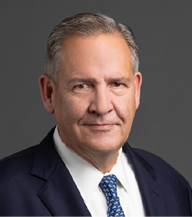












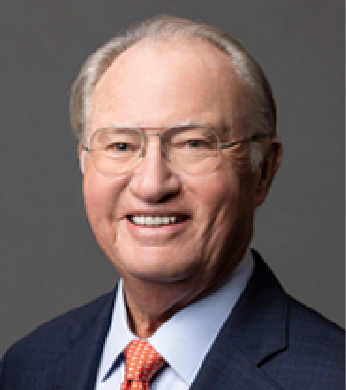





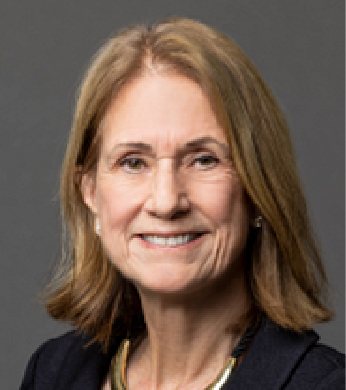











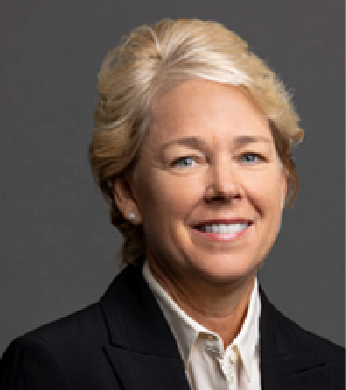







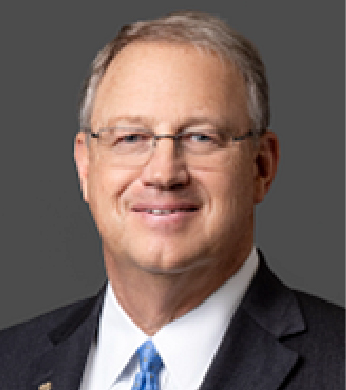

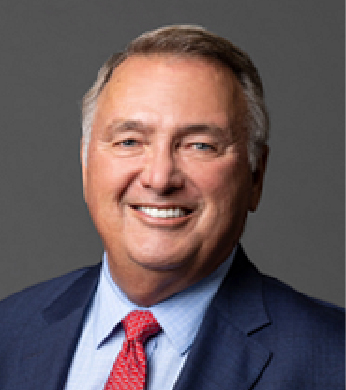
































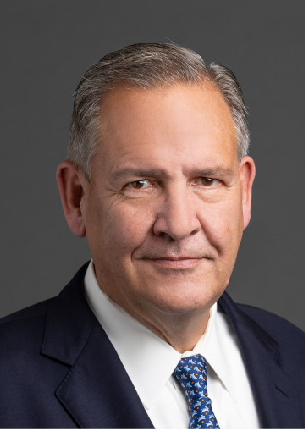















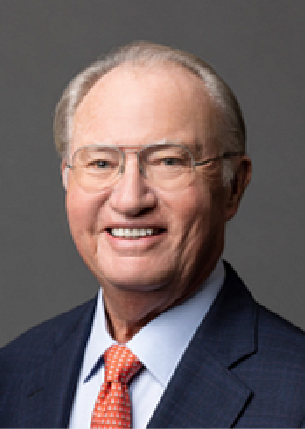












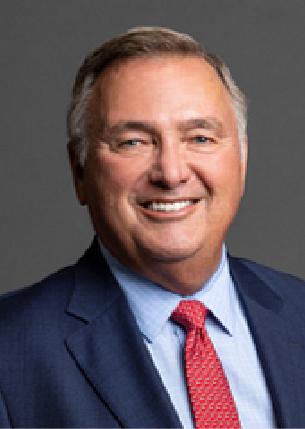











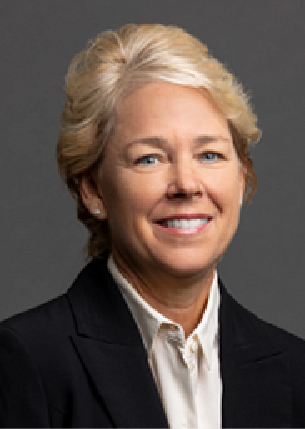


















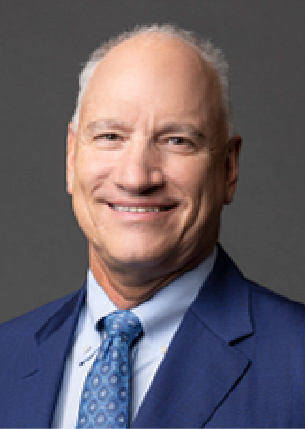











































































































































































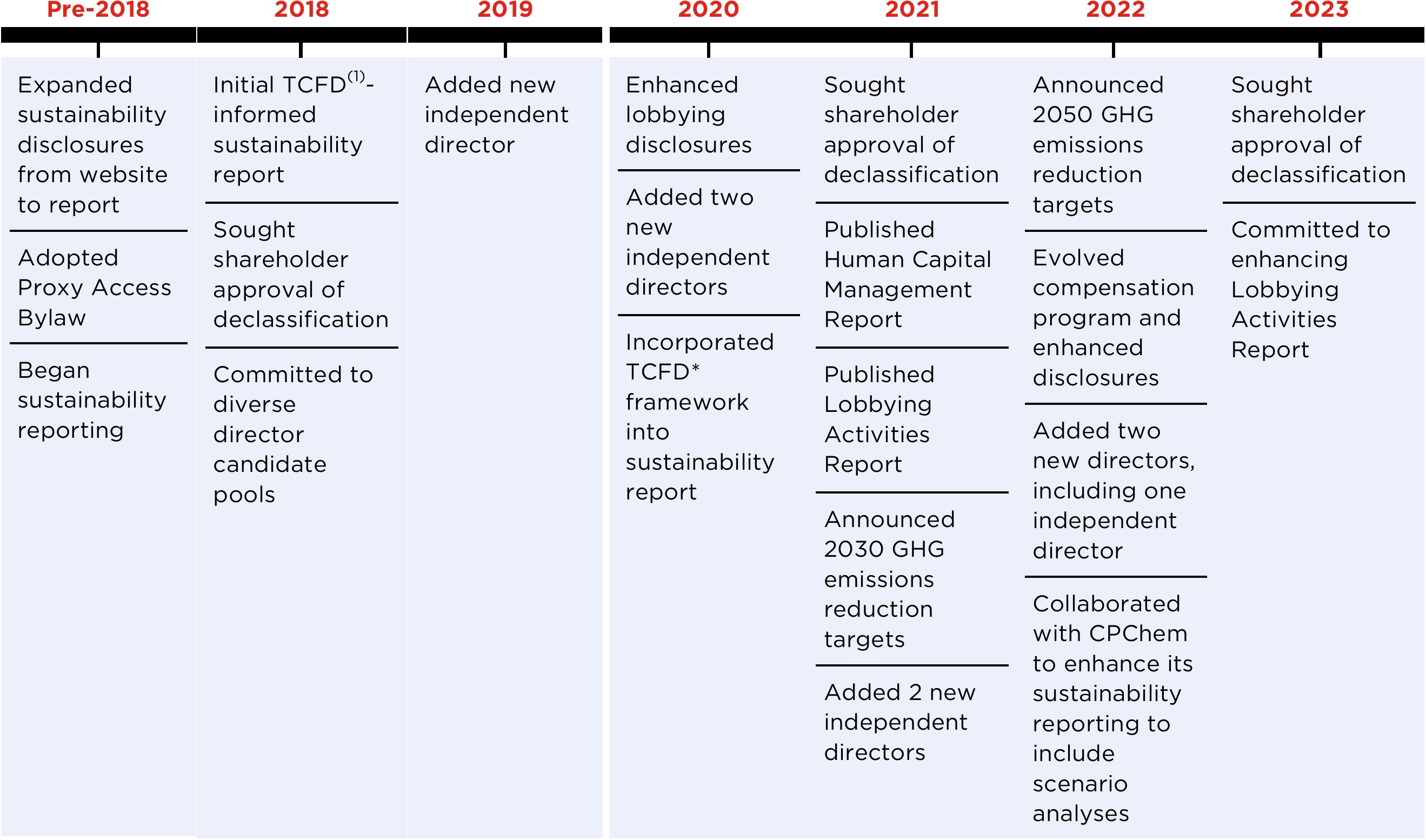
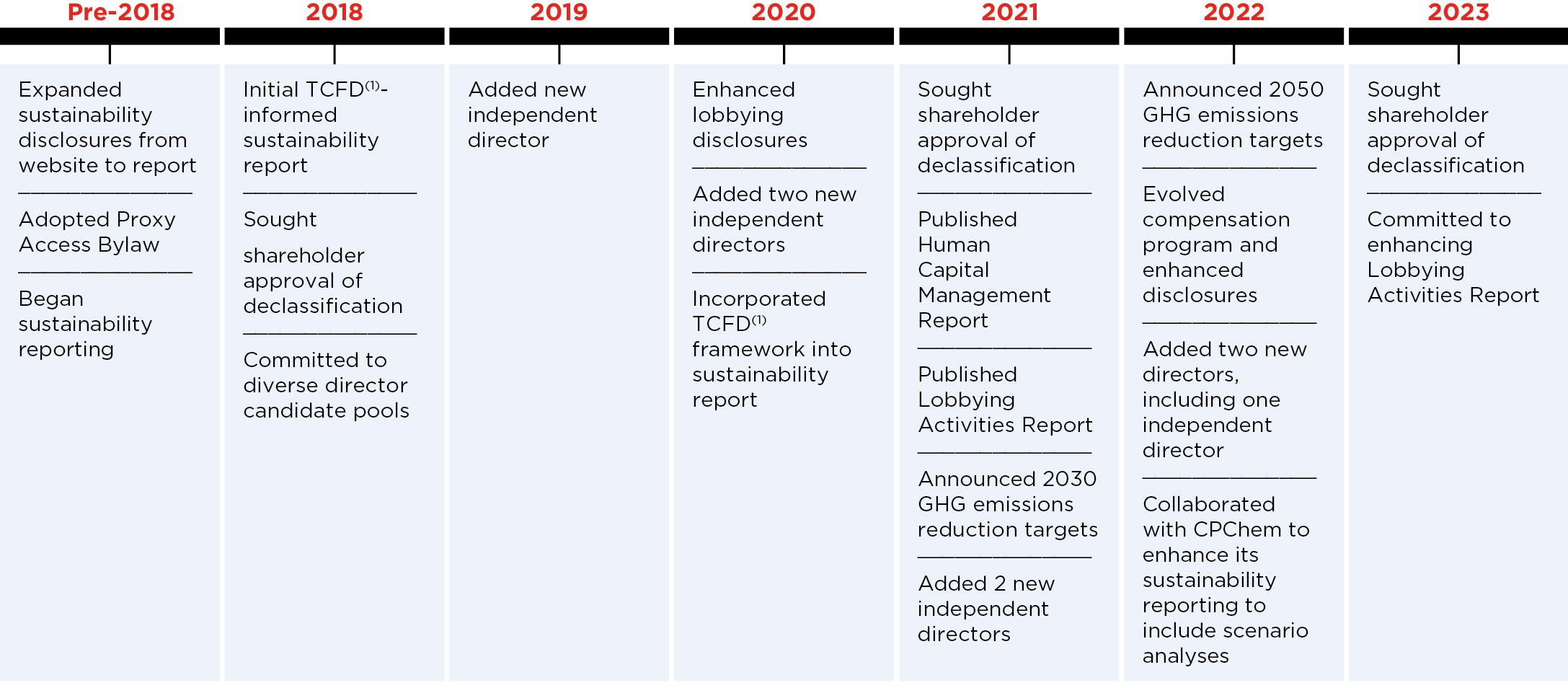

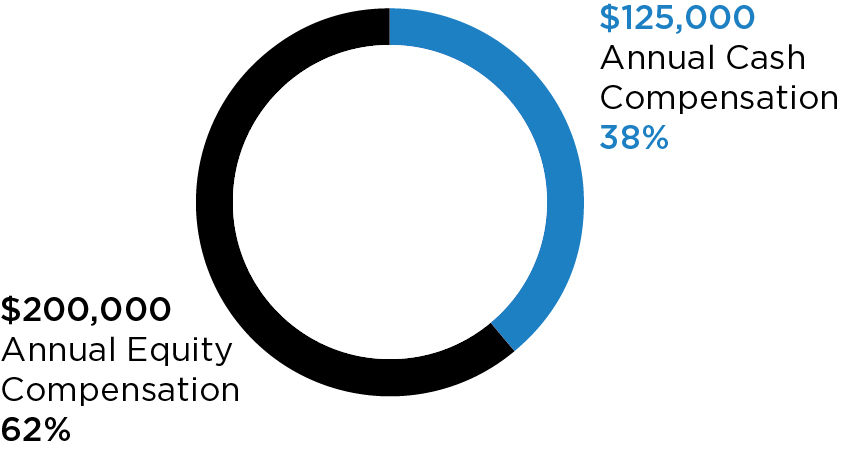

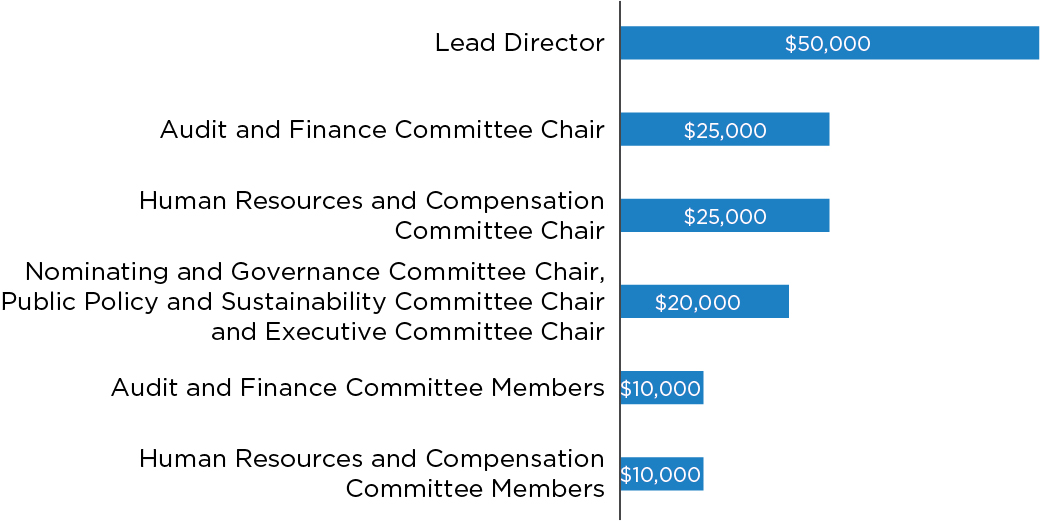



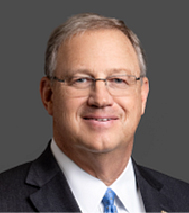


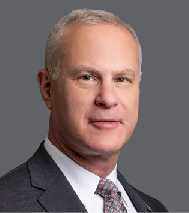
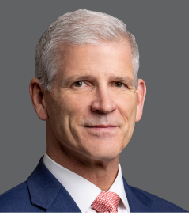




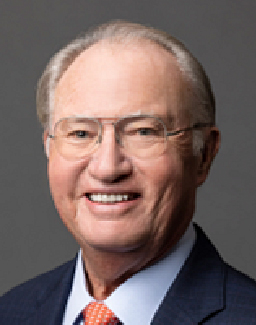













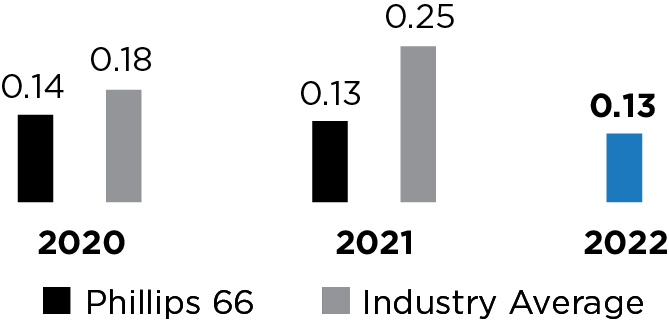
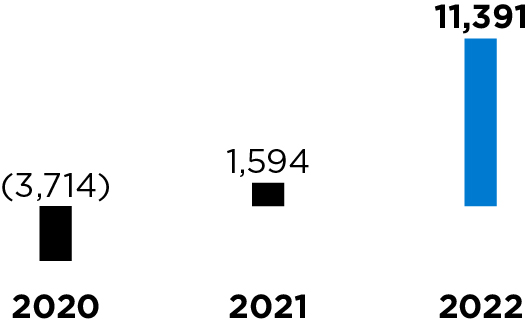
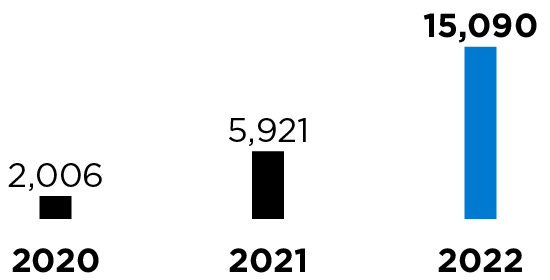










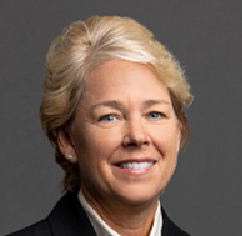













 Based on shareholder input and in order to create more challenging goals, starting with 2022-2024 PSP, we require relative TSR performance above the 50th percentile relative to the peer group to achieve a target payout
Based on shareholder input and in order to create more challenging goals, starting with 2022-2024 PSP, we require relative TSR performance above the 50th percentile relative to the peer group to achieve a target payout For non-GAAP Adjusted PSP ROCE, the threshold achievement level is set at the historical average Adjusted PSP ROCE of 3.5% to cover sustaining capital and dividends
For non-GAAP Adjusted PSP ROCE, the threshold achievement level is set at the historical average Adjusted PSP ROCE of 3.5% to cover sustaining capital and dividends Target and maximum achievement levels for non-GAAP Adjusted PSP ROCE is set at 1.5 and 3.0 percentage points above historical average WACC of 7%
Target and maximum achievement levels for non-GAAP Adjusted PSP ROCE is set at 1.5 and 3.0 percentage points above historical average WACC of 7% The historical average WACC is reviewed on an annual basis by senior management to determine if it needs to be adjusted for current market conditions
The historical average WACC is reviewed on an annual basis by senior management to determine if it needs to be adjusted for current market conditions We narrowed the potential adjustment for target PSP award grants based on individual performance from +/-50% to +/-30%, which aligns with our RSU and Stock Option awards
We narrowed the potential adjustment for target PSP award grants based on individual performance from +/-50% to +/-30%, which aligns with our RSU and Stock Option awards

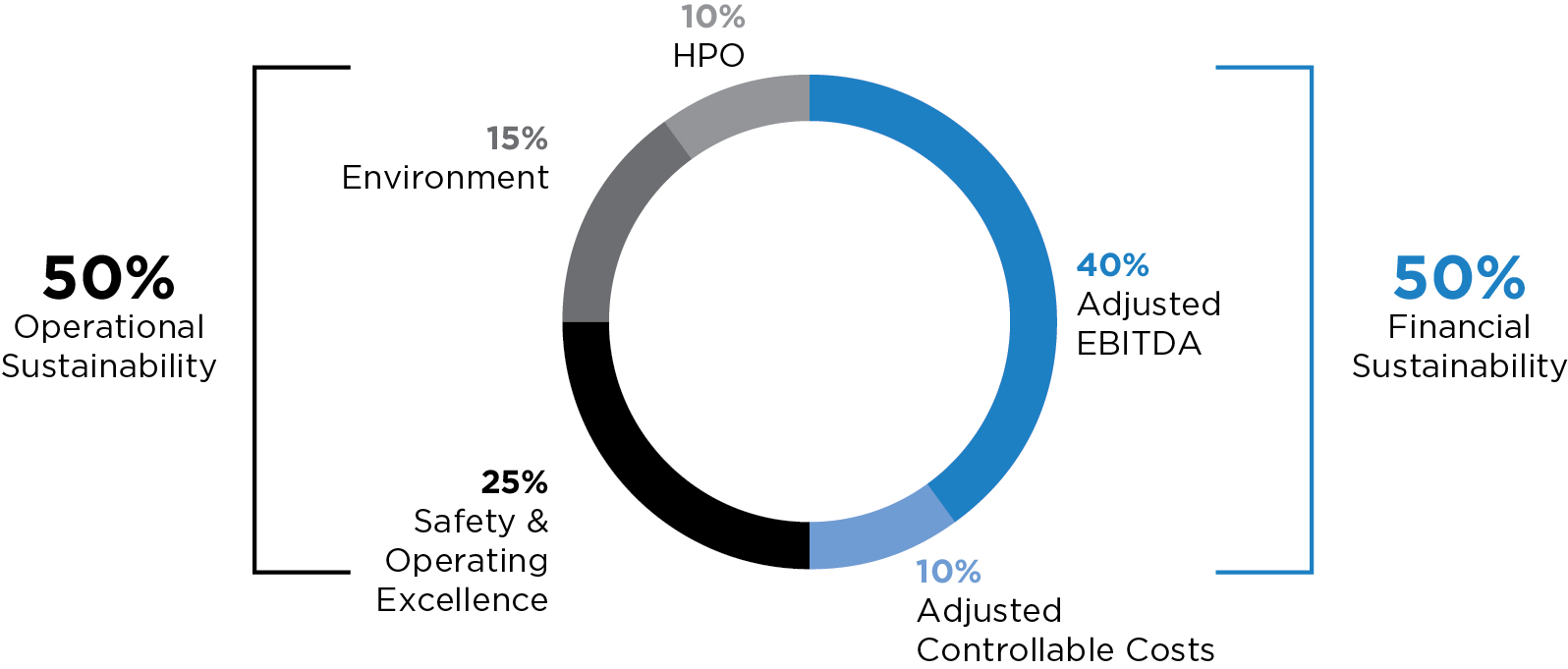


















 We Do…
We Do… We Do Not…
We Do Not… Target the majority of NEO compensation to be performance based and at risk
Target the majority of NEO compensation to be performance based and at risk Apply multiple performance metrics aligned with our corporate strategy
Apply multiple performance metrics aligned with our corporate strategy Cap maximum payouts for VCIP and PSP
Cap maximum payouts for VCIP and PSP Cap payout at 100% on the TSR portion of the PSP if absolute TSR is negative
Cap payout at 100% on the TSR portion of the PSP if absolute TSR is negative Require TSR performance above the 50th percentile relative to peer group to achieve target payout
Require TSR performance above the 50th percentile relative to peer group to achieve target payout Employ a “double trigger” for change in control severance benefits and equity award acceleration
Employ a “double trigger” for change in control severance benefits and equity award acceleration Include absolute and relative metrics in our LTI programs
Include absolute and relative metrics in our LTI programs Maintain robust stock ownership guidelines for executives — CEO and Executive Chairman 6x base salary; other NEOs 3-4x base salary
Maintain robust stock ownership guidelines for executives — CEO and Executive Chairman 6x base salary; other NEOs 3-4x base salary Balance, monitor and manage compensation risk through regular assessments and robust clawback provisions
Balance, monitor and manage compensation risk through regular assessments and robust clawback provisions Have extended vesting periods on stock awards, with a minimum one-year vesting period required for stock and stock option awards
Have extended vesting periods on stock awards, with a minimum one-year vesting period required for stock and stock option awards Maintain a fully independent compensation committee
Maintain a fully independent compensation committee Retain an independent compensation consultant
Retain an independent compensation consultant Hold an annual Say-on-Pay vote and consider shareholder feedback in the design of our compensation program
Hold an annual Say-on-Pay vote and consider shareholder feedback in the design of our compensation program Provide excise tax gross-ups to our NEOs under our CICSP
Provide excise tax gross-ups to our NEOs under our CICSP Reprice stock options without shareholder approval
Reprice stock options without shareholder approval Price stock option exercise prices below grant date fair market value
Price stock option exercise prices below grant date fair market value Allow share recycling for stock options under our equity plan
Allow share recycling for stock options under our equity plan Include evergreen provisions in our active equity plans
Include evergreen provisions in our active equity plans Allow hedging or pledging of Company stock
Allow hedging or pledging of Company stock Pay dividends during the performance period on unearned PSPs
Pay dividends during the performance period on unearned PSPs Allow transfer of equity awards (except in the case of death)
Allow transfer of equity awards (except in the case of death) Provide separate supplemental executive retirement benefits for individual NEOs
Provide separate supplemental executive retirement benefits for individual NEOs Maintain individual change-in-control agreements
Maintain individual change-in-control agreements Have an employment agreement with the CEO
Have an employment agreement with the CEO Provide excessive perquisites
Provide excessive perquisites
